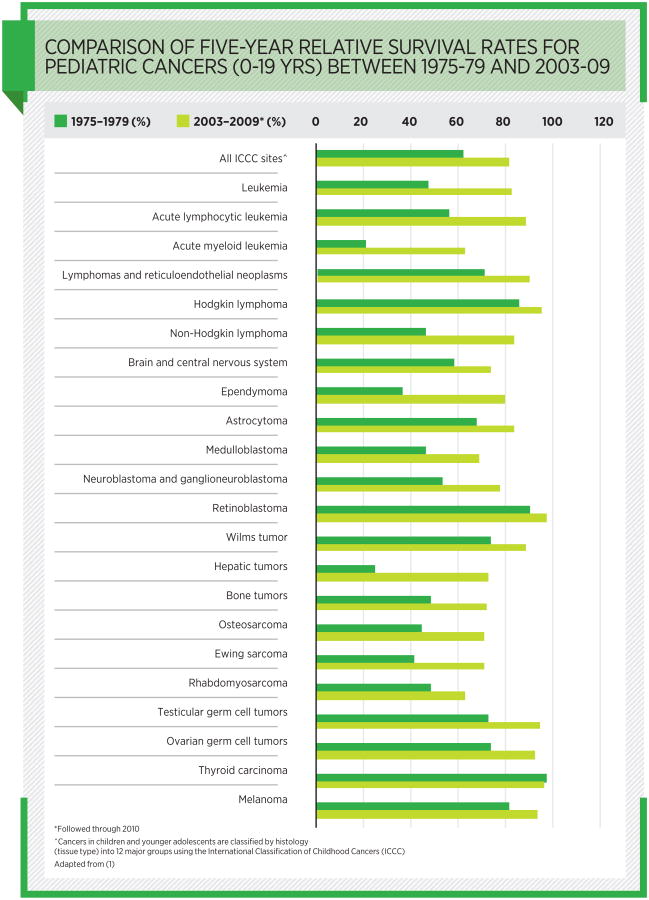A Message From The AACR
On Sept. 20, 2011, the American Association for Cancer Research (AACR) released its inaugural AACR Cancer Progress Report to commemorate the advances in biomedical research that transformed cancer care in the 40 years following the signing of the National Cancer Act of 1971. During this period, biomedical research dramatically increased our understanding of the collection of diseases we call cancer, including the discovery that most cancers are caused by genetic mutations. This laid the foundation for the era of precision medicine, and by Jan. 1, 2011, 20 therapeutics targeting specific molecules involved in cancer had been approved by the U.S. Food and Drug Administration (FDA). Among these therapeutics are some that target cancer-specific molecules, some that target the blood vessel growth that supports tumor development, and some that stimulate a patient's immune system to eliminate their cancer.
As highlighted in the AACR Cancer Progress Report 2015, progress against cancer has continued at a spectacular pace since the start of 2011. In fact, during the five years of publishing the AACR Cancer Progress Report, the number of FDA-approved therapeutics targeting specific molecules involved in cancer more than doubled, reaching 52 therapeutics by July 31, 2015. For some forms of cancer, including melanoma and chronic lymphocytic leukemia, we now have five or more of these new therapeutics, which—as a result of their increased precision—have fewer adverse side effects compared with the traditional treatments that have been the mainstay of cancer care for decades.
This rapid surge in the number of increasingly precise anticancer therapeutics was powered by research, and the cumulative knowledge of the complexities of cancer continues to be the foundation of new advances across the clinical cancer care continuum. Discoveries in the fields of cancer genomics and immunology have been particularly fruitful and have firmly established two new pillars of cancer care: precision therapy and immunotherapy. These exciting fields of research also show immense promise for the future.
Advances in cancer genomics are fueling an expansion in the clinical use of genomic information to make otherwise unexpected treatment decisions for patients with a wide range of cancer types, like the four patients featured in the Transforming Lives One Sequence at a Time section of the AACR Cancer Progress Report 2015 (p. 29). Genomic sequencing of two of these patients' cancers revealed the presence of BRAF gene mutations commonly found in melanoma, and a BRAF-targeted therapeutic approved by the FDA for treating BRAF-mutant melanoma has been transforming the lives of these patients for more than a year.
Precision medicine stories like these are becoming more common because the explosion in our understanding of the biology of cancer is making it increasingly possible to identify the most appropriate therapy for a patient. Our increased knowledge of cancer is also enabling the more precise use of radiotherapy and traditional chemotherapy, as well as cancer prevention strategies tailored for maximal effectiveness.
The dedicated efforts of researchers working throughout the cycle of biomedical research in the United States and around the world are making possible continual progress against cancer. The AACR is encouraged by the fact that 85 percent of American voters recognize that progress is being made against cancer, according to results from a 2015 national survey conducted on behalf of the organization by Hart Research Associates and Public Opinion Strategies. This progress is powering revolutionary advances in cancer care, and the AACR is grateful to the 13 courageous beneficiaries of some of these advances who shared their personal experiences with cancer in the AACR Cancer Progress Report 2015. These stories, coupled with the advances described in the report, inspire great hope for a future in which cancer no longer threatens the lives of millions.
Unfortunately, our ability to fully capitalize on our ever-growing knowledge of cancer is at risk. This is because federal investments in the National Institutes of Health (NIH) and its largest component institute, the National Cancer Institute (NCI), which spur much of the progress made against cancer, have stagnated. Since 2004, the budgets for the NIH and NCI have not kept pace with inflation, resulting in the NIH losing approximately 25 percent of its ability to fund lifesaving biomedical research. On top of these losses due to inflation, direct budget cuts in 2011 and 2013 slashed federal support of the NIH and NCI.
Investments in the federal agencies that are vital for powering progress against cancer also fuel the economy and help the United States to maintain its important position as the global leader in biomedical research. Therefore, reduced federal investments in the NIH and NCI jeopardize not only future lifesaving biomedical research, but also economic development and U.S. leadership in the field.
Executive Summary
Research powers progress against cancer by increasing our understanding of the collection of diseases we call cancer and by allowing us to translate this knowledge into new and increasingly precise ways to prevent, detect, diagnose, treat, and cure some of these diseases.
Much of the research that powers progress against cancer is funded by the U.S. federal government through the National Institutes of Health (NIH), in particular its largest component institute, the National Cancer Institute (NCI). Additionally, federal funding of the U.S. Food and Drug Administration (FDA) helps speed the delivery of safe and effective treatments, such as anticancer therapeutics, to the patients who need them.
As the oldest and largest cancer organization in the world dedicated to advancing every aspect of cancer research, from basic science to translational research to clinical research and population science, the American Association for Cancer Research (AACR) is committed to increasing public understanding of cancer and the importance of cancer research to public health, as well as to advocating for increased federal funding for the NIH, NCI, and FDA. These investments will contribute markedly to the goal of saving more lives from cancer.
The annual AACR Cancer Progress Report to Congress and the American public is a cornerstone of the AACR's educational and advocacy efforts. This fifth edition of the report chronicles how research continues to transform lives, like the lives of the 13 courageous individuals featured in the report who have shared their experiences with cancer.
It also contains a special section showcasing the advances made against cancer in the five years of publishing the report. The progress against cancer highlighted in the report underscores how unwavering, bipartisan support from Congress and the administration, in the form of sustained increases in funding for the NIH, NCI, and FDA, are vital if we are to continue to make progress for the benefit of families everywhere.
Cancer in 2015
Research is the foundation of new and better approaches to cancer prevention, detection, diagnosis, and treatment, which are driving down overall U.S. cancer death rates and increasing the number of people who are living longer, higher-quality lives after a cancer diagnosis.

Even though extraordinary advances have been made, cancer continues to exert an enormous global toll. In 2015 alone, it is estimated that about 8.9 million people worldwide will die from some form of cancer, 589,430 of whom are individuals living in the United States. Moreover, these numbers are projected to increase dramatically in the coming decades if new and better ways to prevent, detect, diagnose, and treat cancer are not developed.
Fueling the anticipated increase in cancer deaths will be a rise in the number of cancer diagnoses, which will, in turn, drive up the costs of cancer. In the United States alone, it is estimated that the direct medical costs of cancer care will rise to $156 billion in 2020, from nearly $125 billion in 2010. When these costs are compared to the total NCI budget for fiscal year 2015, which is just $5 billion, it is clear that research that spurs lifesaving progress against cancer is a wise national investment.

Special Feature on Five Years of Progress Against Cancer
To celebrate the fifth edition of the AACR Cancer Progress Report, a special feature is included that highlights the incredible advances that have been made against cancer in the five years of publishing the report. Discoveries in the fields of cancer genomics and immunology have spurred particular progress, including the rapid expansion of two new pillars of cancer care: precision therapy and immunotherapy.
Information generated by the field of cancer genomics is the foundation of precision therapy, which is revolutionizing the standard of cancer care from a one-size-fits-all approach to one in which the best therapeutic strategy for a patient is determined by an increasingly deep understanding of the patient and his or her tumor. This information is being used not only to expand the repertoire of precision therapeutics, but also to identify additional patients who could benefit from the precision therapeutics that we already have—like the four patients in the Transforming Lives One Sequence at a Time highlight (see p. 29)—and to increase the precision with which traditional chemotherapy and immunotherapy are utilized.
An increased understanding of the role of genetic alterations in developing cancer is also the foundation on which changes are being made in the way that many cancer clinical trials are conducted and regulated. These changes are essential if we are to continue to move precision medicine forward more rapidly than ever before.
Preventing Cancer From Developing
Many cases of cancer could be prevented by eliminating or reducing exposure to factors that increase a person's risk of developing cancer.
Past U.S. public education and policy initiatives have been successful in reducing cancer morbidity and mortality through prevention. However, given that an estimated 50 percent of the 589,430 U.S. cancer deaths expected to occur in 2015 are attributable to preventable causes, it is clear more needs to be done.
Most prominent among the preventable causes of cancer are tobacco use, obesity, lack of physical activity, exposure to ultraviolet light from the sun or tanning devices, and failure to use or comply with interventions that treat or prevent infection with cancer-associated pathogens, such as cancer-causing strains of human papillomavirus (HPV).
Unfortunately, some individuals continue to expose themselves to preventable causes of cancer despite public education and policy initiatives. Moreover, not all cancer risk factors are avoidable. As a result, cancer screening strategies that can identify a precancer or cancer early in development, when it can be more easily and successfully intercepted, are an important part of health care. However, given that each person has his or her own unique risks for developing each type of cancer, everyone should consult with his or her health care practitioners to develop a personalized cancer screening plan.
As we develop and implement new strategies that pair increased molecular understanding of cancer development with knowledge of an individual's unique cancer risk profile, we will move closer to a new era of precision cancer prevention and interception.
Transforming Lives Through Precision Medicine
The dedicated efforts of researchers working throughout the cycle of biomedical research fuel advances across the clinical cancer care continuum that are transforming lives in the United States and worldwide.
As a result of research advances, the FDA approved nine new anticancer therapeutics, one new cancer prevention vaccine, and one new cancer screening test in the 12 months leading up to July 31, 2015. During this time, the FDA also approved new uses for six previously approved anticancer therapeutics and one imaging agent.
Four of the new anticancer therapeutics approved by the FDA target specific molecules involved in cancer and are referred to as molecularly targeted therapeutics. They are part of the precision medicine revolution in cancer care that is transforming the lives of patients like Patty Klein, Janet Klein, and Lori Cuffari (p. 72, 76, and 80, respectively).
Four of the new anticancer therapeutics approved by the FDA are immunotherapeutics that are yielding remarkable and durable patient responses, as illustrated in the report by the experiences of Donna Fernandez, Elizabeth Buell-Fleming, and Sergio Ramirez (p. 86, 90, and 92, respectively). This is the largest number of immunotherapeutics approved in a 12-month period since the first AACR Cancer Progress Report was published in 2011, highlighting how this powerful form of cancer treatment has emerged as a key pillar of cancer care.
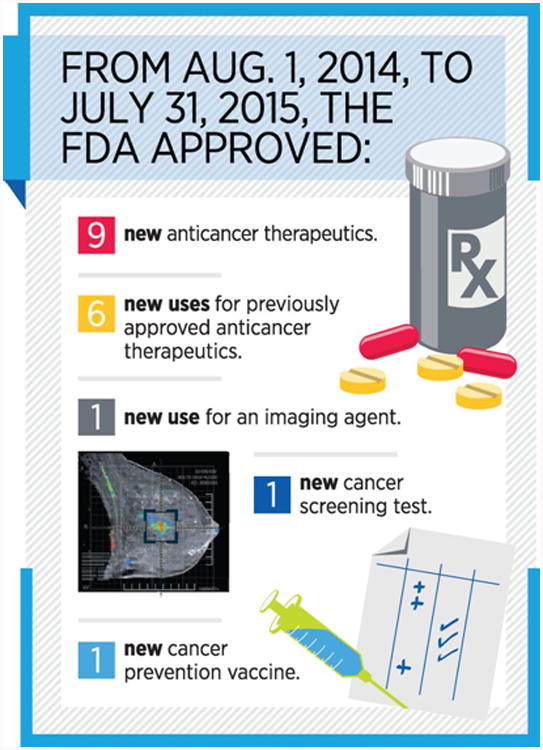
Even though significant progress has been made in precision therapy and immunotherapy for the treatment of cancer, surgery, radiotherapy, and traditional chemotherapy continue to form the foundation of treatment for almost all patients, as they did for Congresswoman Rosa DeLauro and Congressman Tom Marino (p. 66 and 68, respectively). However, the more we learn about the molecular makeup of individual patients and their tumors, the more precisely we will be able to use these treatment strategies so that each patient's treatment is only as aggressive as is necessary for it to be effective.
What Progress Does the Future Hold?
Cancer genomics research is central to the precision medicine revolution that has been improving the lives of an increasing number of patients with cancer, particularly during the past five years. However, many researchers, including AACR President José Baselga, MD, PhD (p. 102), think that the best is yet to come, and that as we look to the future, the pace of progress in precision medicine will continue to accelerate.
Increased deployment of cancer genomics research promises not only to increase the number of potential targets for the development of novel precision anticancer therapeutics, but also to identify markers of response and resistance to all forms of treatment. The power of this information to transform patient care could be dramatically enhanced by pairing knowledge of genetic markers of response and resistance with emerging technologies, often referred to as liquid biopsies.
Building Blocks to Further Precision Medicine
Federal investments in the NIH, NCI, and FDA have powered extraordinary progress against cancer by catalyzing scientific discovery and enabling the translation of discoveries into advances across the continuum of clinical cancer care. Progress in the area of precision medicine has been particularly striking, although there are many challenges to overcome if we are to realize our goal of expanding precision medicine to all forms of cancer prevention, detection, diagnosis, and treatment.
First and foremost, we must continue to increase our understanding of the biology of cancer and to develop new approaches to translating this knowledge into health care advances that will save lives. To do this, we must prioritize and increase federal funding for biomedical research, cancer research, and the FDA. Only by investing in research talent, tools, and infrastructure; supporting regulatory science initiatives; and increasing patient involvement in precision medicine initiatives will we be able to accelerate the pace of progress and realize our goal of preventing and curing cancer.
A Year in Progress
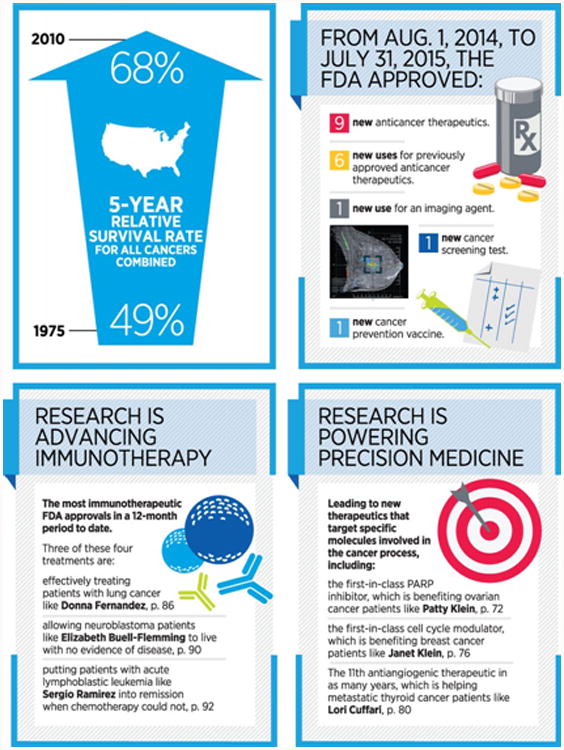
Cancer in 2015
In This Section You Will Learn:
In the United States, Overall Cancer Death Rates are Decreasing and the Number of Survivors is Increasing.
It is Projected that More than 1.65 Million People in the United States will Receive a Cancer Diagnosis, and More than 589,000 will Die from the Disease IN 2015.
It is Predicted that Almost 2.4 Million New Cases of Cancer will be Diagnosed in the United States, and 24 Million will be Diagnosed Globally in 2035.
Not All Segments of the U.S. Population Benefit Equally from Advances Against Cancer.
The Cost of Cancer is Immense, Both in the United States and Globally.
Progress Against Cancer: Powered by Research
Research improves survival and quality of life for millions of individuals around the world by catalyzing the development and implementation of new and better ways to prevent, detect, diagnose, treat, and cure some of the diseases that we call cancer.
It takes many years of hard work by individuals from all segments of the biomedical research community to bring a new medical product from initial research discovery through approval by regulatory agencies and into the clinic (see sidebar on The Biomedical Research Community, p. 9). Among the new medical products approved by the U.S. Food and Drug Administration (FDA) between Aug. 1, 2014, and July 31, 2015, were nine new anticancer therapeutics, one new cancer prevention vaccine, and one new cancer screening test (see Table 1, p. 10). During this period, the FDA also approved new uses for six previously approved anticancer therapeutics and one imaging agent.
Table 1. Newly FDA-Approved Medical Products for the Prevention, Treatment, and Imaging of Cancer: Aug. 1, 2014-July 31, 2015.
| ANGIOGENESIS INHIBITORS | |||
| Approved Indication | Generic Name | Trade Name | Formulation |
| certain forms of cervical, ovarian, fallopian tube, and peritoneal cancers* | bevacizumab | Avastin |

|
| certain type of thyroid cancer | lenvatinib | Lenvima |

|
| certain forms of colorectal and lung cancers* | ramucirumab | Cyramza |

|
| BONE REMODELING INHIBITORS | |||
| Approved Indication | Generic Name | Trade Name | Formulation |
| potentially lethal complication of advanced cancers* | denosumab | Xgeva |

|
| CELL SIGNALING INHIBITORS | |||
| Approved Indication | Generic Name | Trade Name | Formulation |
| certain type of lung cancer* | gefitinib** | Iressa |

|
| certain type of non-Hodgkin lymphoma* | ibrutinib† | Imbruvica |

|
| certain type of breast cancer | palbociclib†∧ | Ibrance |

|
| most common type of skin cancer | sonidegib | Odomzo |

|
| DNA REPAIR INHIBITOR | |||
| Approved Indication | Generic Name | Trade Name | Formulation |
| certain type of ovarian cancer | olaparib**∧ | Lynparza |

|
| EPIGENOME-MODIFYING AGENTS | |||
| Approved Indication | Generic Name | Trade Name | Formulation |
| multiple myeloma | panobinostat | Farydak |

|
| IMMUNOTHERAPEUTICS | |||
| Approved Indication | Generic Name | Trade Name | Formulation |
| certain type of leukemia | blinatumomab†∧ | Blincyto |

|
| neuroblastoma | dinutuximab | Unituxin |

|
| melanoma, certain type of lung cancer | nivolumab† | Opdivo |

|
| melanoma | pembrolizumab† | Keytruda |

|
| IMAGING AGENTS | |||
| Approved Indication | Generic Name | Trade Name | Formulation |
| lymphatic mapping in solid tumors* | technetium 99m tilmanocept | Lymphoseek |

|
| CANCER SCREENING TESTS | |||
| Approved Indication | Generic Name | Trade Name | Formulation |
| colorectal cancer | none | Cologuard |

|
| PREVENTIVE VACCINES | |||
| Approved Indication | Generic Name | Trade Name | Formulation |
| cervical, vulvar, vaginal, and anal cancers | human papillomavirus 9-valent vaccine (types 6, 11, 16, 18, 31, 33, 45, 52, and 58) | Gardasil 9 |

|
new indication for 2014–2015
approved with a companion diagnostic
breakthrough therapy
first in class
Where drugs have multiple trade names are used, only the most common have been listed
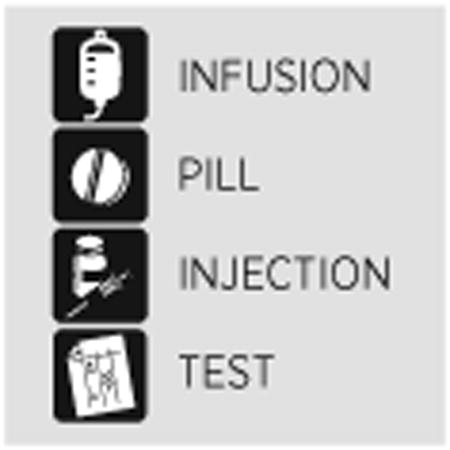
Advances such as those listed in Table 1 (p. 10) help ensure that, year after year, overall U.S. cancer death rates continue to decrease (2) and that the number of people who survive their cancer continues to rise. In fact, in the United States alone, the percentage of the population living with, through, or beyond a cancer diagnosis has more than tripled since 1971 (3-5).
The significant progress that has been and continues to be made against cancer is the result of investments from governments, philanthropic individuals and organizations, and the private sector the world over. In the United States, federal investments in biomedical research, cancer research, and the FDA are of particular importance. The majority of U.S. federal investments in biomedical research are administered through the 27 component institutes and centers of the National Institutes of Health (NIH), the largest of which is the National Cancer Institute (NCI) (see sidebar on The National Institutes of Health by the Numbers, p. 11). Continued progress against cancer requires robust, sustained, and predictable growth in funding of lifesaving biomedical research from all sources.

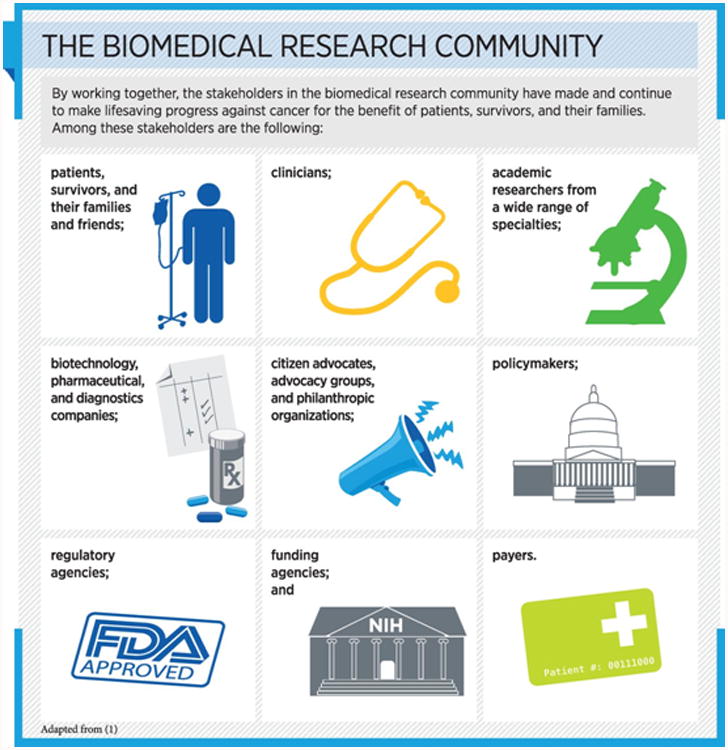
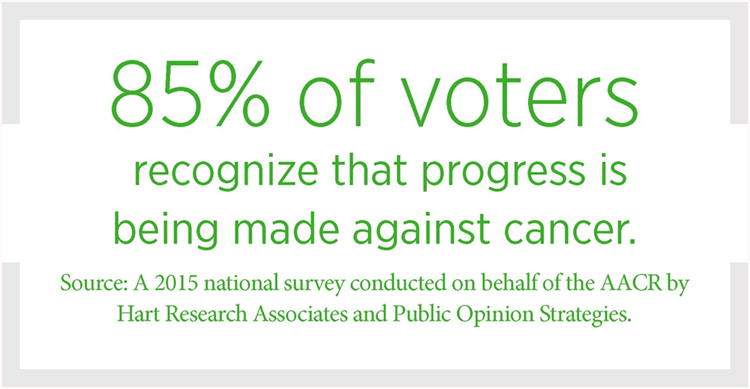
Cancer: An Ongoing Challenge
We have made tremendous progress against cancer—for example, the U.S. five-year relative survival rate for all cancers combined increased from 49 percent in the mid-1970s to 68 percent in 2010 (6). In spite of this progress, this collection of diseases continues to exert a devastating toll on the global population. In fact, it is predicted that about 8.9 million people worldwide will die from some form of cancer in 2015 (7), 589,430 of these individuals in the United States (6) (see Table 2, p. 12).
Table 2. Estimated Incidence and Mortality for Select Cancers.
| ESTIMATED 2015 INCIDENCE | ESTIMATED 2015 DEATHS | |||||
|---|---|---|---|---|---|---|
| Total | Male | Female | Total | Male | Female | |
| ALL SITES | 1,658,370 | 848,200 | 810,170 | 589,430 | 312,150 | 277,280 |
| HEAD AND NECK REGION | ||||||
| Brain & other nervous system | 22,850 | 12,900 | 9,950 | 15,320 | 8,940 | 6,380 |
| Oral cavity & pharynx | 45,780 | 32,670 | 13,110 | 8,650 | 6,010 | 2,640 |
| Tongue | 14,320 | 10,310 | 4,010 | 2,190 | 1,500 | 690 |
| Mouth | 12,920 | 7,750 | 5,170 | 2,120 | 1,200 | 920 |
| Pharynx | 15,520 | 12,380 | 3,140 | 2,660 | 2,010 | 650 |
| Larynx | 13,560 | 10,720 | 2,840 | 3,640 | 2,890 | 750 |
| Lung & bronchus | 221,200 | 115,610 | 105,590 | 158,040 | 86,380 | 71,660 |
| Breast | 234,190 | 2,350 | 231,840 | 40,730 | 440 | 40,290 |
| GASTROINTESTINAL SYSTEM | ||||||
| Esophagus | 16,980 | 13,570 | 3,410 | 15,590 | 12,600 | 2,990 |
| Stomach | 24,590 | 15,540 | 9,050 | 10,720 | 6,500 | 4,220 |
| Liver & intrahepatic bile duct | 35,660 | 25,510 | 10,150 | 24,550 | 17,030 | 7,520 |
| Gallbladder & other biliary | 10,910 | 4,990 | 5,920 | 3,700 | 1,660 | 2,040 |
| Pancreas | 48,960 | 24,840 | 24,120 | 40,560 | 20,710 | 19,850 |
| Small intestine | 9,410 | 4,960 | 4,450 | 1,260 | 670 | 590 |
| Colon and rectum† | 93,090 | 45,890 | 47,200 | 49,700 | 26,100 | 23,600 |
| UROGENITAL SYSTEM | ||||||
| Kidney & renal pelvis | 61,560 | 38,270 | 23,290 | 14,080 | 9,070 | 5,010 |
| Ovary | 21,290 | 21,290 | 14,180 | 14,180 | ||
| Uterine corpus | 54,870 | 54,870 | 10,170 | 10,170 | ||
| Uterine cervix | 12,900 | 12,900 | 4,100 | 4,100 | ||
| Urinary bladder | 74,000 | 56,320 | 17,680 | 16,000 | 11,510 | 4,490 |
| Prostate | 220,800 | 220,800 | 27,540 | 27,540 | ||
| Testis | 8,430 | 8,430 | 380 | 380 | ||
| SKIN | ||||||
| Skin (excluding basal & squamous) | 80,100 | 46,610 | 33,490 | 13,340 | 9,120 | 4,220 |
| Melanoma | 73,870 | 42,670 | 31,200 | 9,940 | 6,640 | 3,300 |
| HEMATOLOGICAL SYSTEM | ||||||
| Leukemia | 54,270 | 30,900 | 23,370 | 24,450 | 14,210 | 10,240 |
| Acute lymphocytic leukemia | 6,250 | 3,100 | 3,150 | 1,450 | 800 | 650 |
| Chronic lymphocytic leukemia | 14,620 | 8,140 | 6,480 | 4,650 | 2,830 | 1,820 |
| Acute myeloid leukemia | 20,830 | 12,730 | 8,100 | 10,460 | 6,110 | 4,350 |
| Chronic myeloid leukemia | 6,660 | 3,530 | 3,130 | 1,140 | 590 | 550 |
| Lymphoma | 80,900 | 44,950 | 35,950 | 20,940 | 12,140 | 8,800 |
| Hodgkin lymphoma | 9,050 | 5,100 | 3,950 | 1,150 | 660 | 490 |
| Non-Hodgkin lymphoma | 71,850 | 39,850 | 32,000 | 19,790 | 11,480 | 8,310 |
| Myeloma | 26,850 | 14,090 | 12,760 | 11,240 | 6,240 | 5,000 |
| OTHER CANCERS | ||||||
| Bones & joints | 2,970 | 1,640 | 1,330 | 1,490 | 850 | 640 |
| Soft tissue (including heart) | 11,930 | 6,610 | 5,320 | 4,870 | 2,600 | 2,270 |
Rounded to the nearest 10; estimated new cases exclude basal cell and squamous cell skin cancers and in situ carcinomas except urinary bladder. About 60,290 carcinoma in situ of the female breast and 63,440 melanoma in situ will be newly diagnosed in 2015.
Estimated deaths for colon and rectal cancers are combined.
More deaths than cases may reflect lack of specificity in recording underlying cause of death on death certificates and/or an undercount in the case estimate.
Source: Estimated new cases are based on cancer incidence rates from 49 states and the District of Columbia during 1995-2011 as reported by the North American Association of Central Cancer Registries (NAACCR), representing about 98% of the US population. Estimated deaths are based on U.S. mortality data during 1997-2011, National Center for Health Statistics, Centers for Disease Control and Prevention.
One of the reasons that cancer continues to be an enormous public health challenge is that advances have not been uniform for all types of cancer (see Table 3, p. 14). For example, although death rates for most types of cancer have been declining in the United States since the early 1990s, those for adults diagnosed with liver or pancreatic cancer rose 2.5 percent and 0.3 percent per year, respectively, from 2007 to 2011 (6). Overall five-year relative survival rates for U.S. adults with these two types of cancer are also very low, at 17 percent for liver cancer and 7 percent for pancreatic cancer, in stark contrast to the overall five-year relative survival rates for women with invasive breast cancer and men with prostate cancer, which are 89 percent and almost 100 percent, respectively (6).
Table 3.
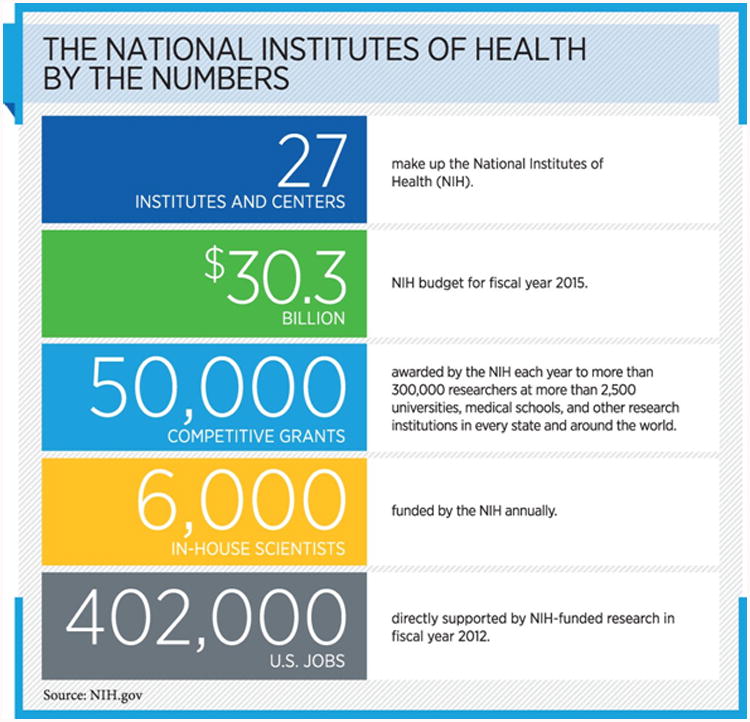
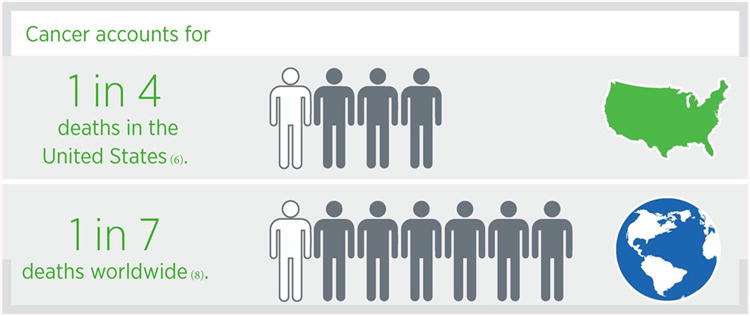
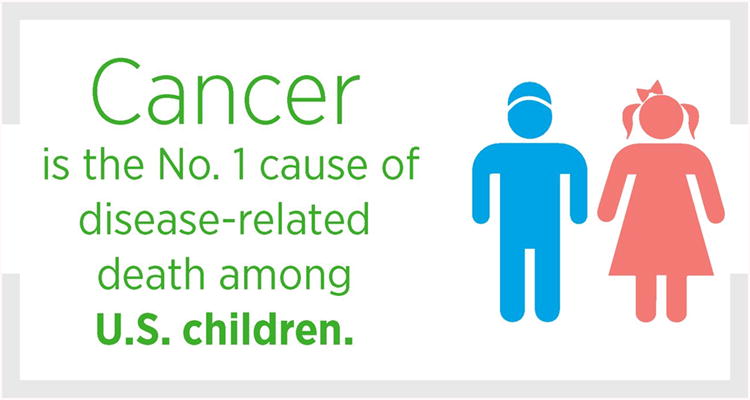
Another reason that cancer continues to be a challenge is that advances have not been uniform for all patients with a given type of cancer. Five-year relative survival rates vary not only with stage at diagnosis, but also among different segments of the population (see sidebar on Cancer Health Disparities in the United States, p. 15).
The reality is that cancer will continue to pose challenges for researchers, clinicians, and patients in the coming decades unless more effective strategies for cancer prevention, early detection, and treatment are developed. Given that cancer is primarily a disease of aging (12), and that the portion of the U.S. population age 65 and older is expected to double in size by 2060 (13), it is anticipated that the number of new cancer cases diagnosed each year in the United States will increase dramatically (7). In fact, it is estimated that in 2035, there will be almost 2.4 million new cases of cancer diagnosed in the United States. Also contributing to the projected increase are the continued use of cigarettes by 18 percent of U.S. adults (14) and high rates of obesity and physical inactivity, both of which are linked to an increased risk for several types of cancer (15, 16).
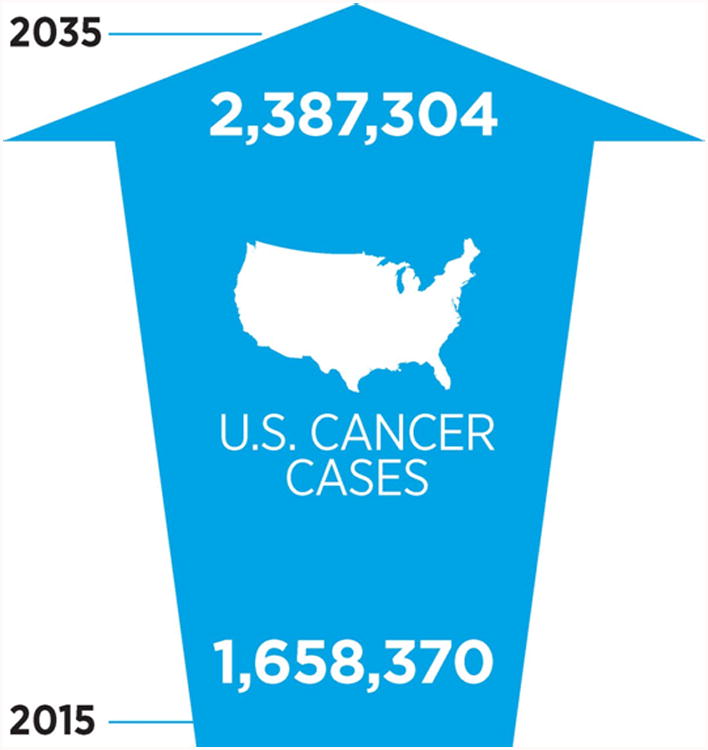
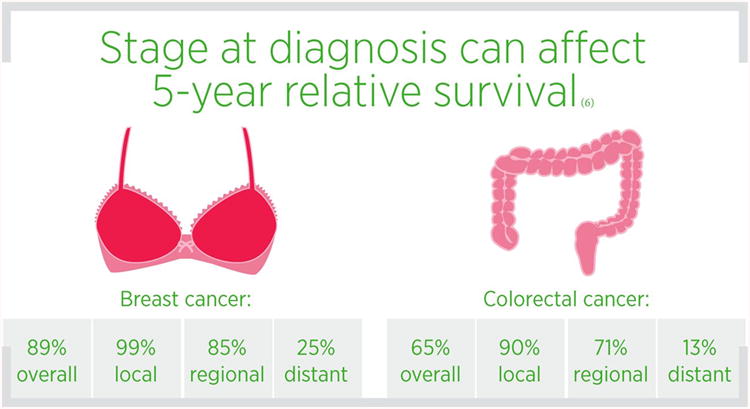
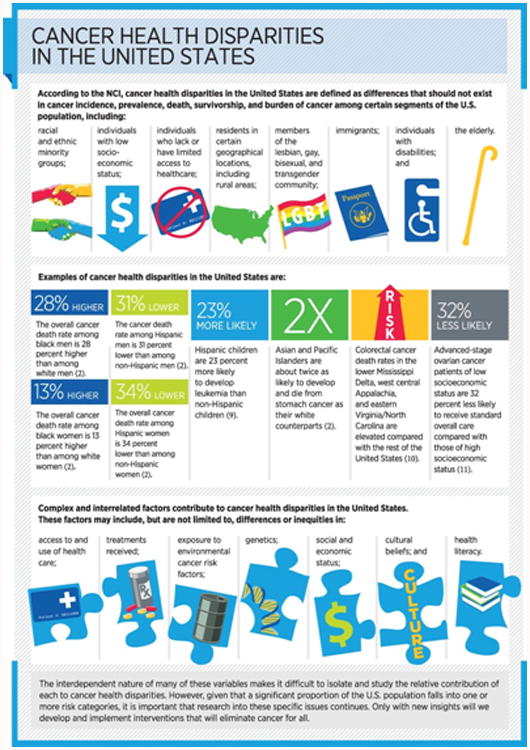
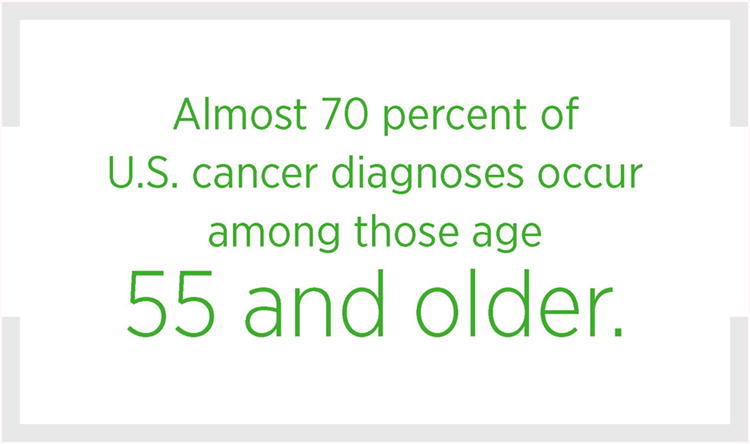
A rise in the number of U.S. cancer cases will lead directly to an increase in the number of cancer deaths, and in the near future cancer is expected to overtake heart disease as the country's leading cause of death (17).
These challenges are not unique to the United States; they are also global problems (see sidebar on Cancer: A Global Challenge). Thus, it is imperative that the global biomedical research community collaborates to address cancer incidence and mortality, and spur continued advances against cancer.
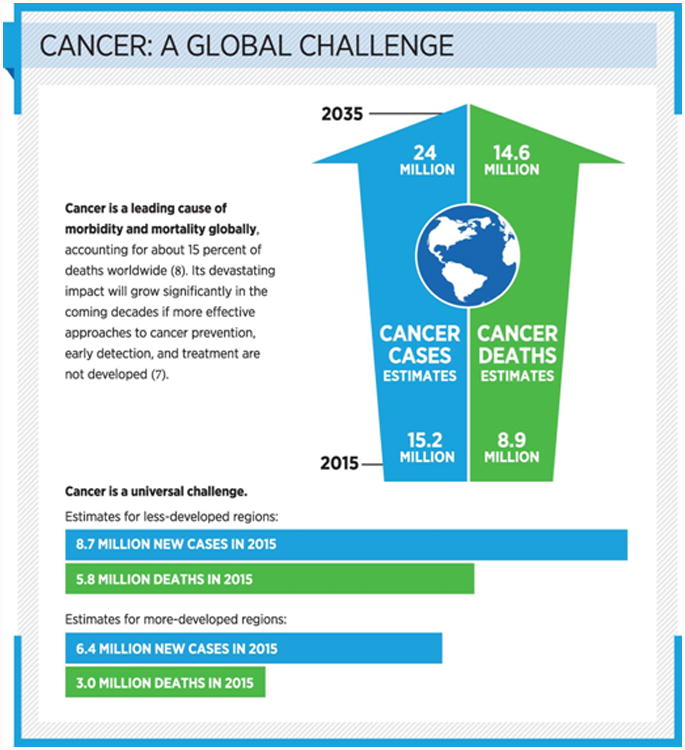
Cancer: A Costly Disease. Research: A Vital Investment
Cancer exerts an immense global toll not only through the number of lives it affects each year, but also as a result of its substantial economic impact. It is estimated that the 13.3 million cases of cancer diagnosed worldwide in 2010 cost $290 billion in that year alone (18) (see Figure 1). With the number of cancer cases projected to rise dramatically in the next few decades, so too will the costs. In fact, it is estimated that the 21.5 million new cases of cancer projected to be diagnosed in 2030 will cost $458 billion (18).
Figure 1.
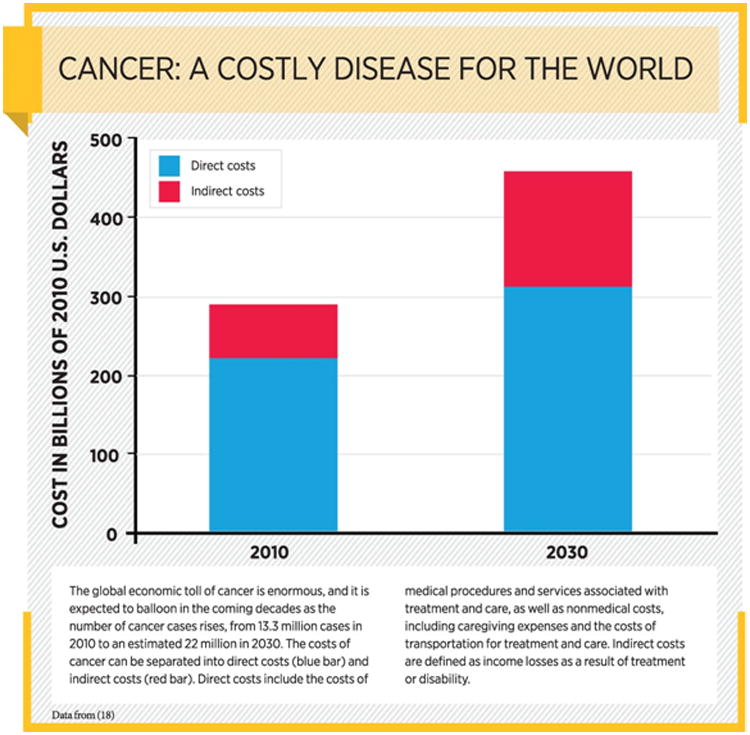
In the United States alone, it is estimated that the direct medical costs of cancer care in 2010 were nearly $125 billion, and that these costs will likely rise to $156 billion in 2020 (19). These costs stand in stark contrast to the NIH budget for fiscal year (FY) 2015, which is $30.3 billion.
Given the increasing economic and personal burden of cancer, it is clear that more research is required if we are to continue to make new advances against cancer. In the United States, most biomedical research, as well as the federal regulatory agency that assures the safety and efficacy of advances—the FDA—is supported by funds from the federal government. Therefore, it is imperative that Congress and the administration increase investments in the federal agencies that are vital for fueling progress against cancer, in particular the NIH, NCI, and FDA.
Developing Cancer
In this Section You will Learn:
Cancer is not One Disease; it is a Collection of Many Diseases Characterized by the Uncontrolled Growth of Cells.
Changes in the Genetic Material in a Normal Cell Underpin Cancer Initiation and Development in Most Cases.
A Cancer Cell's Surroundings Influence the Development and Progression of Disease.
The Most Advanced Stage of Cancer, Metastatic Disease, Accounts for More than 90 Percent of Cancer Deaths.
The More We Know About The Biology Of Cancer, The More Precisely We Can Prevent, Detect, Diagnose, And Treat It.
Cancer is not one disease; it is a collection of many diseases that arise when the processes that control the multiplication and life span of normal cells go awry.
As humans develop, we grow, through extensive cell multiplication, from a single cell to an estimated 37.2 trillion cells in an adult body (20). When a person matures, the pace of cell multiplication slows. In adults, normal cells primarily multiply only to replace cells that die either due to exposure to a variety of external factors or naturally as a result of normal cellular wear and tear, which is related to the number of times the cell has multiplied.
When the processes that control the multiplication and life span of normal cells go awry, the cells start multiplying uncontrollably, fail to die when they should, and begin to accumulate. In body organs and tissues, these cancerous cells form a tumor mass, and in the blood or bone marrow, they crowd out the normal cells.
Without medical intervention, over time, some cancerous cells gain the ability to invade local tissues, and some spread, or metastasize, to distant sites. The progression of a cancer to metastatic disease is the cause of most cancer-related deaths.
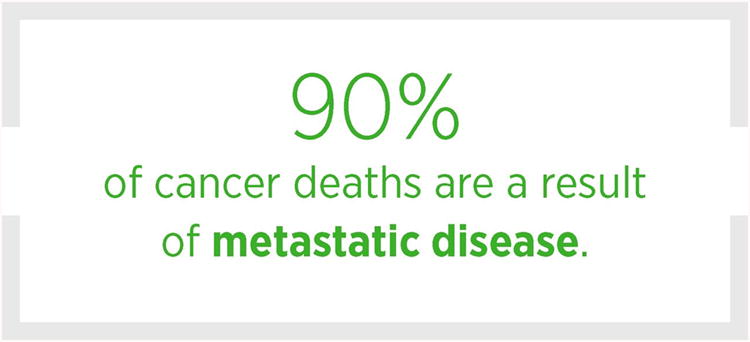
Changes, or mutations, in the genetic material of cells are the primary cause of cancer initiation and development. Not all mutations contribute to cancer development, but the greater the chance that a cell will acquire a mutation, the greater the chance that the cell will acquire a mutation that will cause cancer. The identity, order, and speed at which a cell acquires genetic mutations determine the length of time it takes for a cancer to develop and are influenced by numerous interrelated factors (see sidebar on Why Me? Why This Cancer? p. 19).
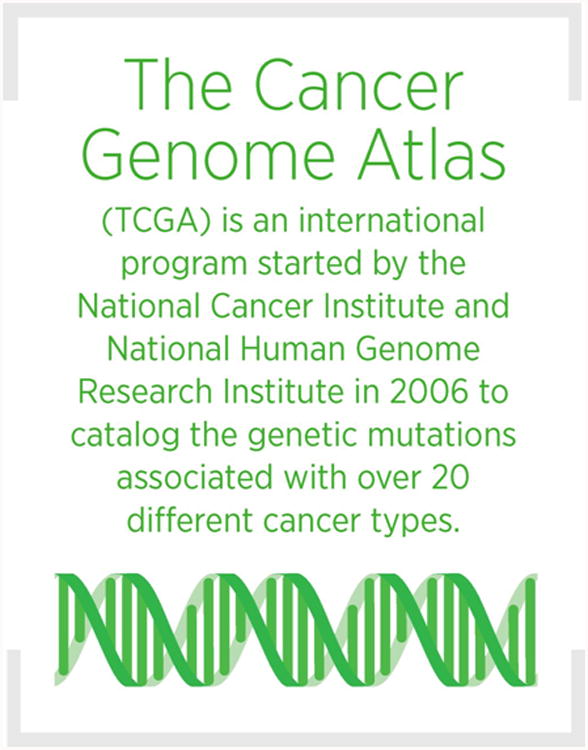
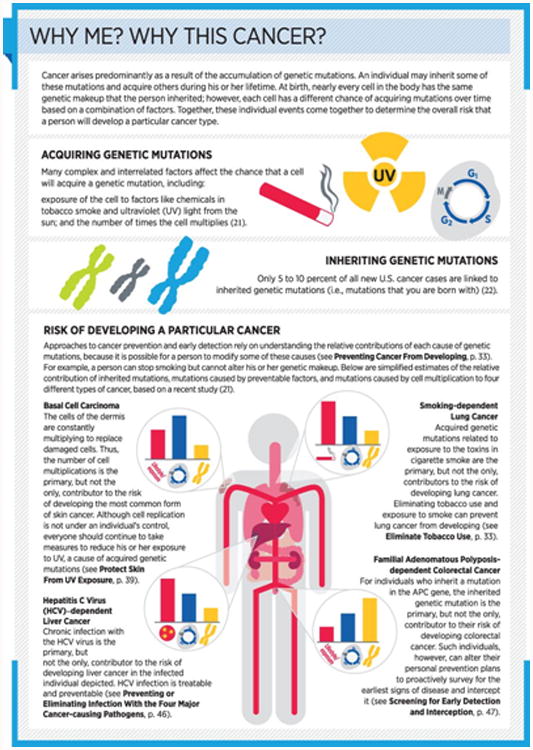
Cancer Development: Influences Inside the Cell
Cancer develops largely as a result of the accumulation of mutations in the genetic material inside a cell (see sidebar on Genetic and Epigenetic Control of Cell Function). A mutation is a change in the type or order of the four deoxyribonucleic acid (DNA) units, called bases, that make up the genetic material of a cell. The sequence of DNA bases determines what proteins are produced by a cell and how much of each protein is produced, thereby defining cellular function. Many different types of mutation can lead to cancer, largely by altering the amount or function of certain proteins (see sidebar on Genetic Mutations, p. 21), although it is important to note that not all mutations result in cancer.
Most cancer cells have not only numerous genetic mutations, but also profound abnormalities in their epigenomes when compared with normal cells of the same tissue. In many cases, epigenetic alterations and genetic mutations work in conjunction to promote cancer development. Of immense therapeutic interest is the discovery that although genetic mutations are permanent, some epigenetic abnormalities may be reversible. In fact, the FDA has already approved six therapeutics that cause changes in the epigenome (see Targeting the Epigenome, p. 82).
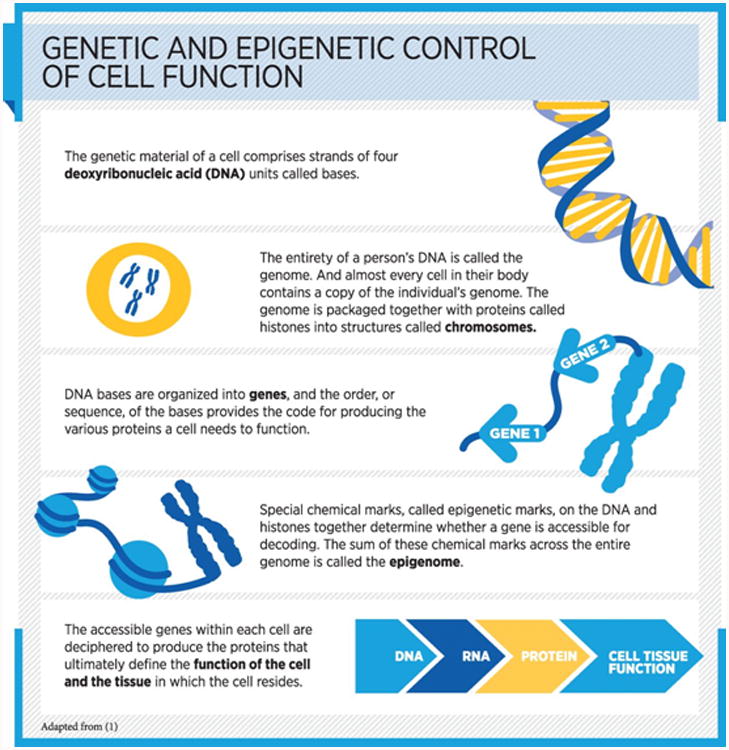
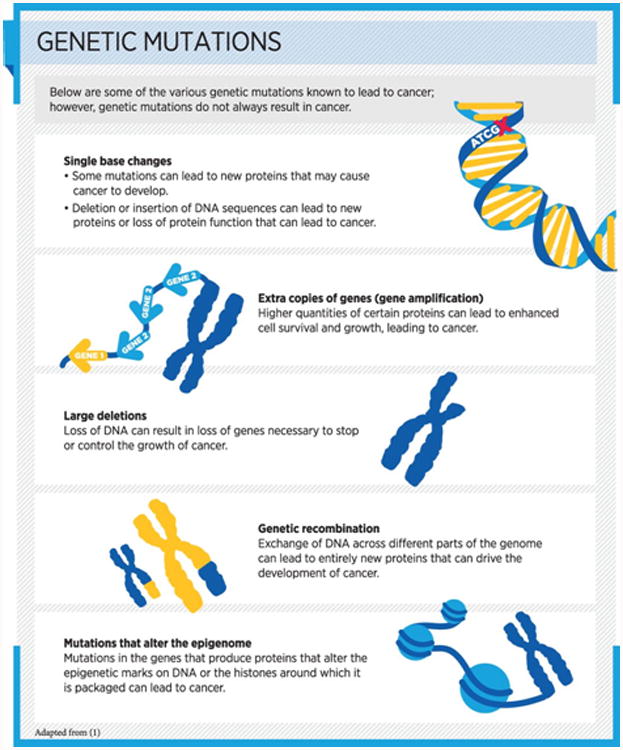
Cancer Development: Influences Outside the Cell
Genetic mutations underpin cancer initiation and development in most cases. However, interactions between cancer cells and their environment—known as the tumor microenvironment—as well as interactions with systemic factors, also play an important role in cancer development (see sidebar on Cancer Growth: Local and Global Influences, p. 22). Therefore, developing a more comprehensive, whole-patient understanding of cancer has the potential to provide novel approaches to cancer prevention and treatment.
Cancer Development: Exploiting Our Expanding Knowledge to Improve Health Care
Research has significantly increased our knowledge of the processes by which cancer starts, progresses, and results in disease. It also has expanded our ability to exploit this knowledge to develop new and better approaches to cancer prevention, detection, diagnosis, and treatment. Most of the new treatments are more precise than traditional therapies, providing patients with not just longer, but also higher-quality lives, and researchers are beginning to use the same precision strategy to develop new cancer prevention and interception interventions (see Special Feature on Five Years of Progress Against Cancer, p.23).
In the United States, the research that fuels advances against cancer is largely supported by the NIH and NCI. Given that continued progress will be made only through additional research, it is vital that the administration and Congress increase investments in the NIH and NCI, as well as the FDA, which assures the safety and efficacy of advances.
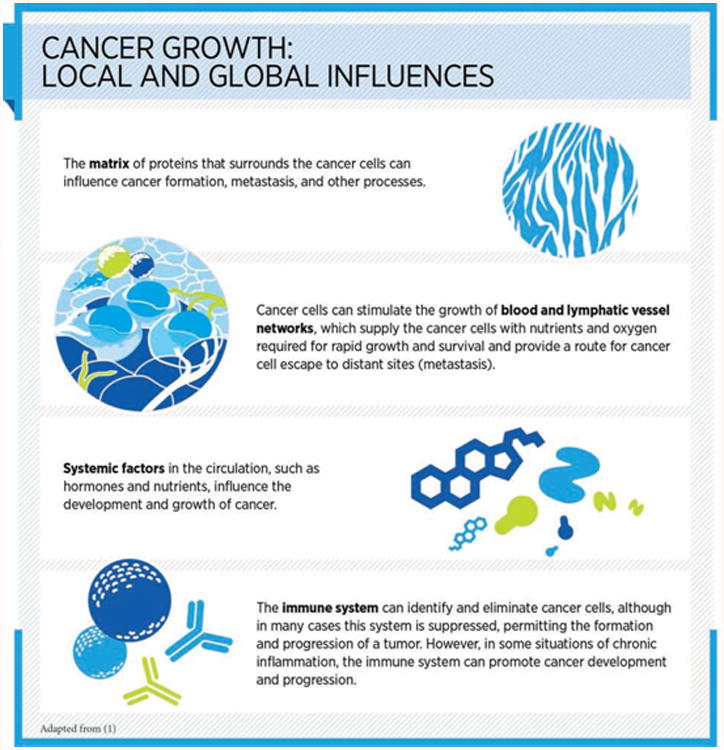
Special Feature on Five Years of Progress Against Cancer
In This Section You Will Learn:
Oncology is Leading Precision Medicine Efforts and Transforming Lives.
Genomics is the Foundation on Which Precision Medicine in Oncology is Built.
In the Past Five Years, Molecularly Targeted Therapeutics and Immunotherapeutics have Become Part of Routine Care for Patients with Several Types of Cancer.
Big Data Show Promise for Increasing the Number of Precision Therapeutics in Our Toolkit.
Genomically Informed Clinical Trial Designs are Essential for Moving Precision Medicine Forward as Quickly as Possible.
To celebrate the fifth edition of the AACR Cancer Progress Report, included here is a special feature in which we highlight advances that have been made against cancer in the five years of publishing the report.
The year 2011 marked the 40th anniversary of the signing of the National Cancer Act of 1971, which focused the nation's efforts and attention on the fight against cancer. Much changed between 1971 and 2011, and the AACR commemorated the amazing advances in cancer research made during that time with the publication of its inaugural AACR Cancer Progress Report.
In the four decades after 1971, we went from the concept that cancer is a single disease caused by viruses to the understanding that cancer is a vast collection of diseases, some of which are indeed caused by chronic infection with certain viruses, united by overgrowth of cells (see Prevent Infection With Cancer-causing Pathogens, p. 46). More important, however, was the discovery that cancer arises from a myriad of genetic changes within cells that accumulate with time (see Developing Cancer, p. 18).
That discovery, coupled with advances in biology, chemistry, physics, and technology, set the stage for the new era of precision medicine. In fact, by Jan. 1, 2011, 20 therapeutics targeting specific molecules involved in the development and progression of cancer had been discovered and approved for patient benefit. Included in this list are not only therapeutics that target cancer-specific molecules, but also those that target the blood vessel growth that supports tumor development and some immunotherapeutics.
As described in this Special Feature on Five Years of Progress Against Cancer, much has changed since Jan. 1, 2011.
Powered by fundamental research, our understanding of the inner workings of cancer has continued to explode. As we have learned more about the biology of cancer and both the normal and pathologic responses of the patient to cancer, we have been able to develop increasingly precise therapies that reduce the adverse effects of treatment while simultaneously enhancing their ability to eliminate certain forms of cancer, including some drug-resistant cancers.
Moreover, the pace at which this is being accomplished continues to accelerate year after year, providing a glimpse of an even brighter future. For example, from Jan. 1, 2011, through July 31, 2015, 32 additional therapeutics targeting molecules involved in the development and progression of cancer were discovered and approved for patient benefit, which is more than in the entire four prior decades.
Treating Cancer More Precisely
In 2001, the FDA approved imatinib (Gleevec) for the treatment of Philadelphia chromosome–positive chronic myelogenous leukemia (CML).
This was a watershed moment.
Imatinib changed the standard of care for CML and transformed the lives of many patients with this previously fatal disease by increasing the five-year relative survival rate from 17 percent in the mid-1970s to 63 percent in 2007 (23). It also went on to become an effective treatment for gastrointestinal stromal tumors (GIST), as well as several other forms of leukemia and myeloproliferative disorders. Equally important, imatinib helped to usher in the age of precision medicine by becoming the first chemical agent to target a cancer-specific protein, BCR-ABL.
What, then, is precision medicine?
Precision medicine, also known as personalized medicine, molecular medicine, or tailored therapy, is broadly defined as treating a patient based on characteristics that distinguish that individual from other patients with the same disease. Factors such as a person's genome, his or her cancer genome, disease presentation, gender, exposures, lifestyle, microbiome, and other yet-to-be-discovered features are considered in precision medicine (24) (see Figure 2). Currently, genomics is the predominant factor influencing precision medicine in oncology.
Figure 2.
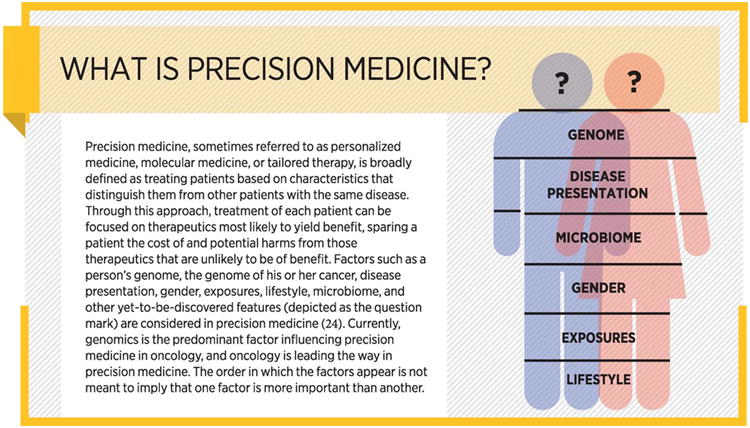
In essence, what precision medicine aims to do is identify the factors most unique to the disease state and use them for the purposes of preventing cancer, diagnosing disease, predicting patient outcomes, and directing therapy. Further, in the research and development setting, these characteristics are used to develop an ever-expanding toolkit of increasingly more precise anticancer therapeutics (see Appendix Table 1, p. 122). In other words, by understanding more about a particular disease, one should be able to develop “magic bullets” specifc for that disease that would leave healthy tissue unharmed, a concept pioneered over 100 years ago by Paul Ehrlich, the father of chemotherapy for disease (25).
Over the course of more than 60 years, we have gone from a limited understanding of the specific factors that influence cancer development to a greater appreciation of the particular genetic mutations that can fuel a cancer (see Figure 3, p. 25, and (Re)Setting the Standard of Care, p. 26). With this more precise knowledge of cancer development, the tools used to prevent, detect, diagnose, and treat cancer have also become more precise.
Figure 3.
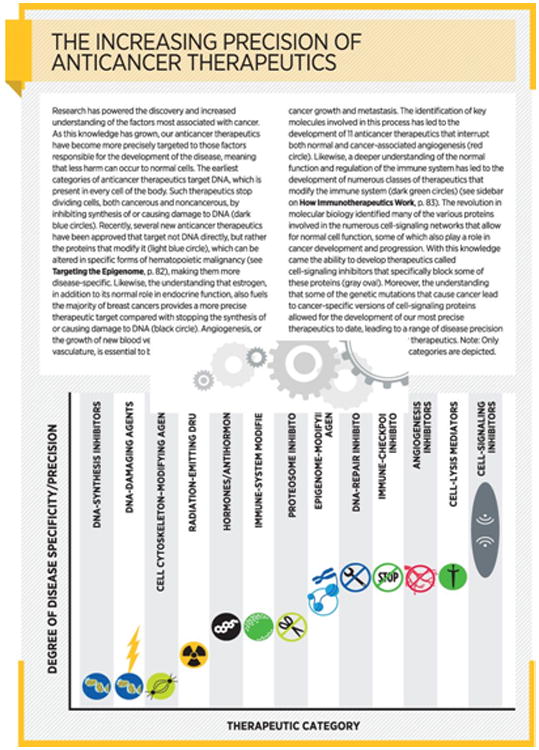
Although precision medicine is not unique to the practice of oncology, oncology is leading such efforts largely because of our immense knowledge of the role of genetic mutations in the development and progression of cancer (see Developing Cancer, p. 18). When this fact is coupled with our increasing ability to read all parts of a person's genome faster than ever before, it becomes clear that genomics is and will continue to be a key driver of precision medicine. It should be noted, however, that genetics is but one of the many factors relevant to precision medicine (see Figure 2). As our ability to analyze all aspects of these other characteristics rapidly catches up with our current genomic prowess, we can expect faster and broader implementation of precision medicine, not only in oncology, but also in the treatment of other diseases.
(Re)Setting the Standard of Care
Numerous advances over the past five years have greatly benefited patients. Chief among these has been a change in the standard of care for many types of cancer, as well as the addition of entirely new therapeutic modalities. Together with those that have been the mainstay of cancer treatment for many years, these new therapies give patients and their physicians many more options to treat, manage, and hopefully overcome their cancers.
Going Deep
In the not-so-distant past, there were three “pillars” of cancer treatment to effectively treat disease—radiotherapy, surgery, and traditional chemotherapy (see Figure 4).
Figure 4.
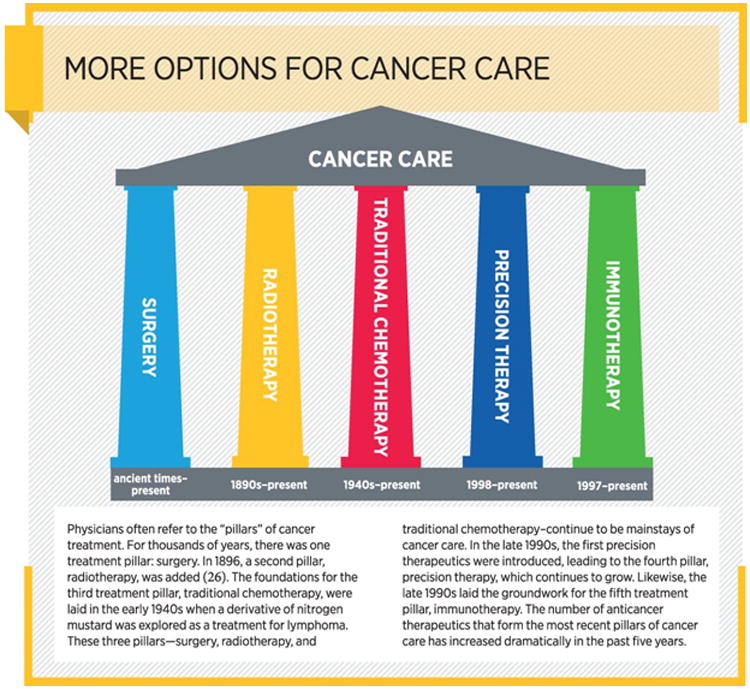
With the advent of molecular biology, we began to understand various cancers at the molecular level and to develop new therapeutics that targeted those molecules that were closely associated with the root cause of the disease. Some of the earliest examples of such “molecularly targeted” therapeutics, which became the first generation of precision therapeutics, include rituximab (Rituxan) for the treatment of B-cell non-Hodgkin lymphoma; trastuzumab (Herceptin) for the treatment of HER-2–positive breast cancer; and imatinib for the treatment of CML.
This first generation of precision therapeutics added a fourth pillar of cancer treatments, and provided new, less-toxic options for physicians treating patients with these cancers (see Figure 4). Unfortunately, at the time, for patients for whom these therapeutics were ineffective, or for those who developed resistance, there were no other precision medicine treatment options. Fortunately, today this is different for patients with many, but not all, types of cancer.
Melanoma is the deadliest form of skin cancer, with only 16 percent of patients with metastatic disease surviving five or more years after diagnosis (6). The first new treatment option for melanoma in 30 years was approved by the FDA in 2011. Prior to that, the standard of care for patients with metastatic melanoma was dacarbazine, a traditional chemotherapeutic, and high-dose aldesleukin (Proleukin), an immune stimulant; however, neither agent had demonstrated a significant effect on overall survival in randomized trials (27).
Since Jan. 1, 2011, the FDA has approved six systemic therapeutics for treating patients with metastatic melanoma, three of which more precisely target the cancer than any other agents previously used to treat patients with this deadly disease (see Figure 5). Two of these novel agents, vemurafenib (Zelboraf) and dabrafenib (Tafinlar), are so precise that they are effective only against the approximately 50 percent of melanomas that harbor mutant forms of BRAF. These therapeutics have transformed the lives of many patients with metastatic melanoma and show the power of this approach to cancer treatment.
Figure 5.
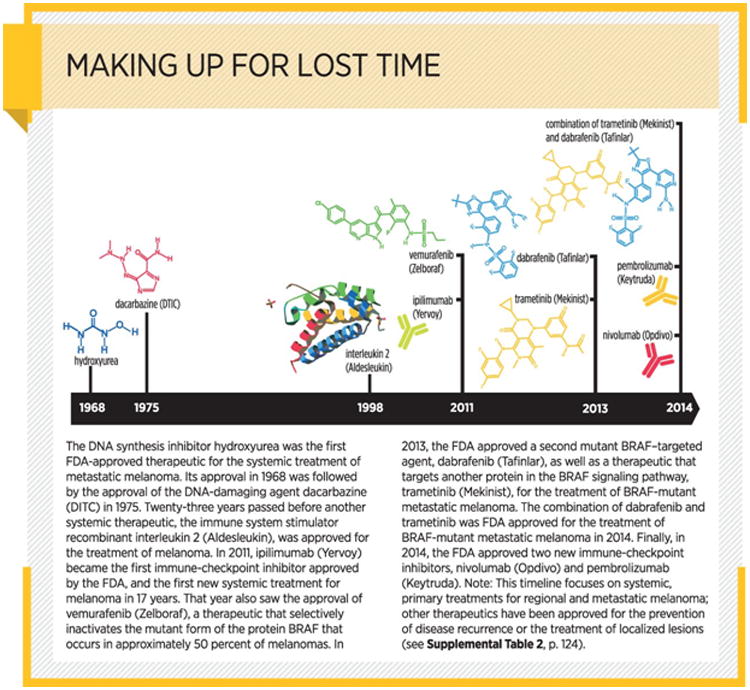
In addition, there are now six precision therapeutics for the treatment of CML, including an agent that targets the common T35I mutation (see Ref. 28 for more details). Similarly, chronic lymphocytic leukemia (CLL) patients have an equally extensive selection of precision therapeutics to treat their disease, including two new agents that were approved in 2014 (see Ref. 1 for more details). Importantly, patients with melanoma, CLL, or CML are not the only individuals with numerous precision therapeutic options, as this is rapidly becoming the rule rather than the exception.
Undoubtedly, as we continue to learn more about the biology of those types of cancer for which no, or relatively few, precision therapeutic options currently exist, we will be able to develop equally impressive and deep toolkits of therapeutic options for patients with these diseases.
A New Pillar
During the past five years, another major advancement in cancer treatment was the addition of a fifth pillar of cancer treatment: immunotherapy (see Figure 4, p. 26). The concept of using a patient's own immune system to eliminate his or her cancer is not new, but in the past five years we have finally been able to effectively translate knowledge about the immune system into revolutionary advances in patient care (see Treatment With Immunotherapeutics, p. 82).
There are numerous types of immunotherapeutics (see sidebar on How Immunotherapeutics Work, p. 83). The first immune-checkpoint inhibitor, ipilimumab (Yervoy), was FDA approved in 2011, with two others approved by the FDA in 2014, and many more in various stages of clinical development and regulatory review (see Releasing the Brakes on the Immune System, p. 84). The first therapeutic vaccine for the treatment of cancer, sipuleucel-T (Provenge), was also FDA-approved in 2011 for the treatment of metastatic prostate cancer. Now, some groups are using genomics to develop precision therapeutic vaccines (see Retooling).
The past few years have also brought forth the concept of engineering a patient's immune cells to specifically attack his or her cancer. This promising technique has resulted in chimeric antigen receptor (CAR) T–cell therapy, which has been shown in early clinical trials to successfully treat both pediatric and adult patients with several types of blood cancer (see Boosting the Killing Power of the Immune System, p. 85). Two CAR T–cell therapies recently received FDA breakthrough designations for the treatment of acute lymphoblastic leukemia (ALL), which will help this new form of immunotherapy reach patients as quickly as possible (see Precision Regulation, p. 30).
Our understanding of this powerful class of therapeutics and the newest addition to the pillars of cancer treatment is just beginning. We will undoubtedly uncover even more effective and precise ways of using these tools in the near future (see What Progress Does the Future Hold? p. 100).
Retooling
As discussed above (see Developing Cancer, p. 18), cancer is characterized by alterations of the genome. We are now able to use these alterations to more precisely diagnose disease, predict patient outcomes, develop therapies, and direct treatment. Although the causes of cancer are far more complex than a collection of genetic mutations (see sidebar on Cancer Growth: Local and Global Influences, p. 22), genetic sequencing is one of our most effective tools for analyzing cancer. Consequently, many researchers have begun to investigate the possibility of using genetic sequencing to increase the relative precision of some non–genetic-based anticancer therapeutics.
As discussed in What Progress Does the Future Hold? (p. 100), several groups are actively using genomic sequencing to determine which patients are most likely to respond to various types of immunotherapeutics. Others are investigating whether genomics can be used to identify ways to develop more precise anticancer vaccines (29).
The earliest traditional chemotherapeutic was based on nitrogen mustard gas and was found to cause damage to DNA, leading to early death of rapidly dividing cells, such as cancer cells. The success of this and compounds like it led to the development of dozens of traditional chemotherapeutics that function to damage DNA (see Appendix Table 1, p. 122). Although these drugs are relatively imprecise, some groups have been using genomics to identify patients who have cancers that, due to certain genetic mutations, cannot efficiently repair damage to their DNA and stand to benefit the most from DNA-damaging agents (see Ways to Use Radiotherapy and Traditional Chemotherapy More Precisely, p. 62). In this manner, physicians can use genomics to more precisely deliver a class of otherwise relatively imprecise anticancer therapeutics.
Another way to increase the precision of a traditional chemotherapeutic is to link it to an antibody that recognizes and attaches to a specific protein on the surface of a certain type of cancer cell. Because this new therapeutic, called an antibody–drug conjugate, more precisely delivers the traditional chemotherapeutic to the cancer cells compared with conventional systemic infusion of the traditional chemotherapeutic, it is less toxic and causes fewer side effects. There are two FDA-approved anticancer antibody– drug conjugates, ado-trastuzumab emtansine (Kadcyla) and brentuximab vedotin (Adcetris), but many more of this emerging category of anticancer therapeutics are currently being tested in clinical trials.
These are but a few examples of how we are learning to use genomics and other molecularly based tools not only to enhance our knowledge of cancer, but also to increase the precision with which we use our existing tools and therapies.
There are many uses for genomics. Two uses have the potential to convert small successes into benefit for much larger groups of patients (see sidebar on Transforming Lives One Sequence at a Time, p. 29). These are the use of genomics to assign a patient to a therapeutic not previously FDA approved for his or her cancer type, known as drug repositioning, and the use of genomics to determine why a few patients' cancers either responded, known as rare-responders, or failed to respond to a particular therapy.
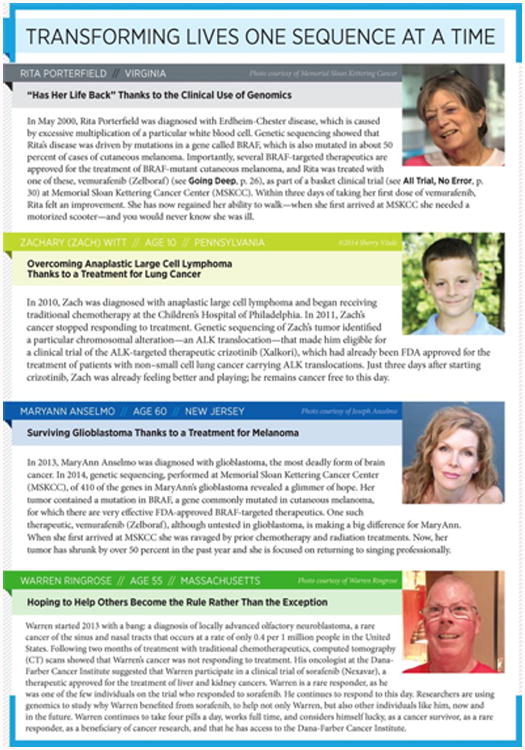
The AACR Cancer Progress Report 2014 featured one such drug-repositioning story (1). At just 5 years of age, Zach Witt was diagnosed with anaplastic large cell lymphoma (see sidebar on Transforming Lives One Sequence at a Time, p. 29). His team of physicians at Children's Hospital of Philadelphia performed genomic sequencing of his tumor and found that it contained a mutation in a gene called ALK. Because the FDA had already approved the ALK-targeted therapeutic crizotinib (Xalkori) for treating patients with non–small cell lung carcinoma (NSCLC) harboring ALK mutations, Zach's physicians had recently initiated a clinical trial testing crizotinib as a treatment for childhood cancers carrying ALK mutations. Zach's parents enrolled him in the trial, and thanks to crizotinib, he has been cancer free for several years. Successes like this have the potential to benefit the 10 to 15 percent of children whose lymphomas harbor the ALK mutation, if they are borne out in large-scale clinical trials.
One rare responder, Warren Ringrose (see sidebar on Transforming Lives One Sequence at a Time, p. 29), is teaching physicians and researchers about how best to use sorafenib (Nexavar), which targets multiple molecules involved in angiogenesis and related signaling pathways that drive cell multiplication and survival. Warren was diagnosed with olfactory neuroblastoma and enrolled in a clinical trial testing sorafenib as a treatment for head and neck cancers. Warren was among the few individuals on the trial who responded to sorafenib, and he continues to respond nearly two years later. In the not-so-distant past, Warren would have simply been considered “lucky,” an interesting medical anecdote. However, over the past five years, physicians and researchers have been increasingly turning to genomics to determine what makes patients like Warren “lucky.” By using genomics to learn about Warren's success, physicians and researchers want to help make others like Warren the rule rather than the exception.
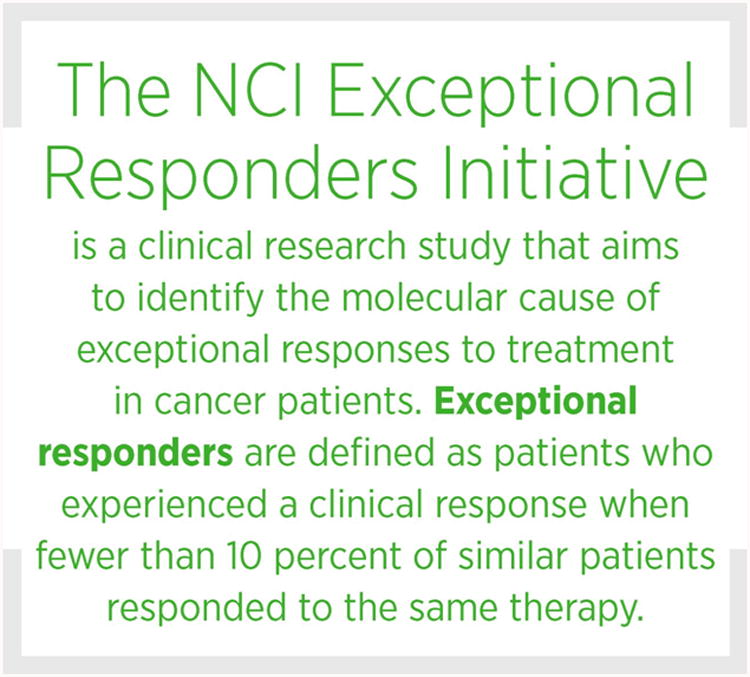
Going Big
As discussed above, there are numerous characteristics of a person and his or her cancer that need to be considered when implementing precision medicine (see Figure 2, p. 24). During the past five years, rapid technological progress has allowed us to analyze a person's microbiome, hormones, genome, and epigenome at wholesale scales, a stark contrast from the past, when each would have been analyzed one at a time.
Coupling these advances with recent improvements in our ability to image the body and its contents more quickly, with higher resolution and increasing speed, we have made significant and rapid progress against cancer. This progress, however, brings its own challenges. We are now generating enormous amounts of data per patient, and this will only “balloon” as these types of analyses scale across more patients to entire populations. Implementation of precision medicine for the treatment of cancer is, therefore, a “big data” problem (see Figure 6, p. 31).
What are “big data”?
Big data are defined as data sets that are so large and complex that they cannot easily be analyzed using traditional methods. For big data to truly benefit patients, researchers must be able to convert this mass of data into meaningful knowledge. As the use of precision medicine, particularly genomics, moves closer to becoming the standard of care for everyone, the need to understand and manipulate big data will become even greater. Thus, researchers from all areas of the biomedical research enterprise need to work together to prepare for the coming tsunami of data.
Precision Regulation
In the United States and elsewhere, an experimental therapy must be tested in clinical trials and undergo evaluation by the relevant ruling regulatory body to ensure that it is both safe and effective. During the past five years, the pace of progress against cancer has accelerated dramatically. As the research landscape has changed, the regulatory and clinical trial landscapes have adapted to keep pace.
All Trial, No Error
Several changes relating to clinical trials have occurred during the past five years.
The first of these includes a shift in perception about clinical trials. Once viewed as the “last hope” for a given patient, they are now beginning to be considered as a normal part of cancer care. Although there remains room for improvement in attitudes toward and participation in clinical trials (see Building Blocks to Furthering Precision Medicine, p. 104), this change is helping to deliver novel treatments to the right patients as quickly as possible.
A major change to the conduct of clinical trials, particularly in the past five years, has been the use of genomics and adaptive trial designs to identify the patients most likely to benefit from a given therapy (see Biomedical Research, p. 53). These strategies seek to reduce the number of patients required to enroll in a clinical trial to demonstrate that a given therapy is effective.
These trials largely fall into one of two categories: “basket” studies and “umbrella” studies (see Figure 7, p. 32). Basket studies are those that test a given therapy on a group of patients who all have the same type of genetic mutation, irrespective of the anatomic site of origin of the cancer, whereas umbrella studies aim to identify the best therapy for different types of genetic mutations all within the same anatomic cancer type.
Figure 7.

Whatever these types of studies are called, they are essential for moving precision medicine forward as quickly as possible. The conduct of clinical trials has been revolutionized in a few short years, and undoubtedly we can expect this revolution to continue as precision medicine moves forward at an ever-quickening pace.
Regulatory Transformation
As discussed above, the revolution in cancer research can be meaningful for patients only if the regulatory bodies that approve the resultant novel therapies adapt as the research landscape changes. In the United States, the FDA has done just that by developing numerous new strategies to get safe and effective therapies to patients as quickly as possible (see sidebar on FDA's Expedited Review Strategies, p. 60).
In addition to these expedited review strategies, in 2012 the FDA initiated a new path to enhance the pace at which experimental breast cancer therapeutics are approved (Ref. 1 for more details). In 2013, pertuzumab (Perjeta) became the first therapeutic to be approved under this new regulatory path, and the molecularly targeted therapeutic is now benefiting patients with HER-2–positive breast cancer.
These are but a few examples of how the FDA is working to transform patients' lives as safely and quickly as possible.
The past five years have been an amazing period of change in cancer research and medicine, and the examples presented here are surely but a small sampling of what we can expect in the next five years.
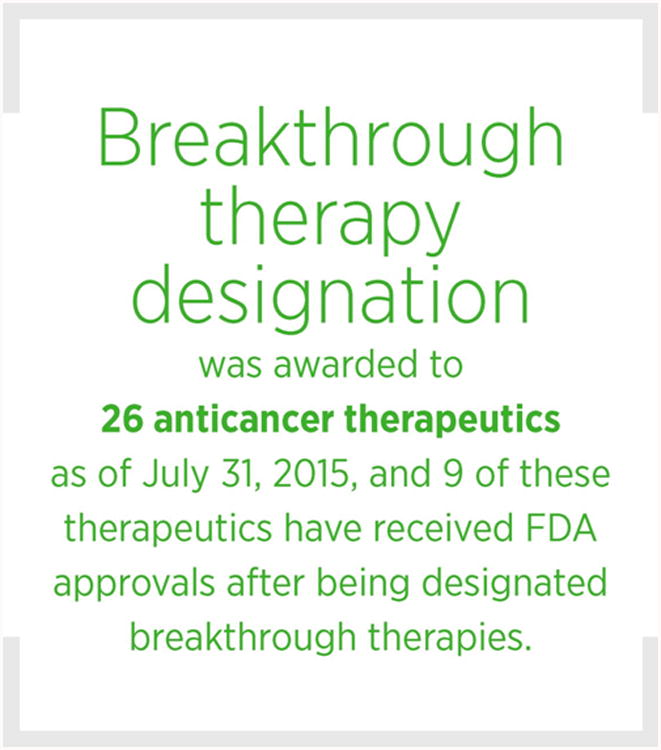
Preventing Cancer from Developing
In this Section You Will Learn:
More Than Half of U.S. Cancer Deaths are a Result of Preventable Causes.
Not Using Tobacco is the Single Best Way a Person Can Prevent Cancer From Developing.
Up to One-Third of All New Cancer Diagnoses in the United States are Related to Being Overweight or Obese, Physical Inactivity, and/or Poor Dietary Habits.
Many Cases of Skin Cancer Could Be Prevented By Protecting the Skin From Ultraviolet Radiation From the Sun and Indoor Tanning Devices.
Infection With Many Known Cancer-Causing Pathogens Can Be Prevented By Vaccination or Managed By Treatment.
Developing a Personalized Cancer Prevention and Early Detection Plan With Your Health Care Practitioners Can Help Prevent Cancer Before it Starts or Intercept it Early in its Development, When it Can Be More Easily and Successfully Treated.
Factors that increase the chance that a cell will acquire a genetic mutation consequently increase the chance that a cell will become cancerous and are referred to as cancer risk factors (see sidebar on Why Me? Why This Cancer?, p. 19). Decades of research have led to the identification of many cancer risk factors (see Figure 8, p. 34), which, in turn, has taught us that many cases of cancer are preventable (34).
Figure 8.
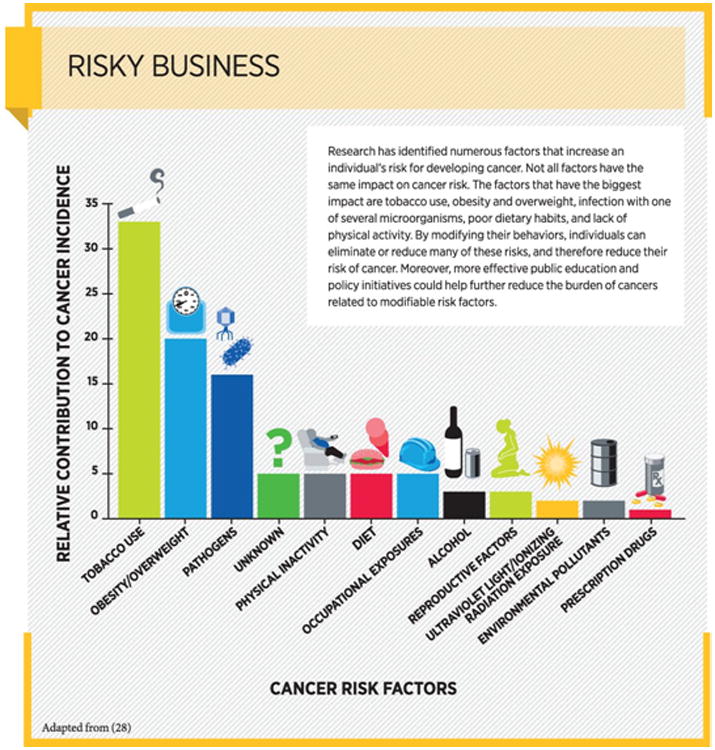
In the United States, many of the greatest reductions in cancer morbidity and mortality have been achieved by translating discoveries of cancer risk factors into effective new public education and policy initiatives. For example, major public education and policy initiatives to combat cigarette smoking have been credited with preventing eight million premature deaths from 1964 to 2014 (35) (see Figure 9, p. 35), and policy initiatives that minimize exposure to other cancer risk factors, such as asbestos and pollutants, have also played a role.
Figure 9.
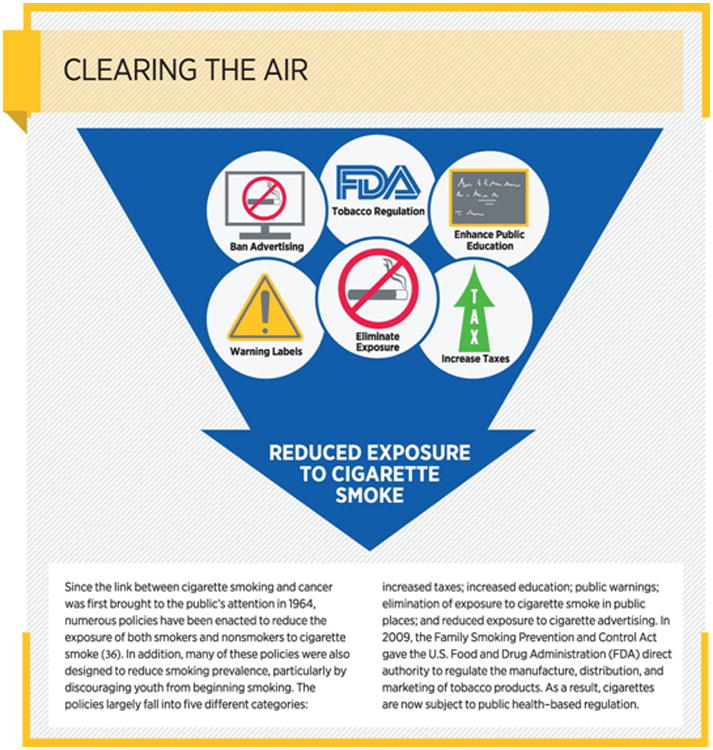
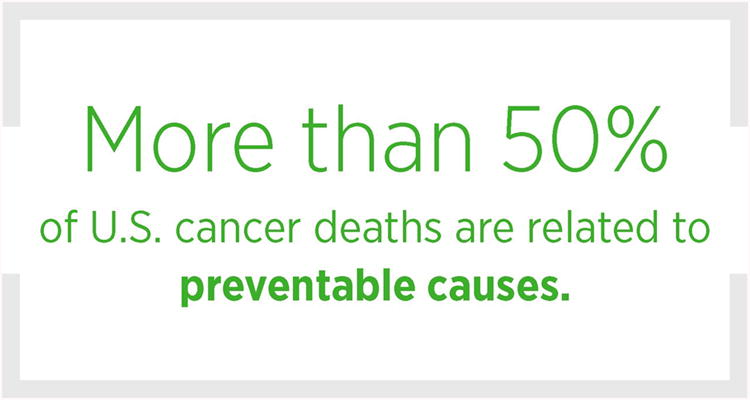
Policies, whether implemented by schools, workplaces, businesses, or government—local, state, or federal—work by helping to create environments that allow individuals to more easily adopt a lifestyle that promotes cancer prevention. Thus, it is imperative that everyone work together to develop and implement new, more effective public education and policy initiatives to help reduce the burden of cancer further, in particular the burden from those cancers related to preventable causes.
In addition, a great deal more research and more resources are needed to understand why some individuals are refractory to public education and policy initiatives and how best to help these individuals eliminate or reduce their risk of some cancers.
Eliminate Tobacco Use
Tobacco use is responsible for almost 30 percent of cancers diagnosed in the United States each year (34) (see Figure 8, p. 34). Therefore, one of the most effective ways a person can lower his or her risk of developing cancer, as well as other smoking-related conditions such as cardiovascular, metabolic, and lung diseases, is to eliminate tobacco use (see sidebar on Reasons to Eliminate Tobacco Use, p. 35).
Since the relationship between tobacco use and cancer was first brought to the public's attention in 1964, when the “U.S. Surgeon General's Report on Smoking and Health” was published (43), the development and implementation of major public education and policy initiatives have more than halved cigarette smoking rates among U.S. adults (36) (see Figure 9). As a result of these reductions, an estimated 800,000 deaths from lung cancer were avoided between 1975 and 2000 (36).

Unfortunately, U.S. cigarette smoking rates have begun to plateau in recent years (36), and 831,000 individuals age 12 or older began smoking cigarettes daily in 2013 (44). If we continue on this path, researchers estimate that 5.6 million children currently ages 0 to 17 years will die prematurely of smoking-related illnesses, including cancer (36).
Globally, tobacco use was estimated to be responsible for about six million deaths in 2011, and this number is projected to reach eight million in 2030 if current trends continue (45). Given that there were an estimated 1.6 million lung cancer deaths worldwide in 2012 (6), and that the majority of these deaths are attributable to tobacco use, it is clear that tobacco-related lung cancer is responsible for more than one million deaths around the world each year.
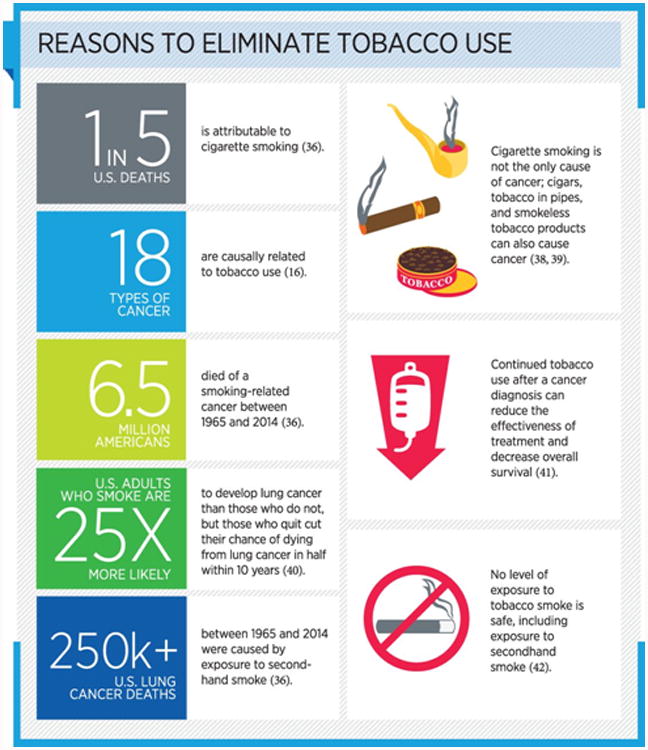
Cigarettes are not the only tobacco products that can cause cancer—smoking cigars, using smokeless tobacco (for example, chewing tobacco and snuff), and smoking tobacco in pipes have all been linked to certain types of cancer (38, 39). Given that in the United States, in 2013, there were an estimated 12.4 million current cigar users age 12 or older, 8.8 million smokeless tobacco users, and 2.3 million pipe tobacco users, in addition to the 55.8 million cigarette smokers (44), it is imperative that researchers, clinicians, advocates, regulators, and policymakers continue to work together to develop new and better approaches to prevent tobacco use initiation and facilitate cessation if we are to eradicate one of the biggest threats to public health.
Electronic cigarettes (e-cigarettes) are frequently marketed as a less harmful alternative to traditional combustible cigarettes and as helpful for those trying to quit cigarette smoking (47). However, e-cigarettes may be harmful if they increase the likelihood that nonsmokers—particularly children—or former smokers will start smoking combustible cigarettes, or if they discourage smokers from quitting. Therefore, more research is needed so that we can fully understand the health consequences of e-cigarette use, their value as tobacco cessation aids, and their effects on the use of combustible tobacco products by smokers and nonsmokers (41) (see sidebar on E-cigarettes: What We Know and What We Need to Know, p. 38). The need for this information is particularly pressing because recent data show that in 2014, e-cigarettes were the most commonly used tobacco product among U.S. middle and high school students, with use of these devices tripling from 2013 to 2014 (48).
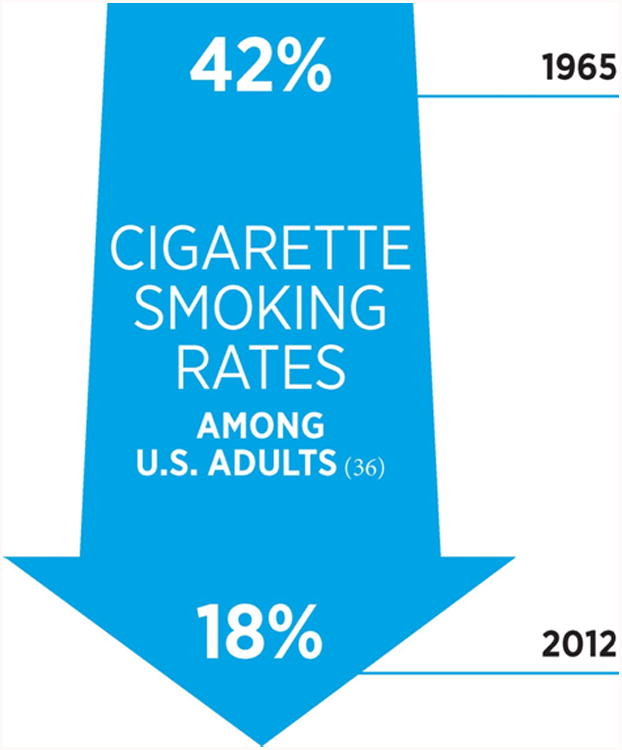
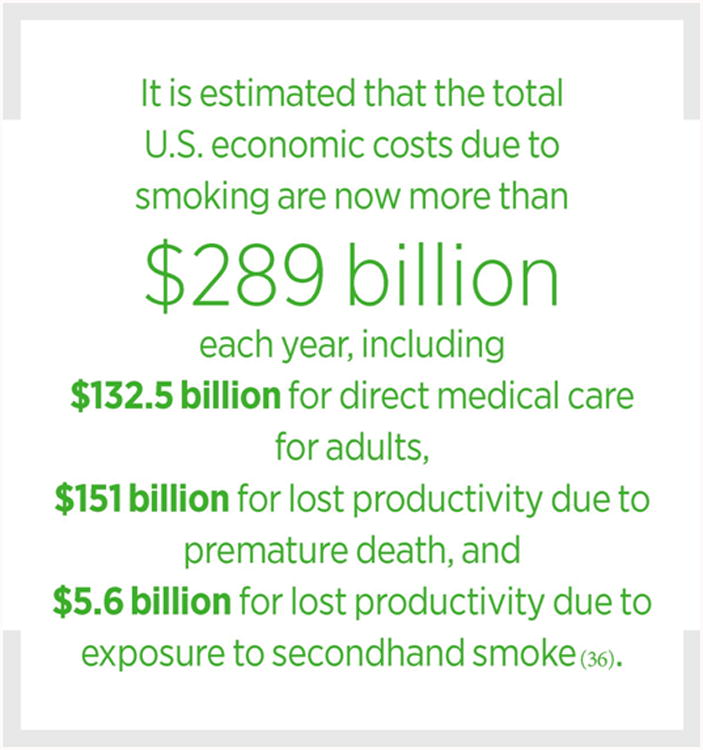
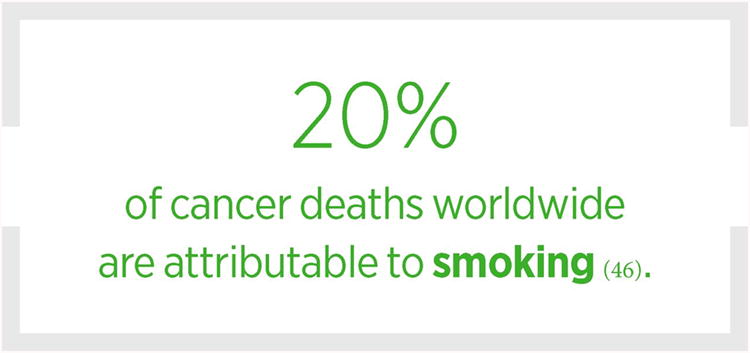
Maintain a Healthy Weight, Eat a Healthy Diet, and Stay Active
Researchers estimate that one in every three new cases of cancer diagnosed in the United States is related to being overweight or obese, being inactive, and/or consuming a poor diet (15, 34). Therefore, maintaining a healthy weight, participating in regular physical activity, and eating a balanced diet are effective ways people can lower their risk of developing or dying from cancer (49) (see sidebar on Reduce Your Risk for Cancers Linked to Being Overweight or Obese, Being Inactive, and/or Consuming a Poor Diet, p. 40). In fact, two recent studies that followed 650,000 individuals for more than 10 years showed that healthy lifestyles reduced cancer incidence by 10–15 percent, and cancer mortality by 20–25 percent, in addition to 40–50 percent reductions in cardiovascular-associated mortality and 25–40 percent reductions in all-cause mortality (50, 51).

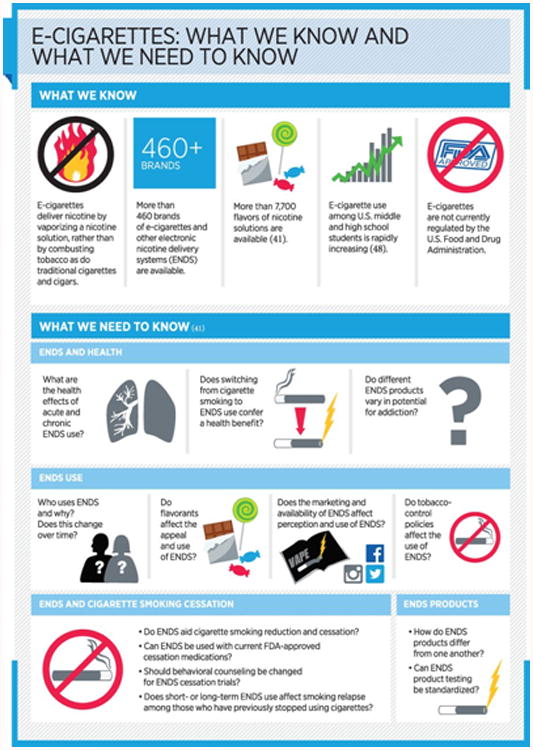
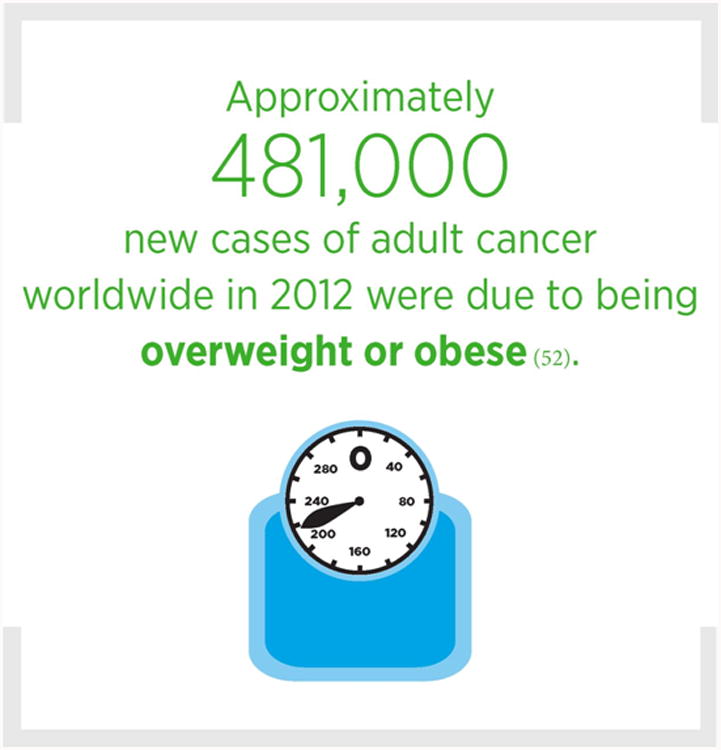
In addition to the fact that being overweight or obese as an adult has been strongly associated with 10 types of cancer (15, 54-56) (see Figure 10, p. 41), recent data suggest that increased body weight during childhood and adolescence may increase risk for colorectal cancer later in life (57, 58). Larger studies are needed to confirm this finding and investigate whether early-life excess body weight increases risk of other types of cancer.
Figure 10.
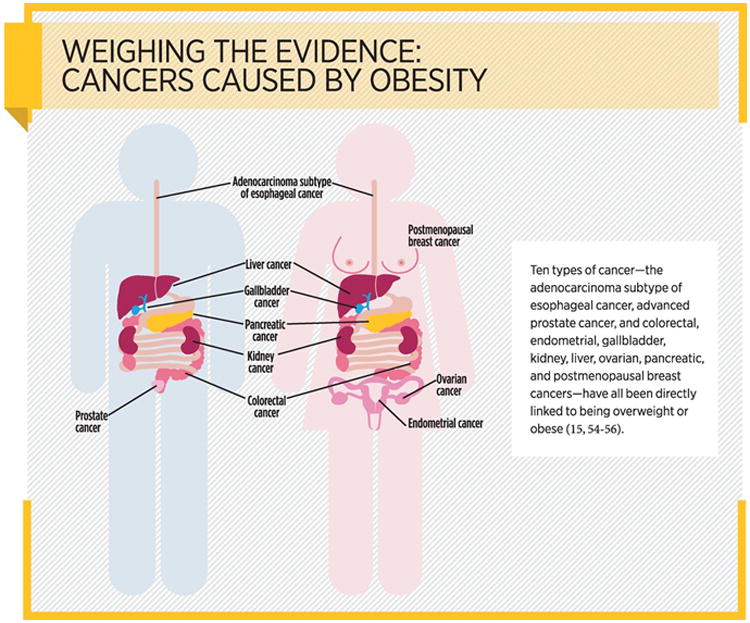
Given that being overweight or obese and being inactive have such an immense impact on cancer risk, as well as risk for other diseases, it is extremely concerning that in the United States more than two-thirds of adults are overweight or obese (59), 17 percent of youth are obese (60), and nearly half of all adults do not meet the recommended guidelines for aerobic physical activity (61). Unfortunately, the United States is not alone; the latest estimates show that 20 percent or more of the population age 15 or older of nine other countries designated by the Organization for Economic Cooperation and Development (OECD) is obese (62) (see Figure 11, p. 42). Moreover, sedentary behaviors, such as prolonged sitting at a computer, may increase risk for certain types of cancer (63), although additional research is needed to more clearly define the contribution of sedentary behavior to risk for cancer.
Figure 11.
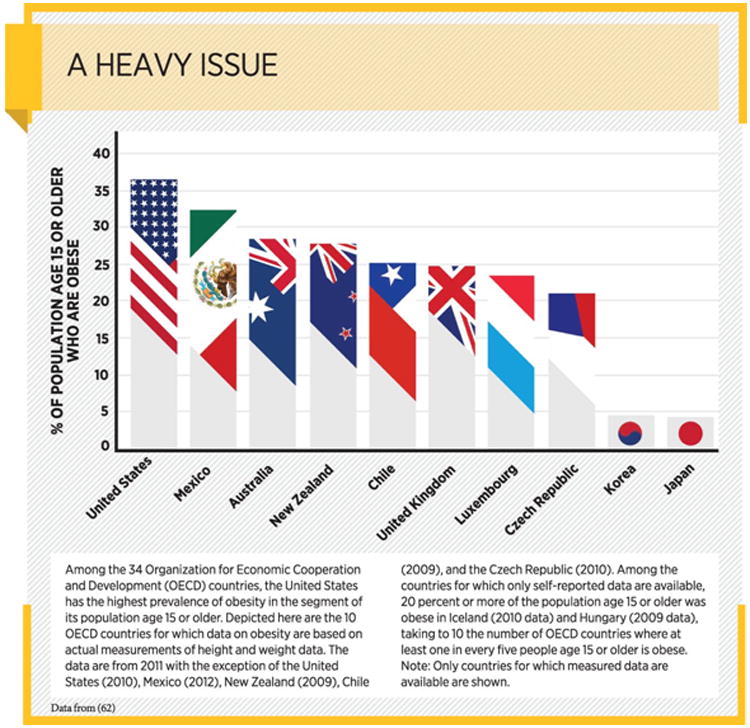
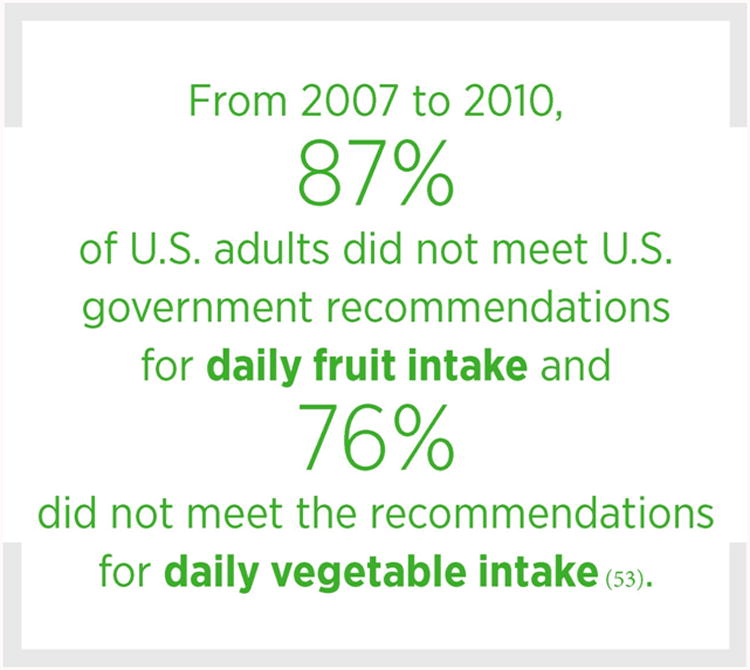

Thus, concerted efforts by individuals, families, communities, schools, workplaces, institutions, health care professionals, media, industry, government, and multinational bodies are required to develop and implement effective strategies to promote the maintenance of a healthy weight and the participation in regular physical activity. Although such interventions will enhance overall health, more research is required to better understand the effect of weight loss at various stages of life on cancer risk.
In addition to preventing the development of some cancers, maintaining a healthy weight, engaging in regular physical activity, and eating a balanced diet may also improve outcomes for individuals diagnosed with certain types of cancer, in particular breast, colorectal, and prostate cancers; reduce risk of disease recurrence and metastasis; and increase the chance of long-term survival (65-68).
Protect Skin From Ultraviolet Exposure
Most cases of the three main types of skin cancer—basal cell carcinoma, squamous cell carcinoma, and melanoma—are caused by exposure to ultraviolet (UV) radiation from the sun, sunlamps, sunbeds, and tanning booths (69). In fact, it has been estimated that UV exposure causes as many as 90 percent of U.S. cases of melanoma, the most deadly type of skin cancer (69). Although the majority of these cases are caused by UV radiation exposure from the sun, about 8 percent are attributable to indoor tanning (70). Thus, one of the most effective ways a person can reduce his or her risk of skin cancer is by protecting themselves from the sun and not using UV indoor tanning devices (see sidebar on Ways to Protect Your Skin, p. 43).
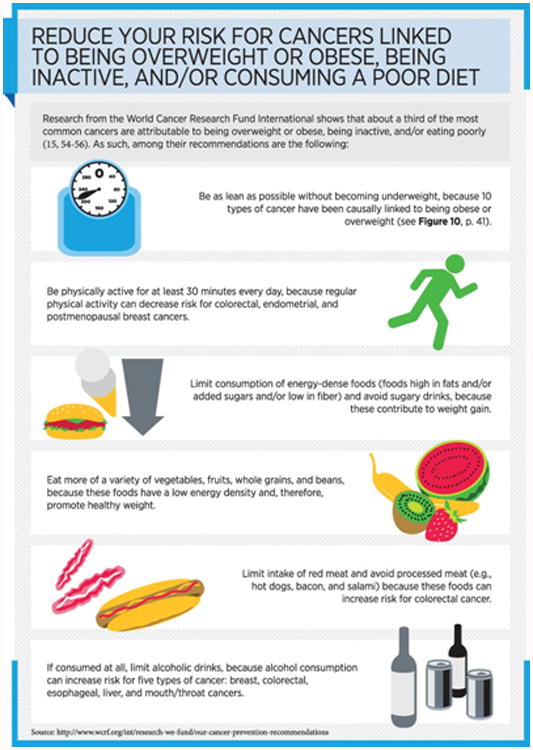
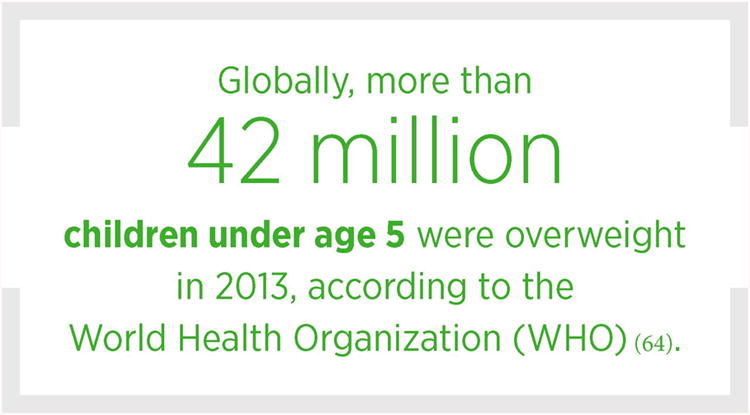
Despite this knowledge, melanoma incidence rates in the United States have been increasing for at least three decades, and the number of new cases of melanoma diagnosed each year is projected to rise from 65,647 in 2011 to 112,000 in 2030 if current trends continue (71). Fueling the rise is the fact that one in three adults in the United States report experiencing at least one sunburn in the past 12 months, and 5 percent report using an indoor UV tanning device at least once (72, 73). Moreover, 13 percent of all high school students and 31 percent of white high school girls report using an indoor UV tanning device in the past year (74).
Given these continued exposures and that fewer than 15 percent of men and 30 percent of women use sunscreen regularly on their face and other exposed skin when outside for more than one hour (75), it is vital that all sectors of the U.S. population work together to develop and implement more effective policy changes and public education campaigns to reduce exposure to UV radiation. In fact, it is estimated that implementation of a comprehensive skin cancer prevention program could prevent about 21,000 melanoma cases each year from 2020 to 2030 (71). Moreover, with nearly 5 million people a year treated for all forms of skin cancer in the United States at an estimated cost of $8.1 billion (69), these efforts are vital if we are to reduce the personal and the economic burden of skin cancer.
Prevent Infection With Cancer-causing Pathogens
Persistent infection with a number of pathogens—bacteria, viruses, and parasites that cause disease—is responsible for an estimated 16 percent of worldwide cancer cases diagnosed each year (76-78) (see Figure 12, p. 45, and Table 4, p. 45). Therefore, individuals can significantly lower their risk for certain types of cancer by protecting themselves from infection with cancer-associated pathogens or by obtaining treatment, if available, to eliminate an infection.
Figure 12.
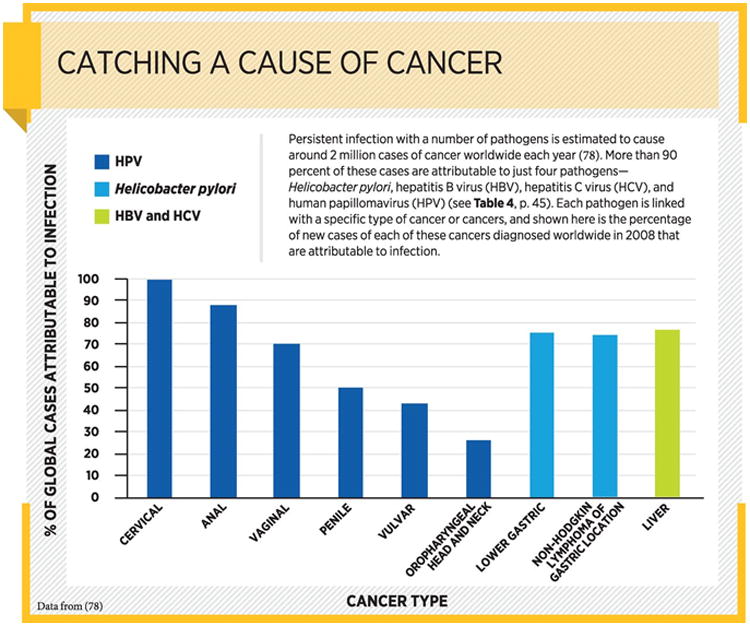
Table 4. Cancer-Causing Pathogens.
| BACTERIA | ||
| Pathogen | Cancer | % of global cancer cases attributable to infection* |
| Helicobacter pylori | Stomach cancers | 32.5 |
| PARASITES | ||
| Pathogen | Cancer | % of global cancer cases attributable to infection* |
| Clonorchis sinensis | Biliary cancer, pancreatic cancer, and gallbladder cancer | 0.1 |
| Opistorchis viverrini | Biliary cancer, pancreatic cancer, and gallbladder cancer | unknown |
| Schistosoma haematobium | Bladder cancer | 0.3 |
| VIRUSES | ||
| Pathogen | Cancer | % of global cancer cases attributable to infection* |
| Epstein-Barr Virus (EBV) | Stomach cancers, Hodgkin and certain non-Hodgkin lymphomas, and nasopharyngeal cancers | 5.4 |
| Hepatitis B/C Virus (HBV and HCV) | Hepatocellular carcinoma | 29.5 |
| Human Herpes Virus type -8 (HHV-8; also known as Kaposi sarcoma herpes virus) | Kaposi sarcoma and certain forms of lymphoma | 2.1 |
| Human Immunodeficiency Virus (HIV) | Kaposi sarcoma and non-Hodgkin lymphoma | unknown |
| Human Papillomavirus (HPV) | Cervical, anogenital, head and neck, and oral cancers | 30 |
| Human T-cell Lymphotrophic Virus, type 1 (HTLV-1) | T-cell leukemia and lymphoma | 0.1 |
| Merkel Cell Polyomavirus (MCV) | Skin cancer | unknown |
where known
Data from (78)
In fact, there are strategies available to eliminate, treat, or prevent infection with the four pathogens that account for more than 90 percent of pathogen-associated cancer cases: Helicobacter pylori, hepatitis B virus (HBV), hepatitis C virus (HCV), and human papillomavirus (HPV) (78) (see sidebar on Preventing or Eliminating Infection With the Four Major Cancer-causing Pathogens, p. 46). Thus, it is clear that these strategies are not being used optimally and that the global burden of cancer could be significantly reduced through more effective implementation of these strategies.

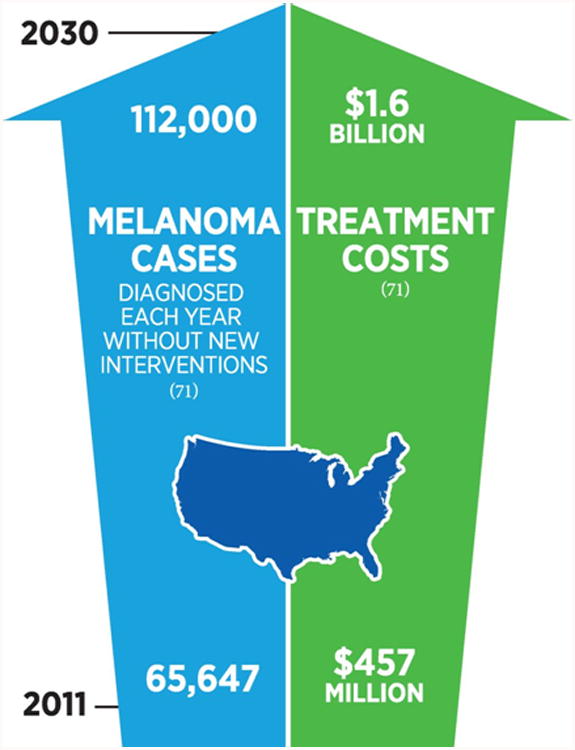
In the United States, the development of strategies to increase uptake of the three FDA-approved HPV vaccines could have an immense impact on cancer prevention (see Cancer Prevention, Detection, Interception, and Diagnosis, p. 58). The most recent estimates from the Centers for Disease Control and Prevention (CDC) show that in 2013, only 6 percent of men and 37 percent of women ages 19 to 26 had received one or more dose of HPV vaccine (79). In addition, in 2012, only 33 percent of girls ages 13 to 17 had received the recommended three doses of HPV vaccine (80). This low coverage stands in stark contrast to that in other high-income countries, such as Australia and the United Kingdom, and Rwanda, a low-income country that recently reported HPV vaccination of more than 90 percent of eligible girls following implementation of a national, multisector, collaborative, school-based program (81, 82).
Moreover, it is estimated that in the United States, more than 50,000 cases of cervical cancer and thousands of cases of other HPV-related cancers, including many anal, genital, and oral cancers, could be prevented if 80 percent of those for whom HPV vaccination is recommended— girls and boys at age 11 or 12—were to be vaccinated (82). In addition, research has shown that vaccinating boys as well as girls has the potential not only to save lives from oropharyngeal cancer, but also to save health care costs (83).
Limit Exposure to Other Risk Factors
There are numerous additional cancer risk factors, including reproductive factors, occupational cancer-causing agents, and environmental pollutants (84) (see Figure 8, p. 34). Given that it can be difficult for people to avoid or reduce their exposure to many of these factors, it is imperative that policies are put in place to ensure that everyone lives in a safe and healthy environment.
In the United States, some policies that help prevent cancer have been in place for several decades. For example, there are numerous policies to help prevent exposure to asbestos, which can cause mesothelioma, an aggressive type of cancer for which there remain few treatment options (85). For other known environmental cancer risk factors, for example, radon gas released from rocks, soil, and building materials, there are existing guidelines for reducing exposure, but compliance with these guidelines is not mandatory. For others, for example, exposure to occupational cancer-causing agents and environmental pollutants, there is a clear need to develop and implement more effective policies.
One environmental pollutant that was recently classified by the International Agency for Research on Cancer (IARC), an affiliate of the World Health Organization, as “carcinogenic to humans,” alongside agents such as plutonium and cigarettes, is outdoor air pollution (87).
Outdoor air pollution is a complex cancer-risk factor because it is a mixture of pollutants, some of which are currently classified as carcinogenic to humans by IARC, that vary over space and time as a result of differences in climate and sources. However, we know the sources of much outdoor air pollution—emissions from motor vehicles, industrial processes, power generation, and the burning of solid fuels for domestic heating and cooking—and it is clear that new policy efforts to reduce the release of pollutants into the atmosphere are sorely needed if we are to reduce the global burden of cancer.
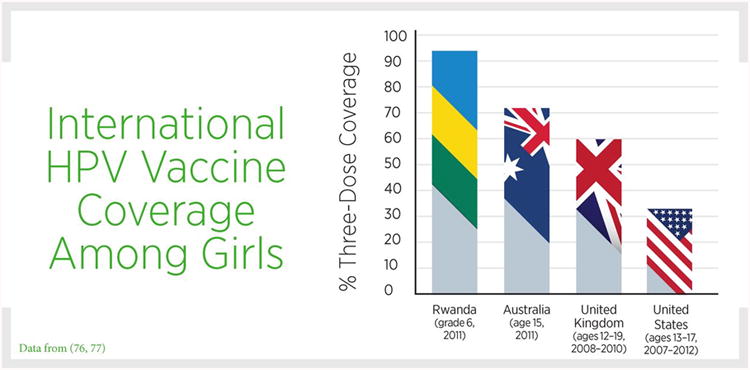
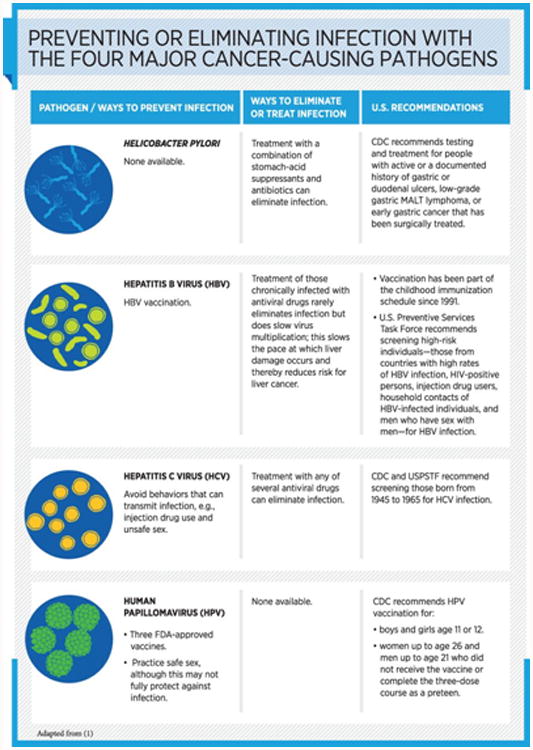
Screening for Early Detection and Interception
We know that most cancers arise as a result of the accumulation of genetic mutations and that the chance that a cell acquires a genetic mutation is influenced by many different factors (see sidebar on Why Me? Why This Cancer? p. 19). Although people can avoid some of these factors, thereby significantly reducing their risk for cancer, not all factors are avoidable—for example, the acquisition of mutations during cell multiplication (21)—and not everyone avoids factors that can be avoided. This is where we have learned to exploit our knowledge of the causes, timing, sequence, and frequency of the genetic, molecular, and cellular changes that drive cancer initiation and development to implement screening strategies that allow us to intercept these events at the earliest possible stage.
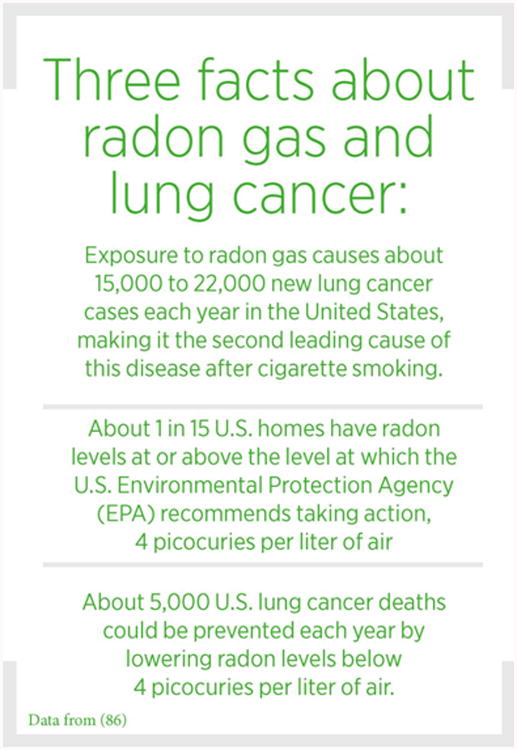
Some screening tests can prevent cancer from developing because they detect precancerous changes in a tissue that can be intercepted and removed before they have the chance to develop into cancer. For example, colonoscopy can detect abnormal growths, or polyps, in the colon and rectum that can be removed before they develop into colorectal cancer. In fact, the CDC estimates that between 2003 and 2007, approximately 33,000 cases of colorectal cancer in the United States were prevented by colorectal cancer screening (88).
Other screening tests can detect cancer at a very early stage of development so that it can be intercepted before it has spread to other parts of the body, which makes it more likely that a patient can be treated successfully.
Screening to detect and intercept cancer before an individual shows signs or symptoms of the disease for which he or she is being screened has many benefits, but it can also result in unintended adverse consequences (see sidebar on Cancer Screening, p. 48). Thus, population-level use of a cancer screening test must not only decrease deaths from the screened cancer, but it must also provide benefits that outweigh the potential risks. Determining whether broad implementation of a screening test can achieve these two goals requires extensive research and careful analysis of the data generated.
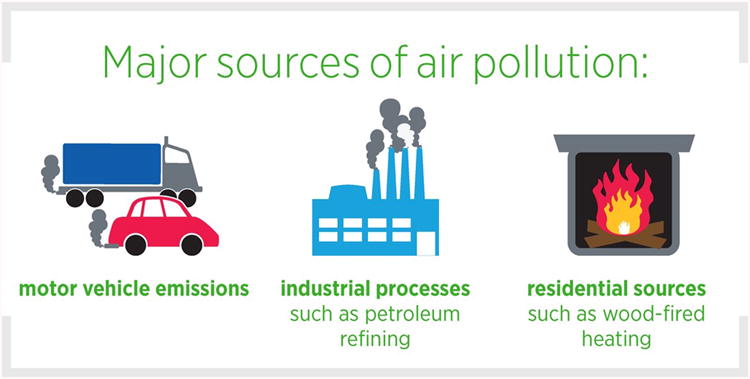
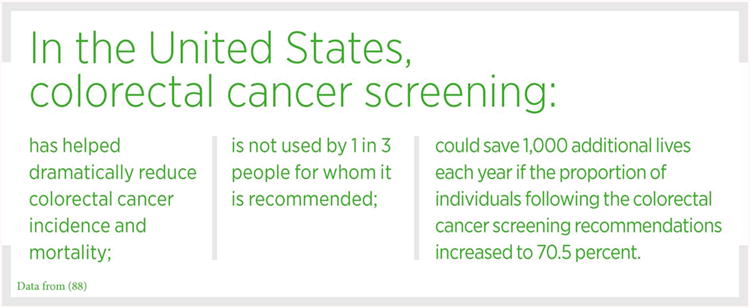
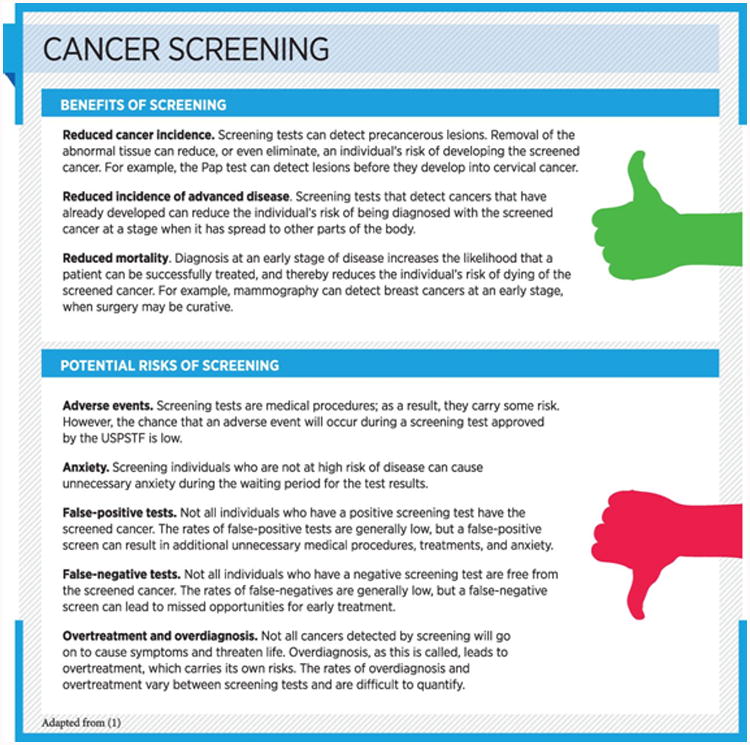
In the United States, rigorous data analysis by members of the U.S. Preventive Services Task Force (USPSTF)— an independent group of experts convened by the Public Health Service—has led to evidence-based recommendations for the use of screening tests for four types of cancer among the general U.S. population (see sidebar on USPSTF Cancer-screening Recommendations for Average-risk Adults). These recommendations are re-evaluated as new research becomes available and can be revised if deemed necessary.
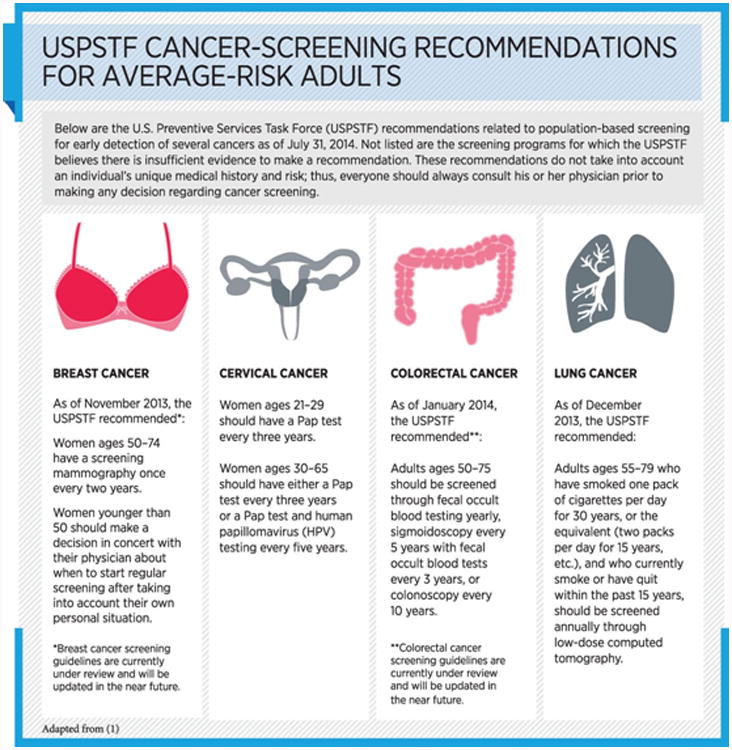
The USPSTF and other relevant professional societies' evidence-based cancer screening recommendations are only one consideration when a person makes decisions about which cancers he or she should be screened for and when. This is because everybody has his or her own unique risks for developing each type of cancer, and the established screening guidelines apply to average-risk individuals. A person's overall risks are determined by genetic, molecular, cellular, and tissue makeup, as well as by lifetime exposures to cancer risk factors (see Figure 8, p. 34). Therefore, every individual should consult with his or her health care practitioners to develop a cancer prevention and early detection plan tailored to his or her personal cancer risks. Given that risk for different types of cancer can vary over time—for example, risk for most cancers increases with age—it is important that individuals continually evaluate their personal screening plans and update them if necessary.
A New Era of Precision Prevention and Interception
As we develop and implement new strategies that pair our increased molecular understanding of cancer development with knowledge of an individual's unique cancer risk profile, including genetic makeup at birth, exposures to cancer-risk factors, age, and gender, we will usher in a new era of precision prevention and interception (89) (see Figure 13).
Figure 13.
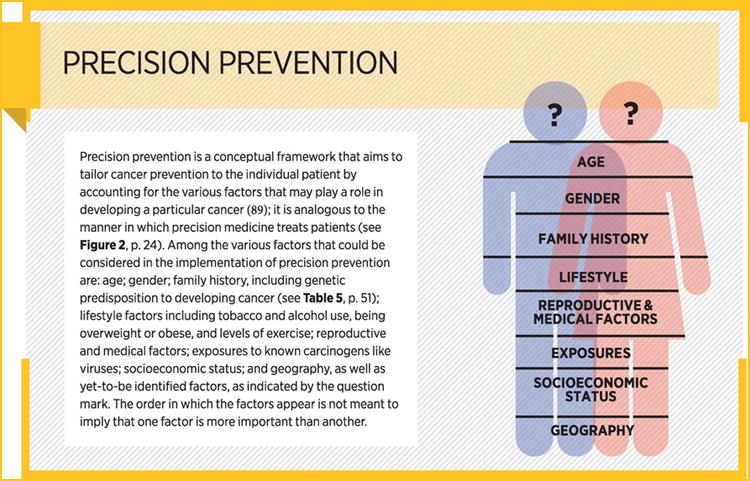
Precision prevention and interception are not entirely new concepts. For example, we know that some individuals are at increased risk of certain cancers because they inherited a cancer-predisposing genetic mutation (see Table 5, p. 51). If a person thinks that that he or she are at high risk for developing an inherited cancer (see sidebar on How Do I Know If I Am at High Risk for Developing an Inherited Cancer?, p. 52), he or she should consult a physician and consider genetic testing, and if the person does indeed carry one of these mutations, risk-reducing measures tailored to his or her precise needs can be taken (see sidebar on Direct-to-Consumer Genetic Testing, p. 52). Some people at high risk might be able to reduce their risk of developing cancer by modifying their behaviors, whereas others might need to increase their participation in screening programs or consider taking a preventive medicine or having risk-reducing surgery (see Table 6, p. 51 and Appendix Table 2, p. 124).
Table 5. Inherited Cancer Risk.
| CANCER | SYNDROME | ASSOCIATED GENE |
|---|---|---|
| Leukemias and lymphomas | Ataxia telangiectasia | ATM |
| All cancers | Bloom syndrome | BLM |
| Breast, ovarian, pancreatic and prostate cancers | Breast-ovarian cancer syndrome | BRCA1, BRCA2 |
| Breast, thyroid, and endometrial cancers | Cowden syndrome | PTEN |
| Colorectal cancer | Familial adenomatous polyposis (FAP) | APC |
| Melanoma | Familial atypical multiple mole-melanoma syndrome (FAMM) | CDKN2A |
| Retinal cancer | Familial retinoblastoma | RB1 |
| Leukemia | Fanconi's anemia | FACC, FACA |
| Colorectal cancer | Hereditary nonpolyposis colorectal cancer/Lynch syndrome | MLH1, MSH2, MSH6, PMS2 |
| Pancreatic cancer | Hereditary pancreatitis/familial pancreatitis | PRSS1, SPINK1 |
| Leukemias, breast, brain, and soft tissue cancers | Li-Fraumeni | TP53 |
| Pancreatic cancers, pituitary adenomas, benign skin and fat tumors | Multiple endocrine neoplasia 1 | MEN1 |
| Thyroid cancer, pheochromocytoma | Multiple endocrine neoplasia 2 | RET, NTRK1 |
| Pancreatic, liver, lung, breast, ovarian, uterine, and testicular cancers | Peutz-Jeghers syndrome | STK11/LKB1 |
| Tumors of the spinal cord, cerebellum, retina, adrenals, kidneys | von Hippel-Lindau syndrome | VHL |
| Kidney cancer | Wilms tumor | WT1 |
| Skin cancer | Xeroderma pigmentosum | XPD, XPB, XPA |
This list is not meant to be exhaustive, but contains some of the more commonly occurring cancer syndromes
Source: http://dceg.cancer.gov/research/what-we-study/genes-host/hereditary-cancer-syndromes
Table 6. Surgeries For the Prevention of Cancer.
| GENETIC MUTATION | CANCER | TECHNIQUE | REMOVES |
|---|---|---|---|
| APC | Colon cancer | Colectomy | Colon/large intestine |
| BRCA1 or BRCA2 | Breast cancer | Mastectomy | Breasts |
| BRCA1 or BRCA2 | Ovarian cancer | Salpingo-oophorectomy | Ovaries and fallopian tubes |
| CHD1 | Stomach cancer | Gastrectomy | Stomach |
| RET | Medullary thyroid cancer | Thyroidectomy | Thyroid |
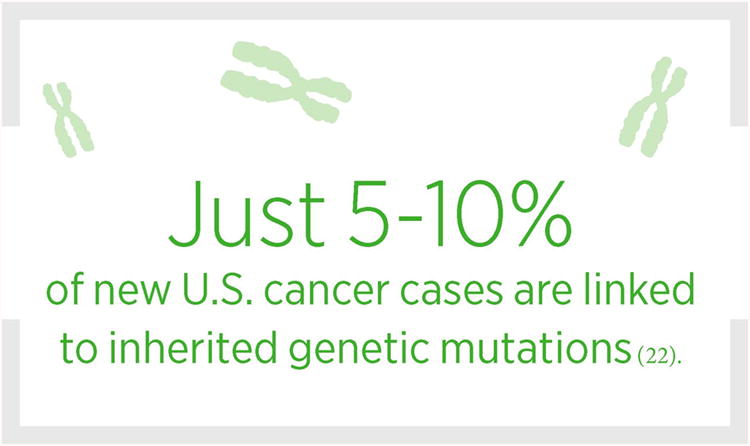
Despite the progress that has been made in cancer prevention, early detection, and interception, not all cancers are currently preventable and not everyone has access to or takes advantage of current prevention and early detection strategies. Moreover, these strategies are not equally effective for all individuals.
Precision prevention and interception have the potential to address these issues and to significantly reduce the personal and financial burdens of cancer. However, achieving this potential will require input from researchers across the spectrum of biomedical research.
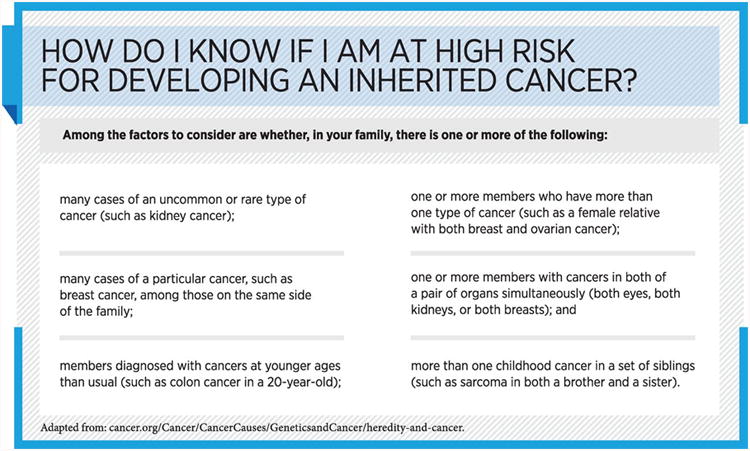
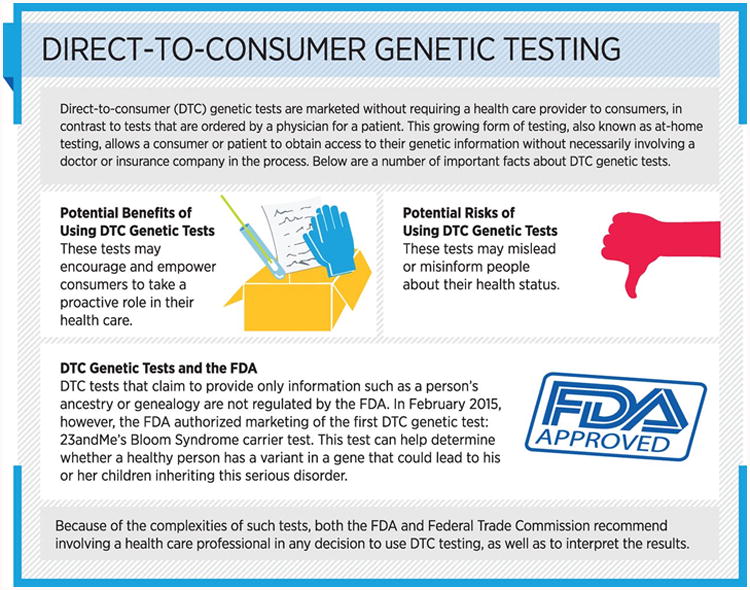
Transforming Lives Through Precision Medicine
In This Section You Will Learn:
From Aug. 1, 2014, to July 31, 2015, the FDA Approved Nine New Therapeutics for Treating Certain Types of Cancer, One New Cancer Prevention Vaccine, and One New Cancer Screening Test.
During the Same Period, the FDA Authorized New Uses For Six Previously Approved Anticancer Therapeutics And One Imaging Agent.
Pairing the Increased Understanding of Cancer Biology With Information About Each Patient's Own Cancer is Increasing the Precision With Which Radiotherapy and Traditional Chemotherapy are Used.
Clinical Trials That Aim to Match the Right Therapeutics With the Right Patients Earlier Are Based on Cancer Genomics Research, and Are Becoming More Common.
Identifying Ways to Help Cancer Survivors Meet the Numerous Challenges They Face After Their Initial Diagnosis is an Area of Intensive Research.
The dedicated efforts of individuals working throughout the cycle of biomedical research (see Figure 14, p. 54) have led to extraordinary advances across the continuum of clinical care that are transforming and saving lives in the United States and worldwide.
Figure 14.
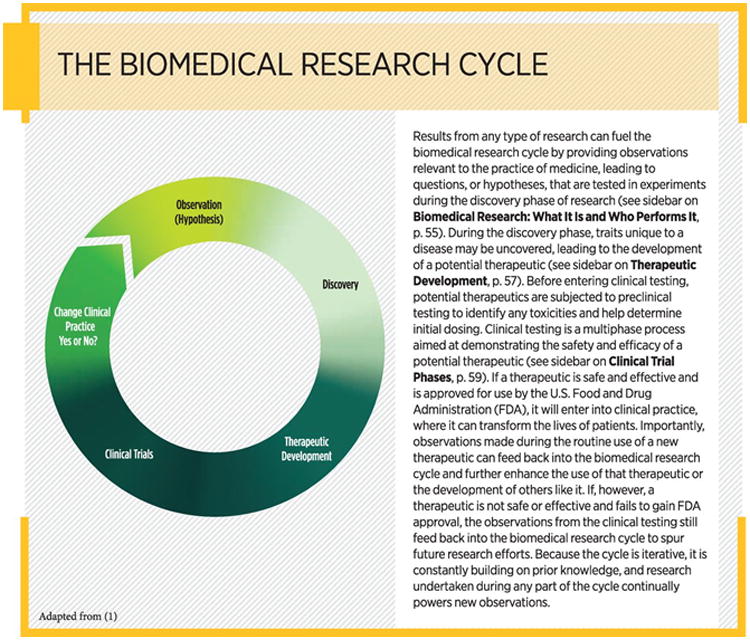
Biomedical Research
Biomedical research is an iterative cycle, constantly building on prior knowledge, with one discovery influencing the next (see Figure 14, p. 54). In recent years, the cycle has become increasing efficient as the pace of discoveries has increased, and various sectors within the biomedical research enterprise have become further integrated, leading to one seamless ecosystem (see sidebar on Biomedical Research: What It Is and Who Performs It, p. 55). As a result of these changes, the pace at which patient lives are transformed through precision medicine has accelerated and will continue to do so for the foreseeable future (see What Progress and Promise Does the Future Hold? p. 100).
In short, the biomedical research cycle is set in motion when discoveries with the potential to affect the practice of medicine are made by researchers in numerous disciplines, including laboratory research, population research, clinical research, and clinical practice. Ultimately, the discoveries lead to questions, or hypotheses, that are tested by researchers performing experiments in a wide range of models that mimic healthy and disease conditions (see sidebar on Research Models, p. 56). The results from these experiments can lead to the identification of a potential therapeutic target or preventive intervention, or they can feed backward in the cycle by providing new discoveries that lead to more hypotheses.
After identification of a potential therapeutic target, it takes several years of hard work before a candidate therapeutic is developed and ready for testing in clinical trials (see sidebar on Therapeutic Development, p. 57). During this time, candidate therapeutics are rigorously tested to identify any potential toxicity and to ensure that they have the maximum chance of success in clinical testing.
Clinical trials are a central part of the biomedical research cycle. Before most potential new diagnostic, preventive, or therapeutic products can be approved by the FDA and used as part of patient care, their safety and efficacy must be rigorously tested through clinical trials (see sidebar on What Is the FDA? p. 58). There are several types of cancer clinical trials, including treatment trials, prevention trials, screening trials, and supportive or palliative care trials, each designed to answer different research questions.
Treatment trials evaluating potential new anticancer therapeutics predominantly add an investigational intervention to the current standard of care. These types of clinical trial have traditionally been done in three successive phases, each with an increasing number of patients (see sidebar on Phases of Clinical Trials, p. 59). Recently, the Tufts Center for the Study of Drug Development estimated that it costs pharmaceutical companies more than $2.5 billion to develop and gain approval for a new therapeutic, a process often lasting longer than a decade (90), although others have noted that not all costs associated with the discovery and development of new therapeutics are borne by industry (91). In the past five years, immense efforts have been made to address these issues by identifying new ways of conducting and regulating clinical trials that can eliminate the need for large, long, multiphase clinical trials (see Special Feature on Five Years of Progress, p. 23, and below).
Briefly, many efforts to streamline the development of new anticancer therapeutics are powered by our increasing knowledge of cancer biology, in particular, cancer genomics. This knowledge has led researchers to focus on the production of therapeutics that precisely target the molecules disrupted as a result of cancer-specific genetic mutations. This, in turn, has led to novel clinical trial designs that aim to match the right therapeutics with the right patients earlier, to reduce the number of patients that need to be enrolled in clinical trials before it is determined whether or not the therapeutic being evaluated is safe and effective, and to decrease the length of time it takes for a new anticancer therapeutic to be tested and made available to patients.
One example of these new clinical trials is the phase II/III Lung Master Protocol (Lung-MAP) trial, which was launched in June 2014 (92). In this trial, patients with advanced squamous cell carcinoma of the lung are screened for more than 200 genetic alterations using DNA sequencing technologies and then assigned to the segment of the trial testing an investigational therapeutic that best suits their genomic profile. A second example is the NCI-MATCH (NCI-Molecular Analysis for Therapy Choice) trial, which opened for patient enrollment in August 2015 (93). Tumors from patients enrolled in NCI-MATCH will be analyzed for more than 4,000 different genetic alterations. Patients whose tumors, regardless of origin, harbor mutations that match any of the anticancer therapeutics being evaluated in the trial will go on to be assessed for other trial eligibility criteria.
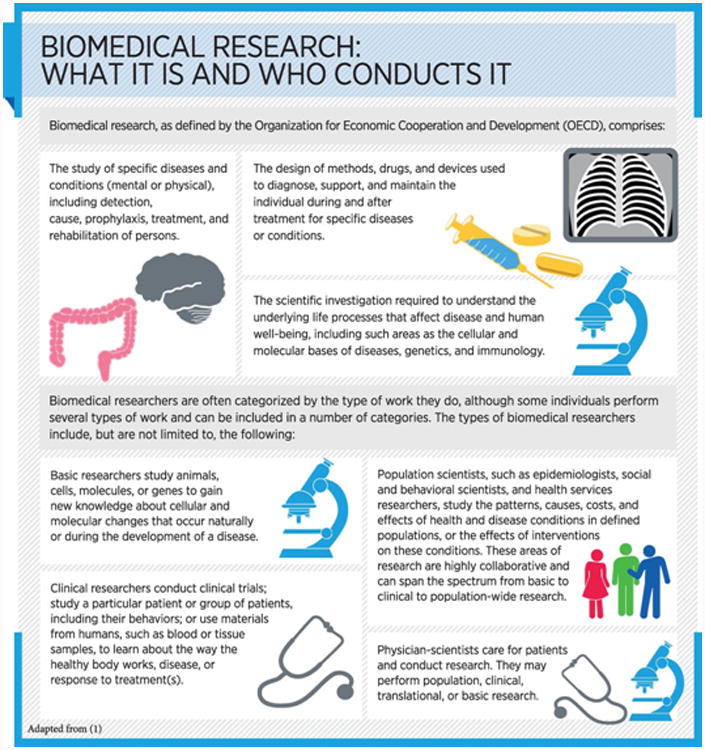
This new era of clinical trials offers the promise to accelerate the pace at which new anticancer therapeutics are tested in the clinic and reduce the number of patients that need to be enrolled in clinical trials, both of which may drive down costs. Therefore, the outcomes of these trials are eagerly anticipated by investigators and patient advocates throughout the biomedical research community.
Other major efforts to reduce the time needed for a clinical trial to continue before a clear result is achieved have been spearheaded by the FDA. For example, the FDA has developed four evidence-based strategies to expedite the evaluation of therapeutics for life-threatening diseases such as cancer (see sidebar on FDA's Expedited Review Strategies, p. 60). An increasing number of anticancer therapeutics is being approved by the FDA using the most recently introduced of these review strategies, breakthrough therapy designation. A key part of this review strategy is that the FDA engages with those developing the investigational therapeutic early in the clinical trials process and provides continued guidance throughout the review period.
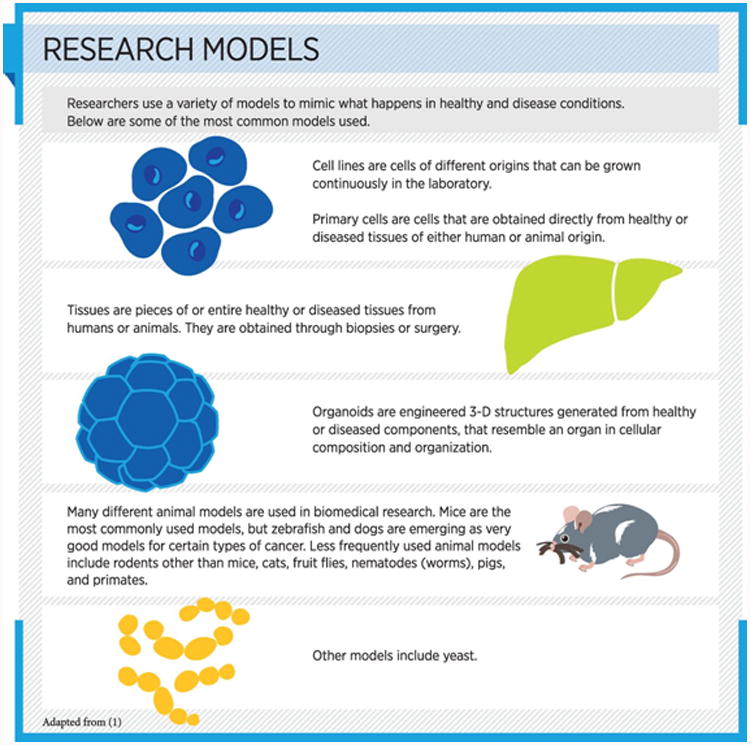
Progress Across the Clinical Cancer Care Continuum
The dedicated efforts of individuals working throughout the biomedical research cycle power the development of the tools that are used routinely to prevent, detect, diagnose, and treat cancer. The number of tools in the physician's armamentarium increases over time, because research is a continuous endeavor that constantly translates scientific discoveries to new FDA-approved medical products.
In the 12 months leading up to July 31, 2015, the FDA approved one new cancer prevention vaccine, one new cancer screening test, and nine new anticancer therapeutics, including four immunotherapeutics (see Table 1, p. 10). During this period, the FDA also approved new uses for one imaging agent and six previously approved anticancer therapeutics, including the molecularly targeted chemotherapeutic ibrutinib (Imbruvica).
The January 2015 FDA approval of ibrutinib for Waldenström macroglobulinemia was the first-ever FDA approval of a treatment for this rare and incurable type of non-Hodgkin lymphoma. It followed earlier approvals of ibrutinib for chronic lymphocytic leukemia and mantle cell lymphoma, which were highlighted in the AACR Cancer Progress Report 2014 (1). The approval of ibrutinib for Waldenström macroglobulinemia was based on the results of a clinical trial showing that the agent transformed the lives of many patients (94), like Shelley Lehrman (who was featured in the AACR Cancer Progress Report 2014; see Ref. 1).
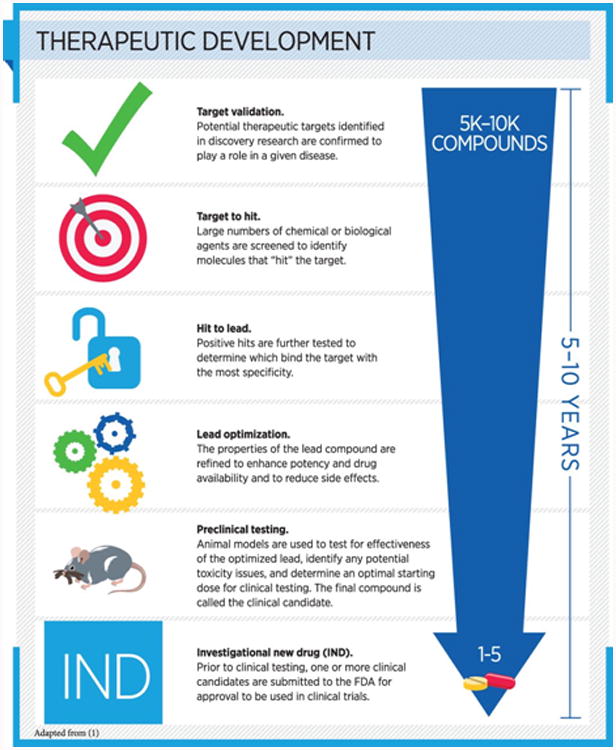

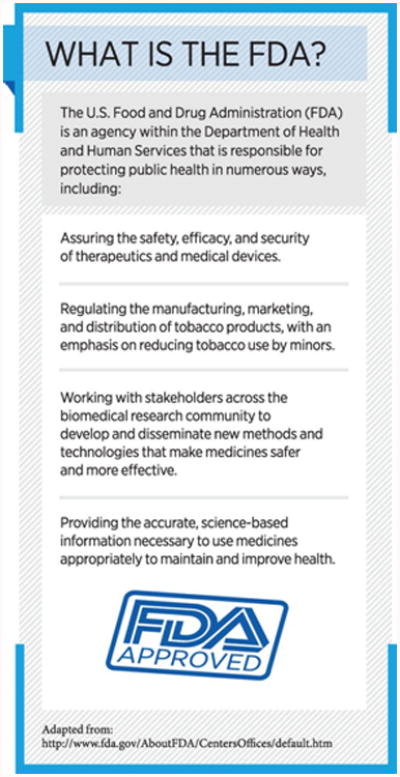
As new tools become available to physicians, they are used alongside many that have been the mainstay of patient care for years. Thus, most patients with cancer are treated with a combination of surgery, radiotherapy, chemotherapy (including both traditional chemotherapeutics and molecularly targeted chemotherapeutics), and immunotherapy (see Appendix Tables 1 and 3, p. 122 and 125).
The following discussion focuses on recent FDA approvals of preventive, diagnostic, and therapeutic products that are transforming lives across the clinical care continuum. It also highlights some advances that are showing near-term promise for fueling change in cancer prevention, interception, detection, diagnosis, treatment, and ongoing care.
Cancer Prevention, Detection, Interception, and Diagnosis
Cancer prevention, early detection, and interception, are the most effective ways to reduce the immense worldwide burden of cancer. The development of new and better ways to prevent cancer onset or to detect a cancer and intercept it earlier in its progression, when there is a greater chance a patient can be successfully treated, have been spurred by research that led to the identification of many cancer risk factors (see Figure 8, p. 34) and to the increasing knowledge of the causes, timing, sequence, and frequency of the genetic, molecular, and cellular changes that drive cancer initiation and development.
Preventing More HPV-related Cancers
Almost all cases of cervical cancer, as well as many cases of vulvar, vaginal, penile, anal, and oropharyngeal cancers, in the United States are caused by persistent infection, at the site at which the cancer arises, with certain strains of HPV (see Figure 12, p. 44). The majority of these cancer cases are attributable to just two of the 12 strains of HPV that can cause cancer, HPV16 and HPV18 (82).
This knowledge led to the development and FDA approval of two vaccines that protect against infection with HPV16 and HPV18: Gardasil and Cervarix. Clinical trials showed that Gardasil and Cervarix are highly effective at preventing precancerous cervical abnormalities caused by HPV16 and HPV18, which are the tissue changes that precede invasive cervical cancer, and it was estimated that if all girls and women for whom vaccination is recommended were vaccinated, almost all cases of cervical cancer caused by HPV16 and HPV18 could be prevented (95).
In an effort to extend these successes to other cancer-causing strains of HPV, researchers developed Gardasil 9 that protects not only against HPV16 and HPV18, but also against five other cancer-causing HPV subtypes—HPV31, 33, 45, 52, and 58. After the vaccine was shown in a clinical trial to be effective at preventing precancerous abnormalities that precede invasive cervical, vulvar, and vaginal cancers caused by HPV31, 33, 45, 52, and 58 (96), it was approved by the FDA in December 2014, for the prevention of cervical, vulvar, vaginal, and anal cancers caused by HPV16, 18, 31, 33, 45, 52, and 58 (see sidebar on How Do the Three FDA-approved HPV Vaccines Differ? p. 61).
The potential for Gardasil 9 to reduce the global burden of cancer is immense. For example, it is estimated that 90 percent of invasive cervical cancer cases worldwide could be prevented if all girls and women for whom vaccination is recommended are vaccinated (97). The potential for HPV vaccines to prevent a significant number of cases of oropharyngeal cancer is of great interest because more than 60 percent of these cancers in the United States are related to HPV infections, and the incidence of these cancers is increasing (82, 98). However, research is needed to confirm that HPV vaccination can indeed prevent people like Robert (Bob) Margolis (who was featured in the AACR Cancer Progress Report 2014; see Ref. 1) from developing HPV-related oropharyngeal cancer.
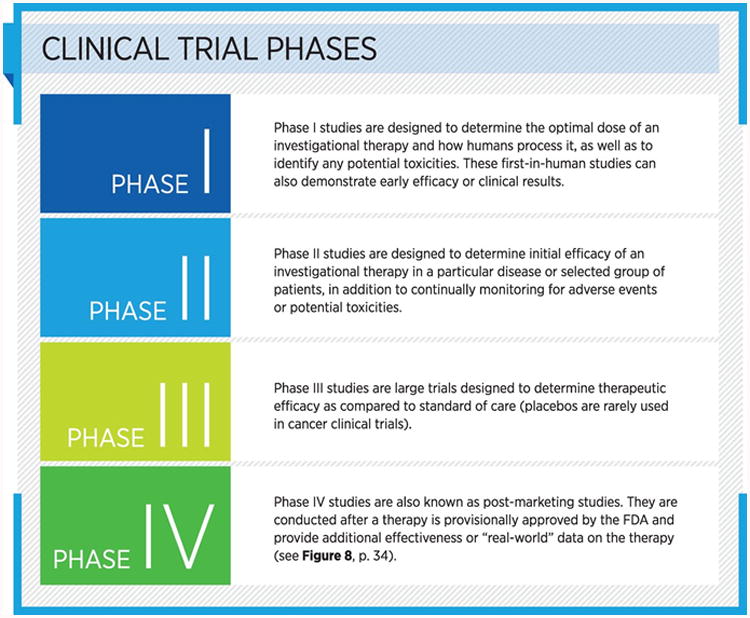
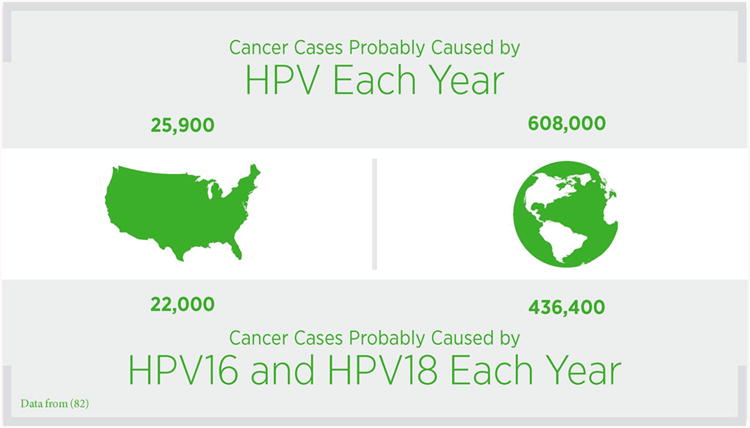
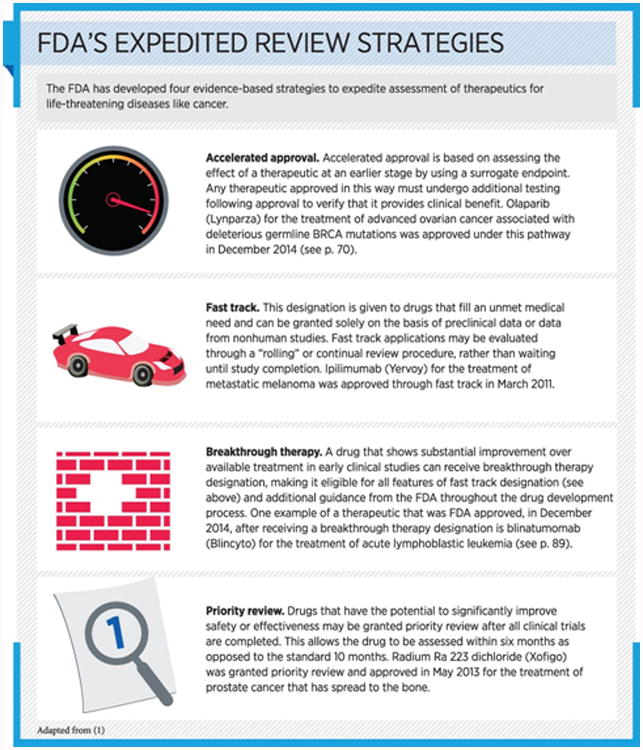
Increasing Options for Colorectal Cancer Screening
In the United States, colorectal cancer screening has helped dramatically reduce colorectal cancer incidence and mortality through the identification and subsequent removal of precancerous colorectal abnormalities and the detection of early-stage cancers, which are more easily treated compared with advanced-stage disease (see Screening for Early Detection and Interception, p. 47). However, one in three people for whom colorectal cancer screening is recommended are not up to date with their screening (88) (see sidebar on USPSTF Cancer-screening Recommendations for Average-risk Adults, p. 49), and colorectal cancer is the fourth most commonly diagnosed cancer and the second leading cause of cancer-related death (6).
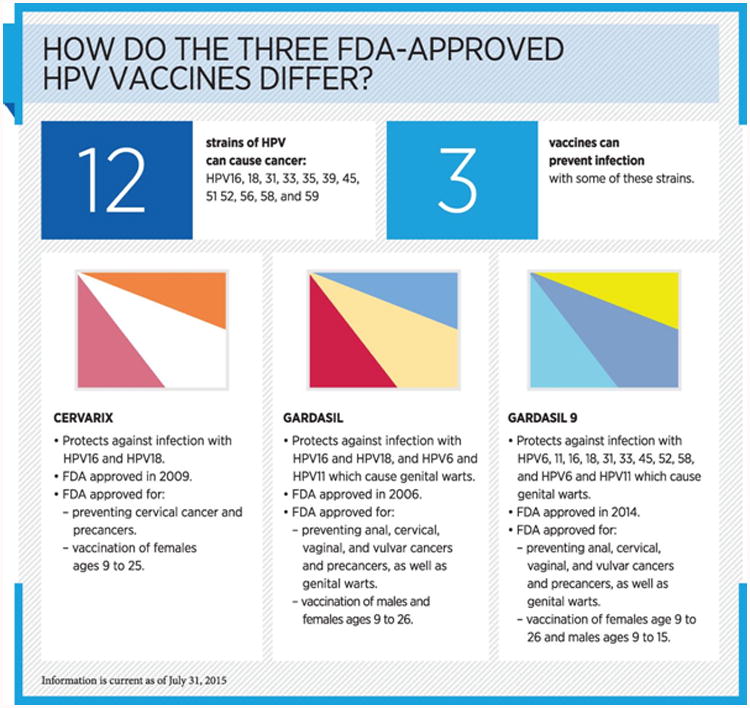
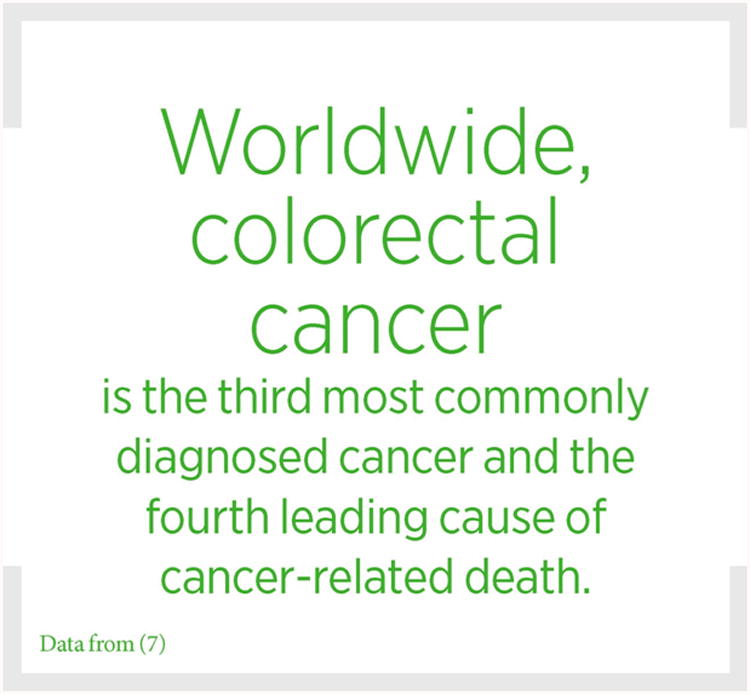
Fear of the colorectal cancer screening test is one reason that U.S. men and women give for not getting screened (88). There is a noninvasive colorectal cancer screening option recommended by the U.S. Preventive Services Task Force, fecal occult blood testing, which tests stool samples for blood that is present in such small amounts it cannot be seen. Although these tests can reduce colorectal cancer deaths by about 30 percent (99), they miss almost one-third of cancers and more than two-thirds of precancerous abnormalities (100).
In an effort to design a more effective stool-based colorectal cancer screening test, researchers exploited our growing knowledge of the genetic basis of cancer and developed a stool-based test that detects the presence of red blood cells and certain genetic mutations linked to colorectal cancer. In a large clinical trial, the new test, Cologuard, was significantly better at detecting colorectal cancers and precancerous colorectal abnormalities than a standard stool test for blood (100), and the test was approved by the FDA in August 2014. The hope of researchers in the field is that Cologuard will help increase the number of people who get screened for colorectal cancer, although further research is needed to determine whether or not this will be the case.
Treatment With Surgery, Radiotherapy, and Traditional Chemotherapy
The advent of the era of precision medicine is transforming lives by changing the standard of cancer care from a one-size-fits-all approach to one in which greater understanding of the patient and his or her tumor dictates the best therapeutic strategy. For those patients for whom a molecularly targeted therapeutic is appropriate, the greater precision of these agents tends to make them more effective and less toxic than the treatments that have been the mainstay of cancer care for decades.
Although tremendous progress has been made, not all patients with cancer can be treated with molecularly targeted therapeutics. There are many reasons for this, including a need for more insight into the biology of many types of cancer. Moreover, in some cases, we know the underlying cause of the disease but so far have been unable to develop safe and effective therapeutics targeting the causative molecules.
Thus, surgery, radiotherapy, and traditional chemotherapy are the best treatment options for many patients with cancer, as they were for Congresswoman Rosa DeLauro (see p. 66) 29 years ago. In fact, these therapeutic modalities form the foundation of treatment for almost all patients, including those for whom molecularly targeted therapeutics and other novel agents are appropriate. Moreover, the more we know about individual patients and their individual cancers, the better we are able to tailor their treatment to be as effective and innocuous as possible. For example, surgery alone may be the best treatment option for some patients, as it was for Congressman Tom Marino (see p. 68).
Improving Diagnosis With Radiology
For many patients with cancer, surgery is an early step in their treatment. In some patients with solid tumors, the surgeon removes not only the initial tumor, but also lymph nodes in the surrounding area because these are the sites to which the tumor is most likely to first spread. The presence or absence of cancer cells in these nodes helps determine the extent to which the initial tumor has spread locally. This information helps establish a patient's precise diagnosis, which is central to developing the most appropriate treatment plan for the patient.
To allow surgeons to see the lymph nodes clearly, patients are injected with a radioactive substance, a blue dye, or both prior to surgery, and then the surgeon uses a device that detects radioactivity and/or looks for lymph nodes that are stained with the blue dye during surgery. In October 2014, the FDA approved a new use for the radioactive diagnostic imaging agent technetium Tc 99m tilmanocept (Lymphoseek) that allows it to be used to find lymph nodes during surgery for any solid tumor where this procedure is a routine part of surgery.
Ways to Use Radiotherapy and Traditional Chemotherapy More Precisely
Radiotherapy and traditional chemotherapy are mainstays of cancer care (see sidebar on Using Radiation in Cancer Care, p. 64). However, both forms of treatment can have long-term adverse effects on patients. Thus, researchers are looking to pair our increasing understanding of cancer biology with knowledge of the traits of each patient's own cancer to increase the precision with which radiotherapy and traditional chemotherapy are used, in order to tailor each patient's treatment to be only as aggressive as is necessary for it to be effective.
Researchers recently identified one potential way to tailor treatment with radiotherapy for women who have had breast-conserving surgery after an early-stage invasive breast cancer diagnosis (101). For this group of patients, prior research had shown that radiotherapy to the breast after breast-conserving surgery could lower the risk of local breast cancer recurrence in the 10 years after diagnosis from 35 percent to 19 percent (102). However, recent research shows that breast radiotherapy does not reduce the risk for local breast cancer recurrence for some of these women, specifically those who have the luminal A molecular subtype of breast cancer and are considered clinically to have a low risk for recurrence because they are older than 60 and have a grade 1 or 2 tumor that is 2 centimeters or smaller (101). Although these results need to be confirmed in further studies, they show promise for a future in which breast radiotherapy can be used more precisely, so that some patients are spared the time and potential toxicity of the treatment (103).
As we learn more about the biology of cancer and the ways in which the traditional platinum-based chemotherapeutics carboplatin, cisplatin, and oxaliplatin exert their anticancer effects, we are beginning to understand that it may be possible to increase the precision with which these agents are used. Given that we know that platinum-based chemotherapeutics damage DNA, and that this damage ultimately kills cells if it is not repaired through an appropriate DNA damage repair pathway, it has been postulated that cancers carrying mutations in DNA damage repair pathway genes, such as BRCA1 and BRCA2, will be particularly sensitive to these agents (104). This has been found to be the case in a number of small studies of patients with BRCA-mutant ovarian or pancreatic cancer (105, 106). However, further studies are needed to extend these observations to larger numbers of patients, as well as a wider array of DNA damage repair pathway gene mutations and cancer types, before treatment with platinum-based chemotherapeutics is tailored in this way.
These examples of how we may be able to increase the precision with which we use radiotherapy and traditional chemotherapy to achieve maximal patient benefit with minimal harm are just two approaches among many that are being studied as we look to better tailor treatments to individual patients' needs.
Treatment With Molecularly Targeted Therapeutics
Research is powering the field of precision medicine in many ways, including by increasing our understanding of the molecules involved in cancer initiation and development. Therapeutics directed to these molecules target cancer more precisely than traditional chemotherapeutics and, therefore, tend to be more effective and less toxic. As a result, molecularly targeted therapeutics—a mainstay of precision medicine—are not only saving the lives of countless cancer patients, but also allowing these patients to have a higher quality of life than many who came before them.
Molecularly Targeting Ovarian Cancer
Ovarian cancer is one of the cancer types for which we have made little progress in recent years. In fact, the five-year relative survival rate for women with ovarian cancer has not changed significantly in the past 25 years: it was 40.4 percent in 1990 and it is estimated to be 45.6 percent today (23).
Traditional platinum-based chemotherapeutics are part of the treatment for most women with ovarian cancer. These agents work by damaging DNA, and it is thought that they may be effective for patients with ovarian cancer because many ovarian cancers have mutations in DNA damage repair pathway genes, such as BRCA1 and BRCA2, and cannot efficiently repair the DNA damage caused by the platinum-based chemotherapeutics (104) (see Ways to Use Radiotherapy and Traditional Chemotherapy More Precisely, p. 62).
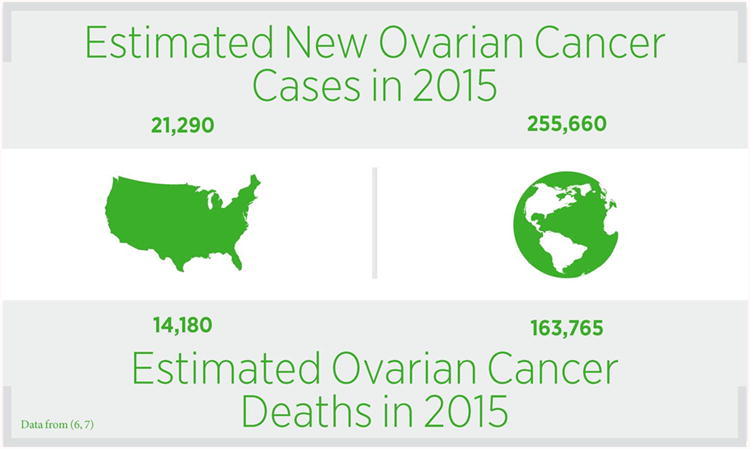
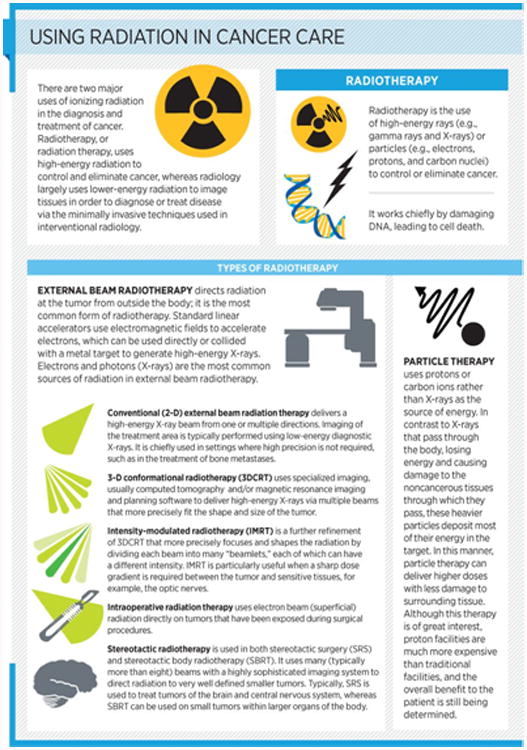
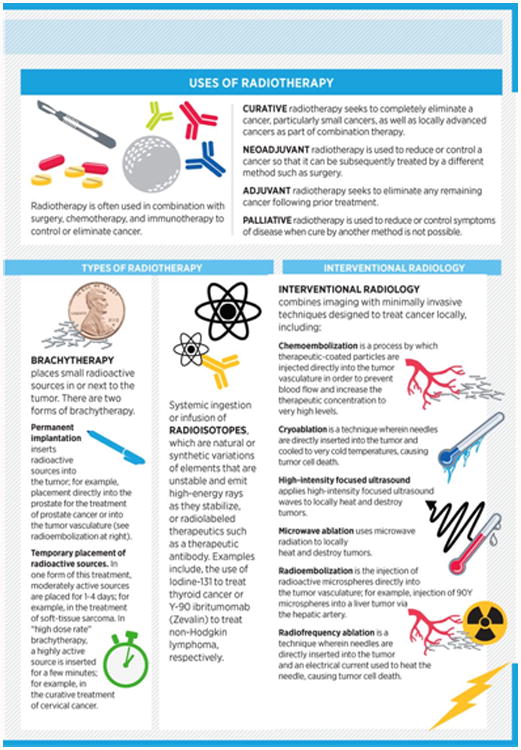
Unfortunately, the majority of ovarian cancers that initially respond to platinum-based chemotherapeutics eventually progress and are said to have become treatment resistant (see sidebar on The Challenge of Treatment Resistance).
In December 2014, the FDA made two decisions that provided a new treatment option for a group of patients with treatment-resistant ovarian cancer. Specifically, the agency approved the molecularly targeted therapeutic olaparib (Lynparza) for women with advanced ovarian cancer who have been previously treated with three or more chemotherapy regimens and who have inherited a specific BRCA1 or BRCA2 gene mutations, as determined by an FDA-approved test, or companion diagnostic (see sidebar on Companion Diagnostics). At the same time, the FDA approved a test to identify the patients for whom olaparib is approved, the BRACAnalysis CDx.
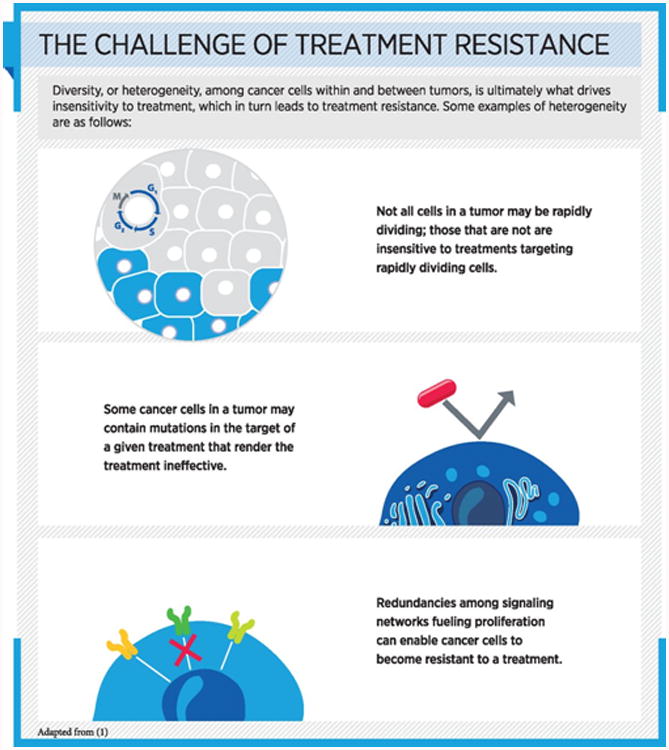
Olaparib is the first in a new class of agents that target poly ADP-ribose polymerase (PARP) proteins, which have a key role in one of the many pathways that cells use to repair damaged DNA (see Figure 15, p. 74). Therefore, blocking PARP proteins with olaparib reduces the ability of a cell to repair damaged DNA.
Figure 15.
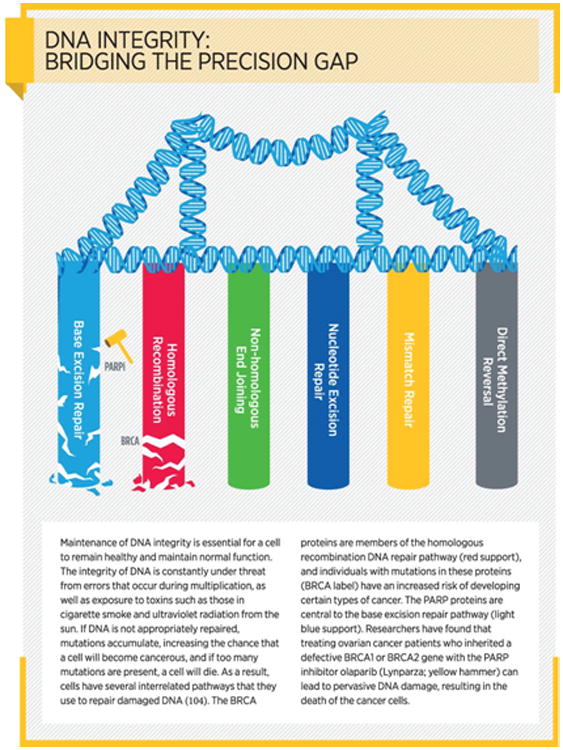
BRCA1 and BRCA2 have a role in a second DNA repair pathway, and many BRCA1 and BRCA2 gene mutations disable this pathway. Thus, the rationale for testing olaparib as a potential treatment for women with advanced ovarian cancer who have inherited a BRCA1 or BRCA2 gene mutation is that having two DNA repair pathways out of action may mean that the ovarian cancer cells are unable to repair DNA damage that accumulates as they multiply (see Developing Cancer, p. 18), and that the accumulating damage will ultimately cause the cancer cells to die (see Figure 15, p. 74).
In fact, blocking PARP with olaparib led to tumor shrinkage or disappearance in a significant number of women with advanced ovarian cancer who had an inherited BRCA1 or BRCA2 gene mutation (107). It is hoped that future studies will reveal that olaparib also extends survival for women with advanced ovarian cancer who inherit a BRCA1 or BRCA2 gene mutation, like Patty Klein (see p. 72).
Keeping Breast Cancer Cells at Bay
Despite major advances made in treating breast cancer, the disease remains the second-leading cause of cancer-related death for women in the United States (6). One recent FDA decision has the potential to power even more progress against breast cancer because it has provided a new treatment option for certain patients with the disease.
The majority of breast cancers are characterized by the presence of proteins called hormone receptors. The growth of these breast cancers is fueled by hormones, which attach in a lock-and-key fashion to the hormone receptors on individual breast cancer cells, stimulating the cells to multiply and survive. This knowledge led to the development of therapeutics like tamoxifen, which blocks the hormone estrogen from attaching to its receptor, and letrozole, which lowers the level of estrogen in the body. Therapeutics like these have been used extremely successfully for decades to treat patients with hormone receptor-positive breast cancer. However, they have limited clinical benefit if disease progresses.
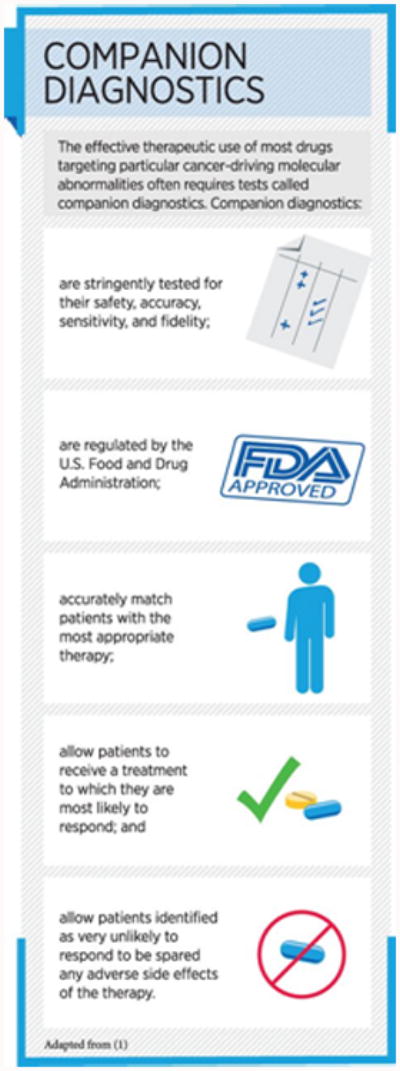
In February 2015, the FDA approved the molecularly targeted therapeutic palbociclib (Ibrance) for use in combination with letrozole for treating postmenopausal women with estrogen receptor–positive, HER-2–negative, advanced breast cancer.
Palbociclib is the first in a new class of agents that block cell multiplication by inhibiting the function of two proteins that play a role in driving this natural process—cyclin-dependent kinase 4 (CDK4) and CDK6 (see Figure 16, p. 78). Its FDA approval was based on early-stage clinical trial results showing that adding palbociclib to letrozole significantly increased the time to disease progression among postmenopausal women with estrogen receptor–positive, HER-2–negative, advanced breast cancer (108), and it is hoped that longer follow-up of these patients, as well as an additional large-scale study that is already underway, will show that this combination of therapeutics also extends survival.
Figure 16.
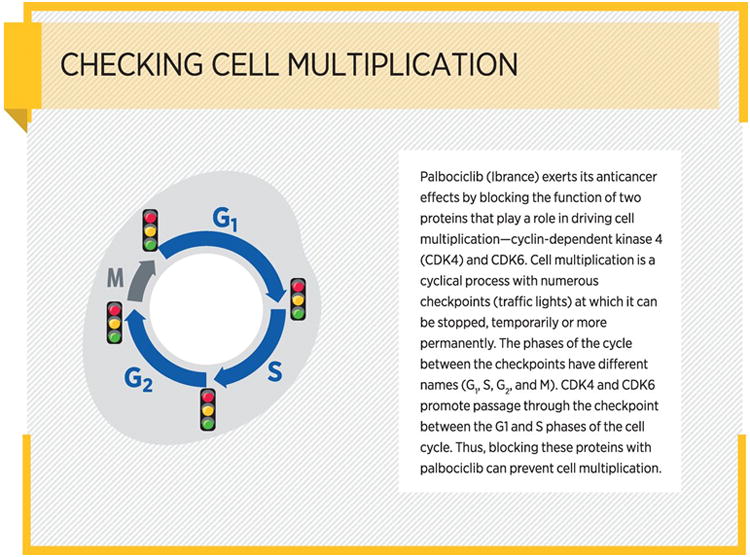
With recent early results from a phase III clinical trial showing that adding palbociclib to another estrogen receptor–targeted therapeutic, fulvestrant, also increases the time to disease progression among postmenopausal women with hormone receptor–positive, HER-2–negative, advanced breast cancer (109), there will undoubtedly be many more women like Janet Klein (see p. 76) who will benefit from palbociclib in the future.
Thwarting the Most Common Form of Skin Cancer
Basal cell carcinoma is the most commonly diagnosed cancer among people of European ancestry (110, 111). Most patients are cured with topical therapy, surgery, radiotherapy, or a combination of these treatments. However, in a small fraction of patients, the disease progresses and becomes extremely challenging to treat.
The discovery two decades ago that genetic mutations leading to overactivation of a signaling pathway, called the Hedgehog pathway, fuel the growth of nearly all basal cell carcinomas led researchers to develop therapeutics that target the Hedgehog pathway (110). The first of these molecularly targeted therapeutics, vismodegib (Erivedge), was approved by the FDA for the treatment of locally advanced or metastatic basal cell carcinoma in January 2012 (84).
A July 2015 decision by the FDA to approve a new Hedgehog pathway–targeted therapeutic called sonidegib (Odomzo) provides a new treatment option for patients with locally advanced basal cell carcinoma that has recurred following surgery or radiotherapy. The decision was based on early results from an ongoing clinical trial showing that more than half of the patients who received sonidegib have had their tumors shrink dramatically (112). It is hoped that with more time, sonidegib will also prove to increase survival for patients with this devastating disease.
Blocking the Blood Supply to Tumors
Research has shown that many solid tumors need to establish their own blood and lymphatic vessel network to grow and survive. It has also led to the identification of many molecules that control the growth of the new blood and lymphatic vessels within a tumor. This combined knowledge has guided the development of 11 anticancer therapeutics that specifically block these many molecules (see Figure 17, see p. 79). These therapeutics are sometimes referred to as antiangiogenic agents.
Figure 17.
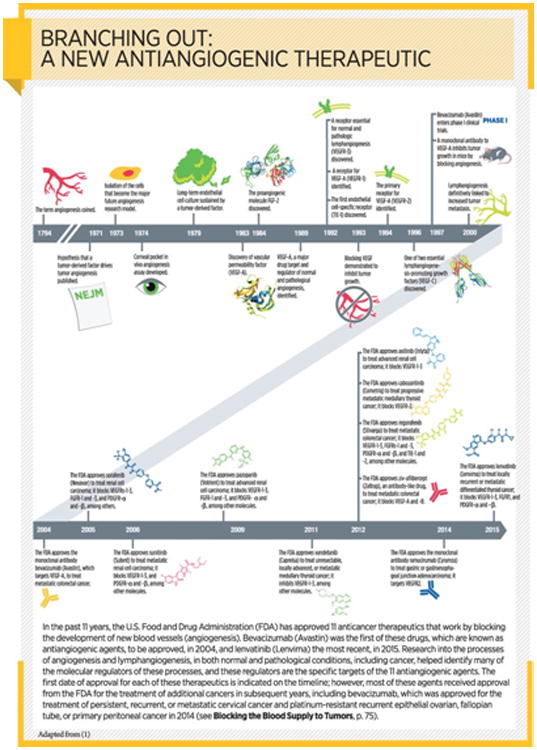
Bevacizumab (Avastin) was the first of this growing class of anticancer therapeutics; it was approved by the FDA for the treatment of metastatic colorectal cancer in 2004. Since then, bevacizumab has been approved for the treatment of a variety of other types of cancer, with the most recent suite of approvals coming 10 years after the first (see Appendix Table 1, p. 10). Specifically, the use of bevacizumab in combination with certain traditional chemotherapeutics was approved for the treatment of persistent, recurrent, or metastatic cervical cancer in August 2014, and for the treatment of platinum-resistant recurrent epithelial ovarian, fallopian tube, or primary peritoneal cancer in November 2014. The fact that adding bevacizumab to treatment with traditional chemotherapeutics provided clinical benefit in phase III clinical trials (113, 114), offers new hope for patients with these diseases.
The newest member of the class is lenvatinib (Lenvima). In February 2015, lenvatinib was approved by the FDA for treating certain patients with thyroid cancer—those with locally recurrent or metastatic differentiated thyroid cancer that has progressed despite radioactive iodine therapy. Differentiated thyroid cancers will account for about 56,205 thyroid cancers newly diagnosed in the United States in 2015. Although many patients with this type of cancer are treated successfully, the 10-year survival rate for those with disease that is refractory to radioactive iodine therapy is just 10 percent from when metastases are detected (115). With results of a phase III clinical trial showing that lenvatinib was effective for almost 65 percent of patients (115), this molecularly targeted therapeutic will undoubtedly transform the lives of many patients with metastatic differentiated thyroid cancer, like Lori Cuffari (see p. 80), in the future.
The FDA recently also approved two new uses for another antiangiogenic agent, ramucirumab (Cyramza). In December 2014, it was approved for some patients with the most deadly form of lung cancer, NSCLC, after it was shown to extend overall survival for patients with metastatic disease in a phase III clinical trial (116). Then, in April 2015, it was approved for use in combination with a suite of traditional chemotherapeutics referred to as FOLFIRI (folinic acid, 5-fluorouracil, and irinotecan) to treat patients with metastatic colorectal cancer. This approval was based on the results of a phase III clinical trial showing that adding ramucirumab to FOLFIRI extended overall survival (117). With ramucirumab having previously been approved for treating metastatic gastric (stomach) cancer and gastroesophageal junction adenocarcinoma, these new approvals both expand the number of patients who may benefit from ramucirumab and increase the return on prior investments in biomedical research.

Targeting the Epigenome
Research has shown that cancer cells have numerous genetic mutations and also profound abnormalities in the patterns of chemical marks, called epigenetic marks, on DNA and histones that control gene accessibility (see Cancer Development: Influences Inside the Cell, p. 20). It has also led to understanding that epigenetic alterations and genetic mutations often work together to promote cancer development. Moreover, after learning that the epigenome is dynamic and naturally changes over time, researchers began investigating whether therapeutics that target the proteins that naturally read, write, and erase epigenetic marks could reverse cancer-associated epigenetic abnormalities and provide clinical benefit.
In fact, there are now six FDA-approved anticancer therapeutics that work by targeting proteins that read, write, or erase epigenetic marks (see sidebar on Editing the Epigenome). Most recently, in February 2015, the FDA approved panobinostat (Farydak) for the treatment of patients with multiple myeloma who have relapsed despite prior treatment with at least two standard therapeutics, including bortezomib and an immunomodulatory agent. The decision was based on the fact that panobinostat increased the average time before disease progressed for patients enrolled in a phase III clinical trial (118).
Treatment With Immunotherapeutics
Since the first AACR Cancer Progress Report was published in 2011, immunotherapy has emerged as one of the most exciting new approaches to cancer treatment that has ever entered the clinic. This is because the number of patients who have benefited from these revolutionary anticancer treatments rose dramatically during this period. As a result of the remarkable patient responses, the number of immunotherapeutics approved by the FDA has also risen, with four being approved in the past year alone, from Aug. 1, 2014, to July 31, 2015.
Cancer immunotherapy refers to agents that can unleash the power of a patient's immune system to fight cancer the way it fights pathogens. Not all immunotherapeutics work in the same way (see sidebar on How Immunotherapeutics Work, p. 83).
Given that our scientific understanding of the immune system and how it interacts with cancer cells is rapidly increasing, we can expect to soon see novel immunotherapeutics as well as new ways to use those that we already have. With many current immunotherapeutics yielding remarkable and durable responses for some patients, and new agents and treatment strategies on the horizon, immunotherapy holds extraordinary promise for the future—potentially even cures for some patients.
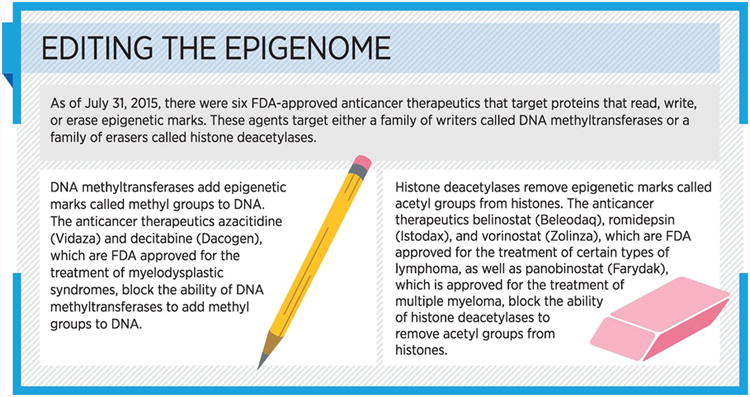
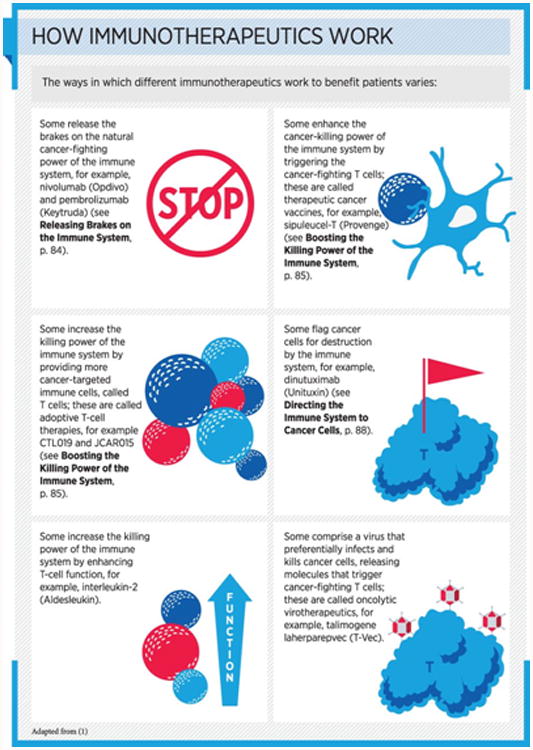
Releasing the Brakes on the Immune System
Through research we have learned that immune cells called T cells are naturally capable of destroying cancer cells. We have also learned that some tumors evade destruction by T cells because they have high levels of proteins that can trigger the brakes on T cells, stopping them from attacking the cancer cells, and that these tumor proteins work by attaching to complementary proteins, called immune checkpoint proteins, on the surface of T cells.
This knowledge has led researchers to develop immunotherapeutics, called checkpoint inhibitors, which prevent tumor proteins from attaching to immune checkpoint proteins, thereby releasing the brakes on T cells. The first immune-checkpoint inhibitor to be developed was ipilimumab (Yervoy). It was approved by the FDA in 2011 for the treatment of metastatic melanoma after it was shown to be the first treatment ever to extend overall survival for patients with this deadly disease (119). Long-term follow-up has shown that about one in every five patients treated with ipilimumab survives for more than three years and that the risk of death from melanoma for these patients is very low (120).
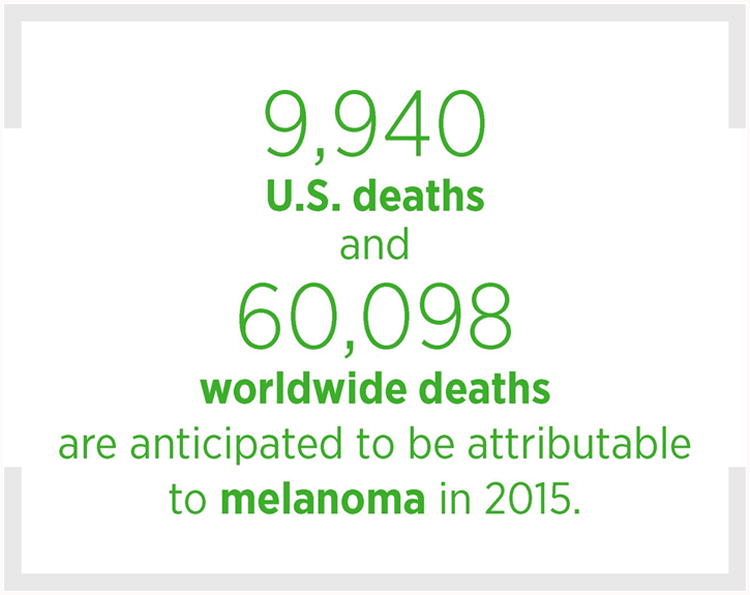
Motivated by the success of ipilimumab, which has saved the lives of many patients with metastatic melanoma, like Andrew Messinger (who was featured in the AACR Cancer Progress Report 2013; see Ref. 28), and the need to provide new treatment options for patients who do not respond long-term to ipilimumab, researchers focused on targeting a second checkpoint protein, called PD-1, as well as one of the proteins that attaches to PD-1, PD-L1. As a result of three recent FDA decisions, two of these novel immunotherapeutics are now treatment options for some patients with melanoma, and one is a treatment option for some patients with lung cancer.
The first two decisions, both in the second half of 2014, were the approvals of the PD-1 checkpoint inhibitors pembrolizumab (Keytruda) and nivolumab (Opdivo) for the treatment of metastatic melanoma that has progressed despite treatment with ipilimumab. These approvals were the result of clinical trials showing that pembrolizumab and nivolumab benefited more than 25 percent of patients (121, 122). Subsequent studies showed that many patients with ipilimumab-refractory metastatic melanoma, like Richard Murphy (who was featured in the AACR Cancer Progress Report 2014; see Ref. Ref. 1), continued to benefit from these immunotherapeutics more than one year after starting treatment (123, 124).
More recently, results from two phase III clinical trials—one comparing pembrolizumab with ipilimumab and one comparing nivolumab with ipilimumab—showed that pembrolizumab and nivolumab were both more effective than ipilimumab for patients with metastatic melanoma that had not been treated previously with a checkpoint inhibitor (125, 126). This suggests that pembrolizumab and nivolumab might soon be approved not only for patients whose metastatic melanoma has progressed after ipilimumab treatment, but also for those who have not yet received ipilimumab, and the FDA recently granted this use of nivolumab priority review (see sidebar on FDA's Expedited Review Strategies, p. 60).
The third FDA decision, in March 2015, was the approval of nivolumab for treating a certain group of patients with metastatic non-small cell lung cancer (NSCLC) that has progressed despite treatment with a traditional platinum-based chemotherapeutic. Specifically, it was approved for those patients with the squamous cell type of NSCLC, which accounts for about 25 to 30 percent of all lung cancers diagnosed in the United States, after it was shown in a phase III clinical trial to extend overall survival for patients with this deadly disease (127).
Recently, nivolumab was shown to benefit not only patients with squamous NSCLC, but also those with the more common nonsquamous NSCLC like Donna Fernandez (see p. 86) (128). Pembrolizumab and an immunotherapeutic that targets PD-L1—atezolizumab (previously known as MPDL3280A)—have also been shown to benefit patients with both types of NSCLC (129, 130), and the FDA has granted both of these agents breakthrough designation for the treatment of NSCLC. Thus, it is likely that we will hear more about targeting PD-1 and PD-L1 as a treatment for NSCLC in the very near future.
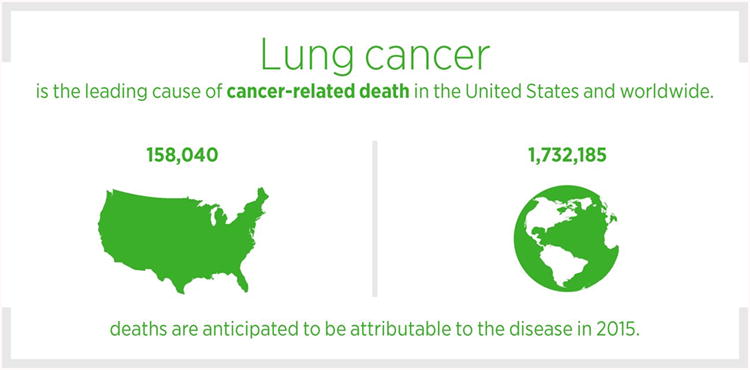
Beyond melanoma and NSCLC, pembrolizumab, nivolumab, and atezolizumab are being tested in clinical trials as a potential treatment for many other types of cancer. Results are available for only some of them. For example, clinical trial results show one or more of these PD-1/PD-L1–targeted immunotherapeutics benefit some patients with bladder cancer (131, 132), gastric (stomach) cancer (133), head and neck cancer (134), Hodgkin lymphoma (135), and renal cell carcinoma (136). Although many of the results are preliminary, results for nivolumab as a potential treatment for Hodgkin lymphoma and for atezolizumab as a potential treatment for bladder cancer are sufficiently promising that the FDA has granted them breakthrough therapy designations.
Despite the spectacular successes, treatment with ipilimumab and PD-1/PD-L1–targeted immunotherapeutics does not yield remarkable and long-term responses for all patients. In an effort to increase the number of patients who may benefit from these immunotherapeutics, researchers are testing combinations of checkpoint inhibitors and combinations of immunotherapeutics that work in different ways. In fact, treatment of metastatic melanoma with a combination of ipilimumab and nivolumab is currently under priority review at the FDA (see sidebar on FDA's Expedited Review Strategies, p. 60) after it was shown to benefit significantly more patients than ipilimumab alone (137).
In addition, recent research suggests that traditional chemotherapeutics and certain forms of radiotherapy may themselves be immunostimulatory. Therefore, researchers are investigating whether the utility of immune-checkpoint inhibitors can be expanded by combining members of this burgeoning class of immunotherapeutics with traditional chemotherapeutics and radiotherapy.
Boosting the Killing Power of the Immune System
Another approach to cancer immunotherapy is to enhance the ability of T cells to eliminate cancer cells. If we think of checkpoint inhibitors as releasing the brakes on the immune system, these immunotherapeutics step on the accelerator, and they work in several ways (see sidebar on How Immunotherapeutics Work, p. 83). These cancer treatments are showing great promise for improved patient care; however, all the breakthroughs discussed here are still in clinical development and have not yet been approved by the FDA.
One way to boost the killing power of the immune system is through adoptive T-cell therapy. During this complex medical procedure, T cells are harvested from a patient, expanded in number and/or genetically modified in the laboratory, and then returned to the patient, where they attack and potentially eliminate the cancer cells (see sidebar on Types of Adoptive T-Cell Therapies, p. 88).
CAR T–cell therapy is a form of adoptive T-cell therapy that has been particularly successful for adults and children with acute lymphoblastic leukemia (ALL) that has progressed despite several other forms of treatment. In fact, recent reports indicate that about 90 percent of patients with relapsed ALL who receive CAR T–cell therapy experience complete remissions (138, 139). Even though only some patients have remained in remission long term, these results provide hope for a group of patients who have few treatment options, and the FDA has granted two CAR T–cell therapies, CTL019 and JCAR015, breakthrough therapy designation for the treatment of ALL.
Motivated by the success of CAR T–cell therapy as a treatment for ALL, researchers are working to develop CAR T cells that will target other types of cancer, including some types of non-Hodgkin lymphoma, multiple myeloma, and some solid tumors (140, 141). This research is in the very early stages, but there are promising signs that CAR T–cell therapies will emerge as a viable treatment option in the future for patients with a variety of cancer types.
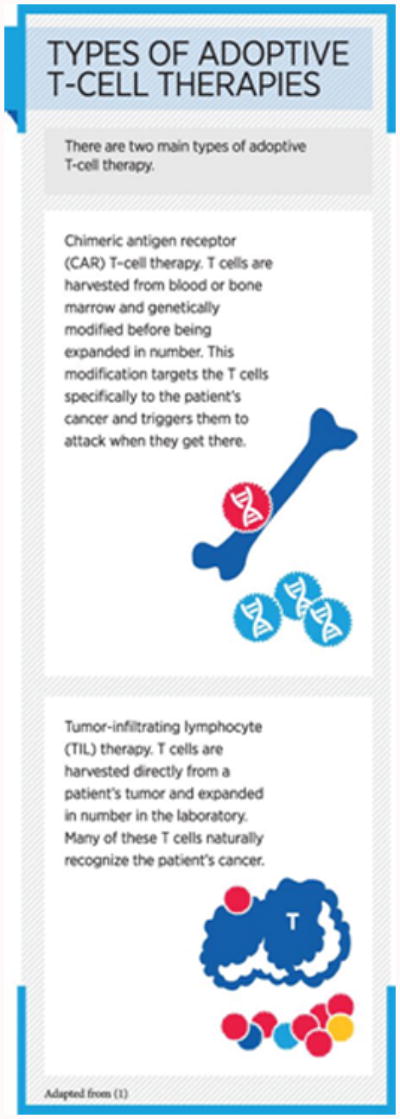
Another way to boost the killing power of the immune system is with therapeutic cancer vaccines. These immunotherapeutics train a patient's T cells, while they are inside the patient's body, to recognize and destroy the patient's cancer cells. One therapeutic cancer vaccine, sipuleucel-T (Provenge), has been available since 2011 for the treatment of some patients with prostate cancer, but there are many therapeutic cancer vaccines now being tested in clinical trials, although results are not currently available for most of these vaccines.
One clinical trial that has recently reported results found that a combination of two therapeutic cancer vaccines, CRS-207 and GVAX Pancreas, extended survival for patients with advanced pancreatic cancer (142), and this combination of immunotherapeutics has been granted breakthrough therapy designation by the FDA for the treatment of this deadly condition.
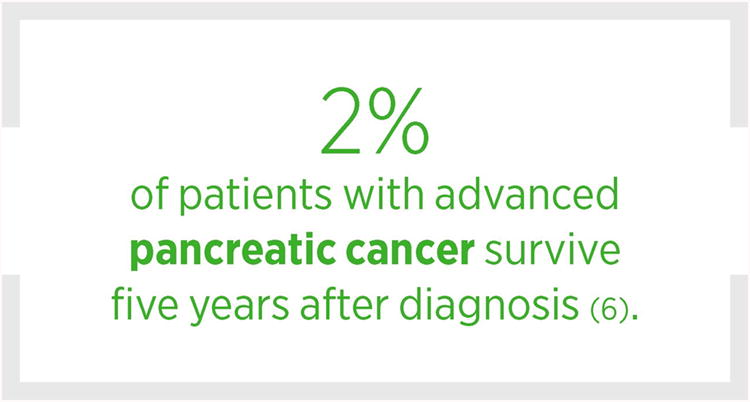
Directing the Immune System to Cancer Cells
An immune cell must find a cancer cell before it can destroy it. Many therapeutic antibodies that have been approved by the FDA for the treatment of various types of cancer (see Appendix Table 1, p. 122) work, at least in part, by helping immune cells find cancer cells. The most recent therapeutic antibody to be added to this group of immunotherapeutics is dinutuximab (Unituxin), which works by attaching to a protein, GD2, on neuroblastoma cells and flagging them for immune cells, which upon attaching to another part of dinutuximab are triggered to destroy the neuroblastoma cells.
Dinutuximab, which was previously called ch14.18, was approved by the FDA in March 2015 for treating children with high-risk neuroblastoma that has progressed after responding to prior treatments. The approval was based on clinical trial results showing that adding dinutuximab and two immune system–boosting agents—granulocyte-macrophage colony-stimulating factor and interleukin-2 (see sidebar on How Immunotherapeutics Work, p. 83)—to standard 13-cis-retinoic acid (RA) treatment significantly extended overall survival (143).

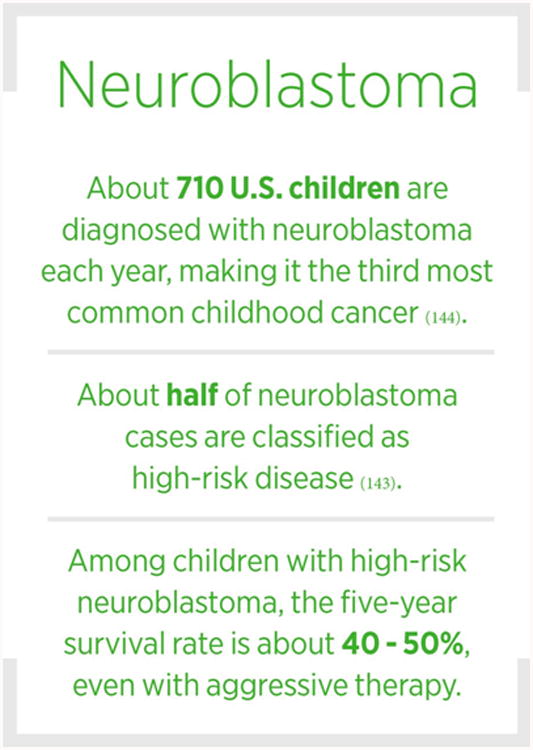
Children like Elizabeth Buell-Fleming (see p. 90) have benefited from dinutuximab; however, treatment with this immunotherapeutic is associated with significant toxicities. These toxicities can be so severe that some children do not complete the course of treatment. Consequently, researchers are looking to identify ways to pinpoint more precisely those children most likely to benefit from dinutuximab, so that those unlikely to respond can be spared the potential adverse effects of this treatment.
Because of the effectiveness and promise of antibody-based immunotherapeutics, many researchers have been working to develop both new as well as improved versions of this important class of anticancer therapeutics.
One such therapeutic is the first of a new class of antibody-based immunotherapeutics called bispecific T cell–engager (BiTE) antibodies, blinatumomab (Blincyto) was approved by the FDA in December 2014 for treating certain patients with a type of ALL called B-cell ALL.
BiTE antibodies function as a connector, bringing T cells into close proximity with cancer cells, which are then eliminated by the T cells. Blinatumomab attaches to a molecule called CD3 on T cells and to CD19, a molecule found on the surface of most B-cell ALL cells. By attaching to these molecules on the different cells, blinatumomab brings the two cell types together, directing the T cells to home in on the B-cell ALL cells.
The approval of blinatumomab for treating adults who have precursor B-cell ALL that has progressed despite a prior form of treatment and that has a molecular profile characteristic of poor outcomes (it lacks the Philadelphia chromosome) was based on results from a clinical trial showing that the novel immunotherapeutic was effective in more than 30 percent of patients (145). Historically, precursor B-cell ALL that has progressed following initial treatment has been extremely challenging to treat. In fact, even with intensive therapy, the median survival is between three and six months. Thus, the approval of blinatumomab provides patients like Sergio Ramirez (see p. 92) with new treatment options and new hope.
Living With or Beyond Cancer
Research is powering advances in cancer detection, diagnosis, and treatment that are helping more and more people to survive longer and lead fuller lives after a cancer diagnosis. According to the latest estimates, almost 14.5 million U.S. residents with a history of cancer were alive on Jan. 1, 2014, compared with just 3 million in 1971, and this number is projected to rise to 19 million on Jan. 1, 2024 (3, 5). About 3 percent of these individuals, including Jay Steiner (see p. 96), received their cancer diagnosis as a child or adolescent (ages 0–19) (144) (see sidebar on Surviving a Cancer Diagnosis as a Child or Adolescent, p. 94).
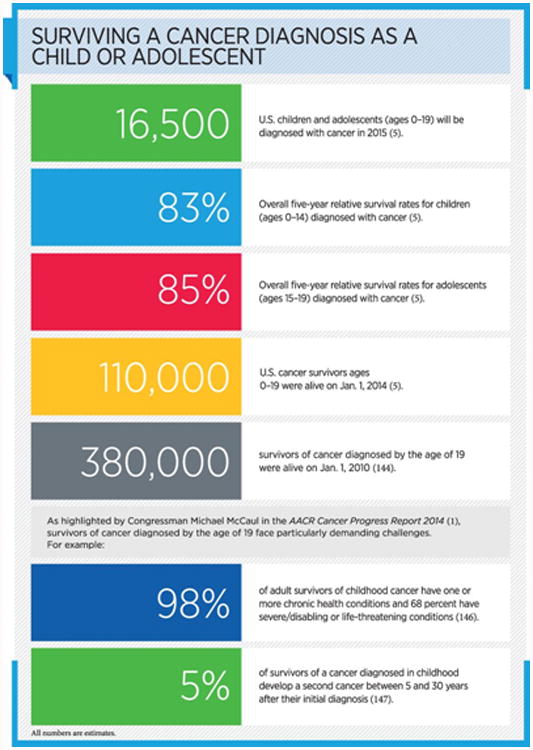
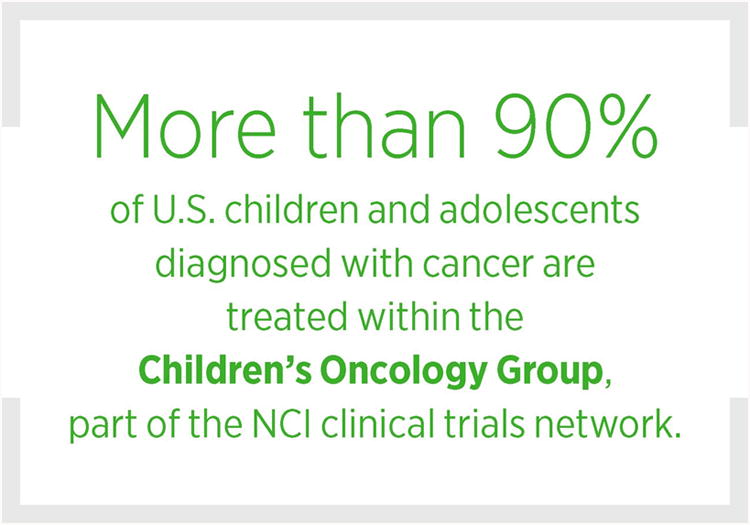
Every cancer survivor has a unique experience and outlook, which can range from successful treatment and living cancer free for the remainder of his or her life to living continuously with cancer for the remainder of life. Therefore, not all people who receive a cancer diagnosis identify with the now commonly used term “cancer survivor.”
Cancer survivorship encompasses three distinct phases: the time from diagnosis to the end of initial treatment, the transition from treatment to extended survival, and long-term survival. Recent progress in treating cancer was discussed in the previous two sections of the report (see Treatment With Molecularly Targeted Therapeutics, p. 63, and Treatment With Immunotherapeutics, p. 82). Here, the discussion focuses on recent advances that can help improve outcomes and quality of life for individuals in each distinct phase of cancer survivorship and highlights some of the challenges they continue to face.
Each phase of cancer survivorship can be challenging for different reasons (see sidebar on Life After a Cancer Diagnosis in the United States, p. 98). Moreover, the issues facing each cancer survivor are unique and depend on many factors, including gender, age at diagnosis, type of cancer diagnosed, general health at diagnosis, and type of treatment received. Importantly, it is not just cancer survivors who are affected after a cancer diagnosis, but also their caregivers. In fact, research has shown that caregivers are at risk for poor health outcomes, with one recent study finding that the health and well-being of cancer survivors can be affected by the mood and quality of life of their spouses, who are often the primary caregivers (148). As such, incorporating caregiver care into survivorship programs may improve outcomes and quality of life for cancer survivors.
Molecularly Targeting a Side Effect of Advanced Cancer
One side effect of cancer experienced at some point during the course of their disease by up to 30 percent of individuals who receive a cancer diagnosis is hypercalcemia of malignancy (149). Hypercalcemia, or elevated levels of calcium in the blood, is particularly common among patients with advanced cancer and indicates a particularly poor outlook. If left untreated, hypercalcemia of malignancy leads to kidney failure, progressive mental impairment, coma, and ultimately death.
The discovery that hypercalcemia of malignancy is often caused by cancer-driven release of calcium from bone led researchers to test whether the condition could be treated using the therapeutic antibody denosumab (Xgeva), which targets a protein called RANKL on certain bone cells, ultimately causing a decrease in calcium release. After clinical trials showed that denosumab rapidly lowered blood calcium levels in more than half of patients and that the response lasted about 3.5 months (150), in December 2014 the FDA approved the molecularly targeted therapeutic for the treatment of hypercalcemia of malignancy that is not responding to standard treatments.
As a result of the effects of denosumab on bone, the molecularly targeted therapeutic had previously been approved for treating postmenopausal women with osteoporosis who are at high risk for fractured bones and individuals with giant cell tumor of bone, as well as for the prevention of fractures caused by cancer metastases to the bone. Thus, the FDA approval of denosumab for the treatment of hypercalcemia of malignancy not only benefits patients with this lethal condition, but also increases the return on prior investments in biomedical research.
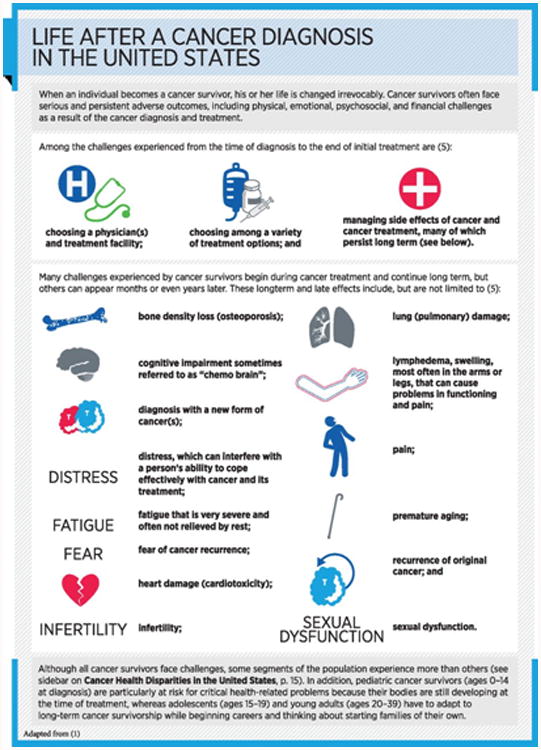
Modifying Behaviors to Improve Outcomes
Major concerns for all cancer survivors who successfully complete their initial treatment include whether their cancers will return or cause their death and whether their cancers and/or cancer treatment will diminish their quality of life. Many factors related to lifestyle that increase a person's risk of developing cancer can also increase risk of cancer recurrence, reduce survival time, and negatively affect quality of life for cancer survivors (see Figure 8, p. 34). Thus, modifying behaviors to eliminate or avoid these risk factors can improve outcomes and quality of life for cancer survivors.
For example, research shows that quitting smoking can improve outcomes for cancer survivors; it reduces risk of death from cancer and it also reduces risk for developing a second cancer (36). Even in the face of this knowledge, a recent study found that 9 percent of cancer survivors continued to smoke (151). Therefore, enhanced provision of cessation assistance to all patients with cancer who use tobacco or who have recently quit, and further research to improve our understanding of how best to help individuals quit smoking is urgently needed (152).
Evidence is also beginning to emerge that obesity can increase risk of cancer recurrence among survivors of several types of cancer including breast, colorectal, prostate, and urothelial bladder cancers (153-156), whereas regular aerobic exercise can reduce recurrence and mortality in survivors of early breast, prostate, and colorectal cancers (157). More recently, results from a clinical trial show that breast cancer survivors who participated in a weight training program had increased muscle strength and experienced less deterioration of physical function (158, 159). This is important because deterioration of physical function and loss of muscle strength have been linked to increased risk for bone fractures and other health issues that limit quality of life.
Unfortunately, modifying behavior can be as difficult for cancer survivors as it is for otherwise healthy individuals, and more research is needed to understand how best to help cancer survivors improve their chances of good outcomes.
The Importance of Patient-reported Outcomes
As researchers are learning more about the biology of cancer and translating this knowledge into new and improved ways to prevent, detect, and treat cancer, it is becoming increasingly clear that the pace at which further advances are made will be accelerated by enhanced patient engagement throughout the continuum of research and care.
The phase of the biomedical research cycle in which patient engagement is highest is clinical trials. In addition to direct measurements of patient status, a growing number of trials also include a patient-reported outcome endpoint. Patient-reported outcomes are reports of the status of a patient's health condition directly from the patient. Such reports are valuable not only to the treating physicians, but also to regulators and drug developers. The importance of this aspect of clinical trials is increasingly being recognized as integral to the success of a clinical trial, and in November 2011, the FDA approval of (Jakafi) ruxolitinib for the treatment of myelofibrosis was based in part on patient reports of the positive impact of the molecularly targeted therapeutic on their symptoms (160).
Improved implementation of patient-reported outcomes into all phases of care of cancer survivors is essential if we are to gain a more complete picture of the safety and efficacy of newly approved anticancer therapeutics (see Increasing Patient Participation in Precision Medicine Initiatives, p. 106).
What Progress and Promise Does the Future Hold?
In This Section You Will Learn:
Research, in Particular Cancer Genomics Research, Will Continue to Revolutionize Precision Medicine, Including Expanding the More Precise Use of Existing Therapies.
Liquid Biopsies Hold Great Promise For Cancer Detection, Monitoring Patient Status, Predicting Patient Outcomes, and Changing Therapeutic Strategies in Real Time.
Research Advances May Eventually Enable the Development of Precision Medicines for All Potential Therapeutic Targets.
Research has powered spectacular advances against cancer, and many more people are living longer and leading fuller lives after a cancer diagnosis than ever before. Even with this progress, it is estimated that in 2015 alone more than 1.65 million U.S. residents will receive a cancer diagnosis and more than 589,000 will die from the disease (6). Worldwide, it is predicted that in 2015 there will be 15.2 million new cases of cancer and 8.9 million deaths from this insidious disease (7). Given this enormous burden of cancer, it is clear that more research is required if we are to make future lifesaving progress.
Many researchers, however, including AACR President (2015–2016) José Baselga, MD, PhD (see p. 102), think that the best is yet to come, as the explosion of new knowledge about cancer and the exciting technological advances, along with our ever-increasing understanding of how to apply them, will further revolutionize cancer care.
Research in cancer genomics and its application in the clinic are the foundation of precision medicine. Cancer genomics research has dramatically increased the number of known cancer-associated genomic alterations and has thereby yielded an explosion of potential targets for the development of novel precision anticancer therapeutics. The pace of this progress is expected to not only continue, but also accelerate in the coming years, and it will be essential to engage computational biology and bioinformatics researchers more fully if we are to efficiently analyze the information and identify the targets with the most therapeutic potential (see Going Big, p. 30).
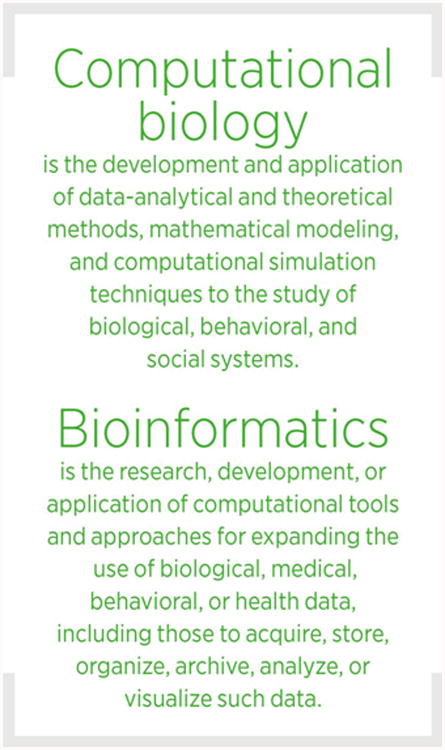
In addition to identifying new potential therapeutic targets, cancer genomics research may help identify markers of response to all forms of treatment (see Retooling, p. 28). This information has the potential to change patient care, because it could allow physicians to more precisely identify those patients most likely to benefit from a given treatment, including our current toolkit of anticancer agents. Moreover, those patients identified as unlikely to respond could be spared the potential harm of the treatment and immediately start an alternative treatment, saving them precious time in their race to find an effective therapy.
One area where genomics holds immense promise is in increasing the precision with which we use immunotherapeutics (see Treatment With Immunotherapeutics, p. 82), in particular immune-checkpoint inhibitors, where markers predictive of response have been challenging to identify. Two recent studies have highlighted the exciting potential of this approach, although they are early studies that need further validation before the results can be translated into the clinic. In the first study, large-scale genomics was used to identify a genetic signature of melanoma response to ipilimumab (161), whereas in the other, the presence of certain genetic mutations in colorectal cancers predicted response to pembrolizumab (162).
Despite immense progress, many tumors eventually develop resistance to current treatments, and the disease progresses (see sidebar on The Challenge of Treatment Resistance, p. 70). Cancer genomics research has the potential to help physicians manage the care of patients during the course of their treatment by identifying markers that are predictive of the emergence of tumor resistance. The power of this information to transform patient care could be dramatically enhanced by pairing knowledge of genetic markers of tumor resistance with emerging technologies, sometimes called liquid biopsies.
Research has shown that during the course of cancer development and treatment, tumors routinely shed cells, lipid-encapsulated sacs called exosomes, as well as free DNA into a patient's blood. Liquid biopsies use technological advances to capture and analyze these blood-borne tumor derivatives, including any cancer-associated genomic alterations that may be contained within them. In this way, a blood sample, rather than a biopsy of the tumor tissue itself, could be used to more easily analyze genomic alterations in a patient's cancer. Currently, liquid biopsies are predominantly used in clinical research, but they provide great hope that physicians may soon have noninvasive ways to repeatedly sample the genome of a cancer so that they can tell quickly whether a cancer is responding to treatment or becoming treatment resistant and, if it is developing resistance, what treatment might be the most appropriate next option.
Although there are currently more than 50 FDA-approved therapeutics that target specific molecules involved in the development and progression of cancer, for other potential therapeutic targets identified by cancer genomics research or other fields of research it has proven extremely challenging to develop precision medicines with which to modify them for patient benefit. There are many reasons for this; however, numerous initiatives aim to expand our understanding of these potential targets, which are sometimes referred to as undruggable, and to develop ways to overcome the challenges of developing effective therapeutics that could be used to treat the patients whose tumors harbor them. The goal of one such initiative, the RAS Initiative—launched by the NCI in 2013—is to improve treatment, diagnosis, and prevention of cancers driven by mutant RAS genes (163). Given that RAS genes are among the most frequently mutated genes in human cancers (164), including almost all pancreatic ductal adenocarcinomas (165), this initiative, if successful, has the potential to improve the lives of millions of individuals worldwide.
These are only a few examples of the extremely bright future of precision medicine.

Building Blocks to Further Precision Medicine
In This Section You Will Learn:
Increasing Federal Support for Biomedical Research is Crucial to Advancing Precision Medicine and Making Continued Progress Against Cancer.
Regulatory Science and Policy play A Key Role in Advancing Precision Medicine and Making Continued Progress Against Cancer.
Federal Support is Needed to Continue to Develop and Train the Biomedical Research Workforce of Tomorrow.
Patient and Caregiver Perspectives Need to be Considered as an Integral Part of Advancing Precision Medicine.
Precision Medicine can Play an Important Role in the Prediction and Prevention of Disease.
Thanks to the efforts of countless researchers across the entire biomedical research continuum, we have made great progress in our understanding of the molecular and genetic mechanisms underlying the collection of diseases that we call cancer, which in turn has made possible the development of new methods for preventing, detecting, diagnosing, and treating cancer.
In fact, in the 12 months between Aug. 1, 2014, and July 31, 2015, the FDA approved nine new anticancer therapeutics, one new cancer prevention vaccine, and one new cancer screening test (see Table 1, p. 10). During this period, the FDA also approved new uses for six previously approved anticancer therapeutics and one imaging agent.
This progress would not have been possible without federal support for the NIH, NCI, and FDA.
Nowhere is this progress more apparent than in the emerging field of precision medicine. At its very essence, precision medicine is treating patients based on the characteristics that distinguish that individual from other patients with the same disease, and the field of oncology has been leading the way in the development of precision treatments (see Treating Cancer More Precisely, p. 23).
On Jan. 30, 2015, President Obama announced plans for a new Precision Medicine Initiative that would capitalize on the existing foundation of precision oncology, with the goal of extending precision medicine treatments to all forms of cancer and many other diseases. Making this a reality will require robust, sustained, and predictable funding increases for the NIH and NCI, who are leading this effort. Additionally, it is essential to develop mechanisms to involve patients more directly in the development of new treatments (see sidebar on Building Blocks to Further Precision Medicine).
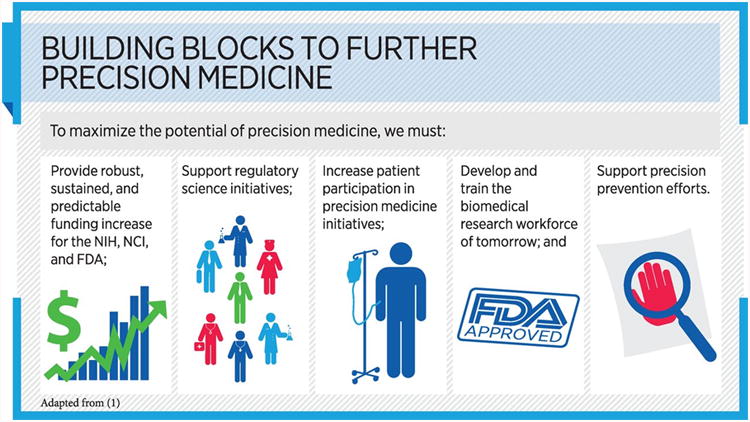
Robust, Sustained, and Predictable Funding Increases for Biomedical Research
Federal grants from the NIH and NCI represent the lifeblood of biomedical research and form the foundation upon which the majority of scientific and medical discoveries are made. Bipartisan support for the NIH and NCI since President Nixon signed the National Cancer Act into law 44 years ago has resulted in extraordinary progress against cancer, as detailed in this report. In addition to saving lives, the federal investments in cancer research have also spurred our economy by creating jobs and establishing entirely new industries, such as the biotechnology industry.

Although prior federal investments in the NIH and NCI have led to significant progress, the purchasing power of the NIH has decreased by 25 percent since 2004 (see Figure 18, p. 106). To regain momentum and accelerate the pace of progress, we must provide the NIH and NCI with the resources it needs to continue to fund lifesaving research.
Figure 18.
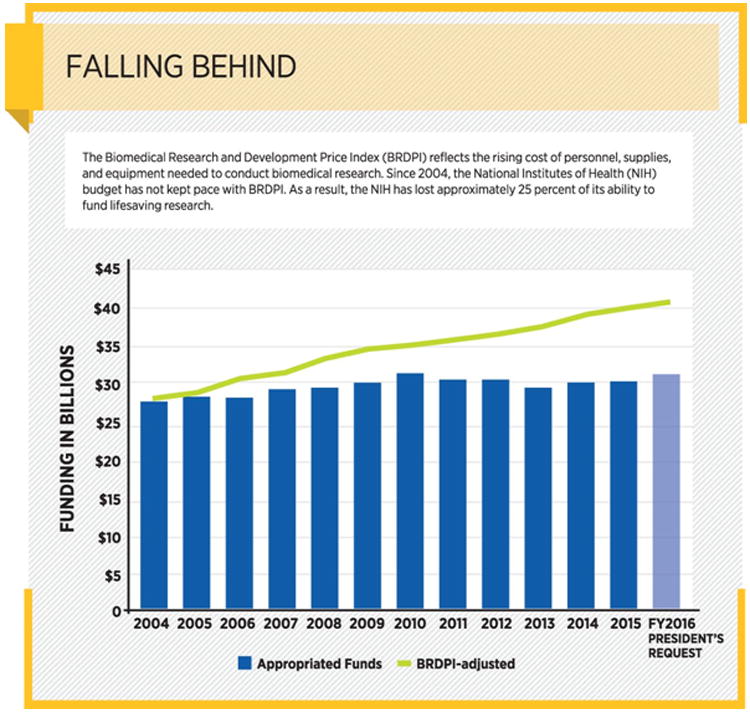
Enhancing Support for Regulatory Science and Policy Activities at the FDA
The FDA represents an integral part of the biomedical research community (see sidebar on The Biomedical Research Community, p. 9), and the support of this critical agency through government funding is crucial in continuing our progress against cancer and the delivery of safe, effective, and precise medicines to patients residing in the United States.
To keep pace with the rapid progress we are seeing in biomedical research, particularly in the area of precision medicine, the FDA is increasingly focused on advancing regulatory science, which is the study of developing new tools, standards, and approaches to assess the safety, efficacy, quality, validity, and performance of medical products. The regulatory science initiatives of the FDA are aimed at promoting and developing evidence-based regulatory policies that balance innovation and the expedited approval of medical products with patient safety (166).
It is imperative that the FDA is supported in its efforts to keep abreast of the latest scientific and technological progress through discourse, cooperation, and collaboration with academia, industry, patient advocacy groups, and the government.
Therefore, to achieve the aforementioned goals, Congress and the administration must equip the FDA with the resources the agency needs to support the regulatory processes and professional development of staff.
Increasing Patient Participation in Precision Medicine Initiatives
The significant progress made in our understanding of the biology of cancer has led to the advent of precision medicine (see Figure 5, p. 27; Transforming Lives Through Precision Medicine, p. 53). To fully realize the promise of precision medicine, patients should be equal partners in this initiative. Patients are already involved in various aspects of biomedical research through their participation in activities including clinical trials and grant review, and as members of Institutional Review Boards (IRB) and advisory committees. To make the development of new precision medicine treatments more patient-centric, we need to better understand how patients are engaged in their own treatment decisions.
Through its Patient-focused Drug Development initiative (169), the FDA has formally started gathering patient and caregiver perspectives related to his or her disease burden, impact on quality of life, and unmet needs. Efforts such as these, which better integrate the patient perspective into research, clinical trials, and the review and approval processes, should be encouraged so that patients can become equal partners in our joint quest for better treatments.
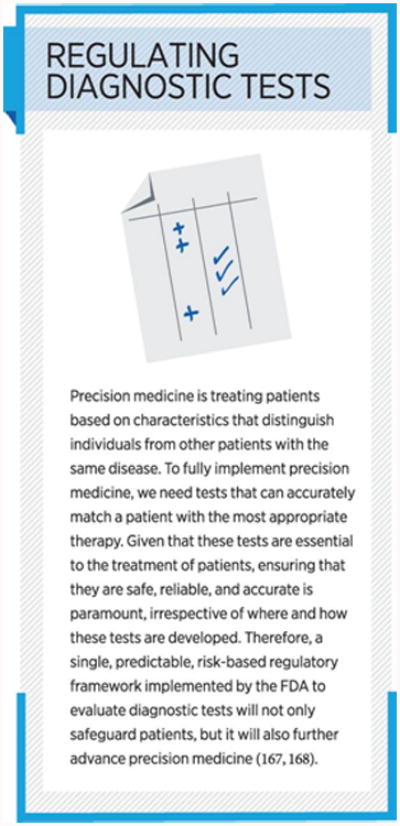
Leadership in the Local and Global Economies
The impact of federal support for the NIH, NCI, and FDA reaches well beyond the research laboratory and the clinic. The medical research enterprise supports hundreds of thousands of jobs in communities across the United States, and for every dollar invested in the NIH, an estimated $2.21 is returned in the form of local economic growth (170). The discoveries that are fueled by these investments have led to the remarkable progress that we have seen in areas such as precision medicine. For example, the sequencing of the human genome has been hailed by many as the landmark scientific achievement of the 20th century. These types of breakthroughs have positioned the United States as the world leader in biomedical research.
This leadership position, however, is in jeopardy, as federal investments in biomedical research have been flat since 2004, while other countries are investing significantly in science, technology, and biomedical research (171). Thus, to maintain the pace of scientific progress for patient benefit, we must follow suit. Such a renewed investment in biomedical research would strengthen the position of the United States as the global leader in science and technology and would ensure U.S. economic leadership in the 21st century.
Developing and Training the Workforce of Tomorrow
Performing world-class research requires recruiting, training, and retaining the best minds across multiple disciplines, and this means providing adequate support in the form of training and research grants that will support individual researchers at all stages of their careers. Since 2003, stagnant funding for the NIH and NCI has resulted in a steady decline in the ability of these institutions to award research grants. In fact, in 2014, a grant application to the NCI had a one-in-seven chance of being funded, one of the lowest “success rates” on record for the NCI (172).
For researchers who are just beginning their careers, securing a federally funded grant is essential for their ability to continue a career in research. For more established researchers, failure to renew their grant funding can leave them unable to support new graduate students, postdoctoral scientists, and expert laboratory staff. This entire situation underscores the importance of providing robust, sustained, and predictable increases to the NIH and NCI.
Precision Prevention
It has been estimated that more than 50 percent of all U.S. cancer cases could be prevented through a combination of lifestyle modification and regular screening (173). Therefore, the best way to reduce death and disability due to these particular cancers is to take some of the necessary steps to prevent the disease from happening in the first place (see Preventing Cancer From Developing, p. 33). Just as we are using precision medicine to determine which patients are likely to respond to which drugs, we are also becoming more sophisticated in using individual and population-wide data to predict the risk of a particular person developing cancer.
One of the best-known examples of using an individual's genetic information to predict his or her chances of developing cancer is the connection between certain mutations in the BRCA1 and BRCA2 genes and hereditary breast and ovarian cancers. Behavioral and environmental data can also provide a wealth of information that can be used in cancer prevention and control. In addition, in those cases where the cause of a particular cancer is well understood, precise strategies aimed at reducing cancer risk can result in preventing cancer before it even starts. A good example of this is the HPV vaccine, which has been directly linked to reducing the risk of developing cervical cancer (see sidebar on How Do the Three FDA-approved HPV Vaccines Differ? p. 61).
One of the biggest and most well-studied risk factors for cancer is tobacco use, and thanks to the wealth of research demonstrating the health consequences of tobacco use, we have seen dramatic progress in the area of tobacco control through the implementation of policies and educational initiatives aimed at preventing use and facilitating cessation (see Figure 9, p.35). One relatively recent development is the increasing popularity of e-cigarettes and other electronic nicotine delivery systems (ENDS). Researchers are still working to understand the full impact of e-cigarettes on health (see sidebar on E-cigarettes: What We Know and What We Need to Know, p. 38). However, a significant concern is that ENDS may be harmful, particularly to youth, if they increase the likelihood that nonsmokers or former smokers will use combustible tobacco products, or if they discourage smokers from quitting (41).
The prevention of skin cancer also remains a critical issue where significant additional progress can be made (see Protect Skin From UV Exposure, p. 39). The majority of skin cancers, including as many as 90 percent of melanomas, are caused by exposure to UV light (69). Despite the evidence implicating sun exposure and indoor tanning as risk factors for skin cancer, the incidence of melanoma in the United States continues to increase (6). To reverse this trend, policymakers must work on common-sense policies and educational campaigns that will help reduce an individual's exposure to UV light, especially for those under 18 years of age, who are at the greatest risk for developing melanoma as a result of this exposure.
The AACR Call to Action
In This Section You Will Learn:
The AACR Respectfully Urges Congress and the Administration to Prioritize the Growth of the NIH, NCI, and FDA Budgets, Which will Require Working Together in A Bipartisan Fashion to Reach A Comprehensive Budget Agreement That Eliminates Sequestration and Raises Current Caps on Federal Spending.
Following more than a decade of budget stagnation and outright funding cuts, thus far in 2015, the administration and a bipartisan majority of members of Congress have demonstrated a strong commitment to increasing the budgets for the NIH, NCI, and FDA.
During this time of unprecedented promise in biomedical research, robust, sustained, and predictable investments in the NIH and NCI are urgently needed. This is a sentiment shared by the majority of American voters, as a 2015 national survey conducted on behalf of the AACR by Hart Research Associates and Public Opinion Strategies found that three out of every four voters favor increasing federal funding of cancer research
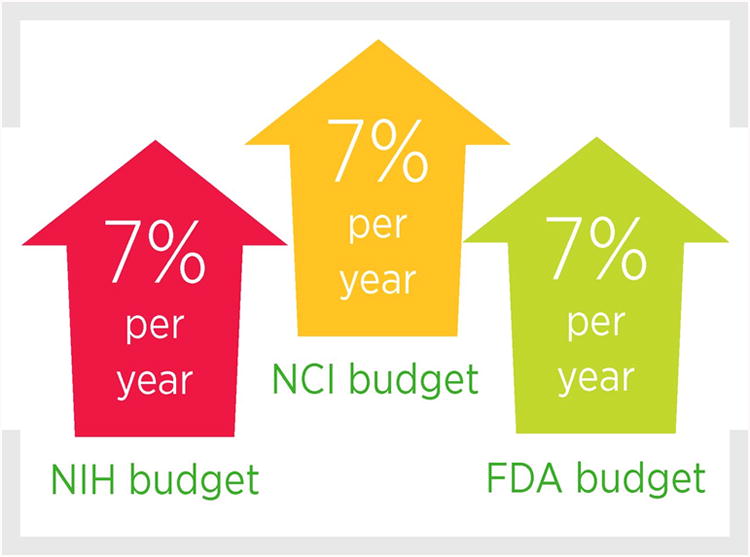
Therefore, the AACR respectfully urges Congress and the administration to
Implement a strategy for robust, sustained, and predictable growth in funding for the NIH and NCI by providing annual budget increases of at least 7 percent. This level of funding would represent strong growth in excess of the biomedical inflation rate, resulting in fiscal year (FY) 2020 funding levels for the NIH and NCI of $42.5 billion and $7 billion, respectively.
Increase the FDA budget in FY 2016 by$200 million above its FY 2015 level (a7 percent increase from $2.6 billion to$2.8 billion) and ensure that the agency receives comparable annual percentage increases thereafter. Achieving these goals will require Congress to work in a bipartisan fashion to enact a broad-based budget deal that raises the discretionary funding caps for FY 2016 and beyond. This would allow our nation's policymakers to invest in priority areas, such as biomedical research, cancer research, and regulatory science, which will speed innovation and accelerate the pace of development of products that are safe, effective, and ultimately advance public health.
By committing to provide the NIH, NCI, and FDA with annual funding increases that are robust, sustained, and predictable, we will transform cancer care, spur innovation and economic growth, maintain our position as the global leader in science, biomedical, and cancer research, and, most importantly, bring hope to patients and their loved ones.
Supplementary Material
Supplemental Table 1. FDA-Approved Therapeutics For The Treatment of Cancer
Supplemental Table 2. FDA-Approved Therapeutics For Cancer Risk Reduction or Treatment of Precancerous Conditions*
Supplemental Table 3. Surgical and Radiotherapy Treatments For Cancer
Figure 6.
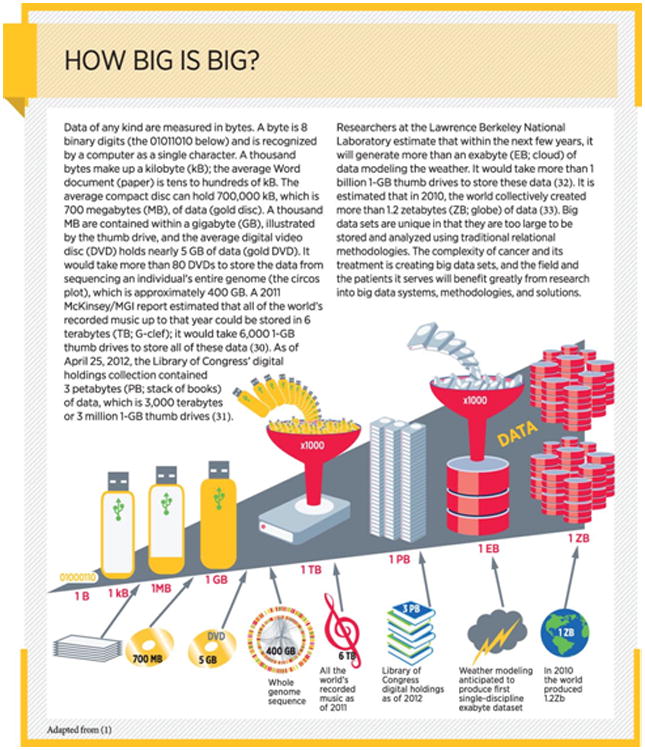
The AACR urges Congress and the administration to implement a strategy for providing annual budget increases of at least 7 percent for the NIH, NCI, and FDA beginning in FY 2016 and thereafter. This call to action is in line with the opinion of the majority of American voters, because three out of every four voters favor increasing federal funding for cancer research, according to results from the 2015 AACR survey. Thus, we urge all members of the AACR and, indeed, all Americans to join us in calling on Congress and the administration to prioritize the growth of the NIH, NCI, and FDA budgets through annual funding increases that are robust, sustainable, and predictable. There is no time to waste when, in the United States alone, we are losing one person every minute of every day to the devastating collection of diseases we call cancer.
José Baselga, MD, PhD, AACR President (2015–2016)
Margaret Foti, PhD, MD (hc), Chief Executive Officer

About the American Association for Cancer Research.
Founded in 1907, the American Association for Cancer Research (AACR) is the world's oldest and largest professional organization dedicated to advancing cancer research and its mission to prevent and cure cancer. AACR membership includes more than 35,000 laboratory, translational, and clinical researchers; population scientists; other health care professionals; and cancer advocates residing in 101 countries. The AACR marshals the full spectrum of expertise of the cancer community to accelerate progress in the prevention, biology, diagnosis, and treatment of cancer by annually convening more than 25 conferences and educational workshops, the largest of which is the AACR Annual Meeting with nearly 19,300 attendees. In addition, the AACR publishes eight prestigious, peer-reviewed scientific journals and a magazine for cancer survivors, patients, and their caregivers. The AACR funds meritorious research directly as well as in cooperation with numerous cancer organizations. As the Scientific Partner of Stand Up To Cancer, the AACR provides expert peer review, grants administration, and scientific oversight of team science and individual investigator grants in cancer research that have the potential for near-term patient benefit. The AACR actively communicates with legislators and other policymakers about the value of cancer research and related biomedical science in saving lives from cancer.
For more information about the AACR, visit www.AACR.org.
AACR President, 2015-2016, JosÉ Baselga, MD, PHD
“Since I started working in the field of oncology about three decades ago, there has been a sea change in our basic understanding of what cancer is …”

Mary Lasker
“If you think research is expensive, try disease!”
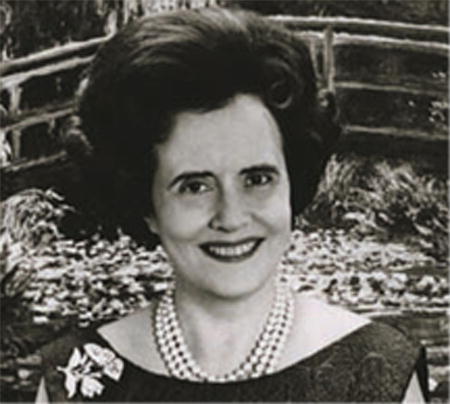
President Barack Obama, White House Briefing on Precision Medicine, Jan. 30, 2015
“What if matching a cancer cure to our genetic code was just as standard [as a blood transfusion]? … [T]he time is right to unleash a new wave of advances in this area, in precision medicine.”

AACR Call to Action.
Following more than a decade of budget stagnation and outright funding cuts, the administration and a bipartisan majority of members of Congress have demonstrated, thus far in 2015, a strong commitment to increasing the budgets for the NIH, NCI, and FDA.
During this time of unprecedented promise in biomedical and cancer research, robust, sustained, and predictable investments in the NIH and NCI, are urgently needed. This is a sentiment shared by the majority of American voters, as a 2015 national survey conducted on behalf of the AACR by Hart Research Associates and Public Opinion Strategies found that three out of every four voters favor increasing federal funding of cancer research.
Therefore, the AACR respectfully urges Congress and the administration to:
Implement a strategy for robust, sustained, and predictable growth in funding for the NIH and NCI by providing annual budget increases of at least 7 percent. This level of funding would represent strong growth in excess of the biomedical inflation rate, resulting in fiscal year (FY) 2020 funding levels for the NIH and NCI of $42.5 billion and $7 billion, respectively.
Increase the FDA budget in FY 2016 by $200 million above its FY 2015 level (a 7 percent increase from $2.6 billion to $2.8 billion) and ensure that the agency receives comparable annual percentage increases thereafter.
Achieving these goals will require Congress to work in a bipartisan fashion to enact a broad-based budget deal that raises the discretionary funding caps for FY 2016 and beyond. This would allow our nation's policymakers to invest in priority areas, such as biomedical research, cancer research, and regulatory science, which will speed innovation and accelerate the pace of development of products that are safe, effective, and ultimately advance public health.
By committing to provide the NIH, NCI, and FDA with annual funding increases that are robust, sustained, and predictable, we will transform cancer care, spur innovation and economic growth, maintain our position as the global leader in science and biomedical research, and, most importantly, bring hope to cancer patients and their loved ones.
“I know that I am here today because of two things—the grace of God and the hard work of biomedical researchers.”
Only 15 percent of patients with ovarian cancer are diagnosed at stage 1, when the five-year relative survival rate is 90 percent
29-Year Ovarian Cancer Survivor and Champion for Research
The Honorable Rosa L. Delauro (D-CT) // Age 72 // New Haven, Connecticut
In 1986, I was diagnosed with ovarian cancer. Coming face to face with my own mortality was life changing. But I was fortunate in at least two respects.
First, by chance, my doctor caught the cancer early, in stage 1. I underwent radiation treatment for two-and-a-half months. Throughout the process, I had excellent care.
Second, I worked for Senator Chris Dodd at the time. He told me to take as much time as I needed to recover, that my job was secure, and that his reelection campaign for U.S. Senate would not begin until I returned. (It helped that Senator Dodd was the original author of the Family and Medical Leave Act!) I have now been free of cancer for almost 30 years.
Cancer is a tenacious foe. But, as Ralph Waldo Emerson said, “We acquire the strength we have overcome.” Every survivor knows that fighting this disease brings out your own innate human resilience. You begin to savor every moment of your life. And you yearn to use that time to make a difference.
In my case, defeating cancer was one of the things that propelled me to seek election to the House of Representatives. I came to Congress in 1991 with the goal of making sure that everyone diagnosed with cancer enjoys the advantages I did.
Above all, that means finding enough money for lifesaving research. I know that I am here today because of two things—the grace of God and the hard work of biomedical researchers. That is why I have made adequately funding the National Institutes of Health [NIH] one of my top priorities.
Between 1998 and 2003, we doubled the NIH budget. It will always rank as one of my proudest achievements. But unfortunately, NIH funding has fallen behind in recent years. Since 2010, it has seen its annual budget erode by about $3.6 billion in real terms—an 11 percent cut. It is time to raise it again. I have a bill before Congress right now to allow that to happen.
My story also shows the importance of early detection. When we make screenings widely available, death rates plummet. With cancer, the earlier the treatment, the better your chances. We need to give everyone a shot at treatment as early as possible. Earlier this year, I was able to secure language in the budget to stop a new rule that could have limited access to screening for breast cancer.
Finally, we need to allow all cancer sufferers to take time off to recover, just as I did. Thanks to Senator Dodd, most Americans now enjoy family and medical leave. But many cannot afford to take time off unpaid. We should build on Senator Dodd's legacy by requiring all employers to offer paid family and medical leave. Again, I have a bill that would put this in place.
Each one of us knows someone whose life has been touched by cancer. For example, this year alone, more than 20,000 women will be diagnosed with ovarian cancer. They deserve the best possible fighting chance against this disease, based on the best information and the latest science. We have it in our power to give them the same advantages I had. Battling cancer with medical science, screenings, and basic compassion should be a priority for every government, and every human being.

“I am a huge proponent of the NIH and believe investment in the agency must continue to be a strong national priority.”
Kidney cancer is the seventh most commonly diagnosed cancer among U.S. men
Surviving Kidney Cancer Thanks to Pioneering Surgery
The Honorable Tom Marino (R-PA) // Age 62 // Cogan Station, Pennsylvania
In 1999, when I was the District Attorney of Lycoming County, Pennsylvania, I was in Pittsburgh attending a conference and I woke up at 2 or 3 a.m. with tremendous pain in my back. It was so excruciating that I couldn't make it out of my hotel room without help from a colleague who drove me to the emergency room.
At the hospital, I learned that I was passing kidney stones—that's what was causing the pain—but the tests also revealed a cyst on my left kidney, which I was told I needed to have checked right away.
I went home and the next day saw my personal physician, who sent me to a nephrologist—a kidney specialist. That's when I learned there was a good chance I had cancer and that I would likely need my kidney removed. But I wanted to see if there were other options and was referred to a physician at the Cleveland Clinic who had just pioneered the partial nephrectomy to remove the cancerous part the kidney instead of the entire organ, for a second opinion.
After three days of tests, I was told I was a candidate for the partial nephrectomy and ultimately I was treated with that procedure in Cleveland.
As soon as you hear the word cancer, a million things run through your mind. I immediately thought about one of my close friends who died of kidney cancer. I started thinking the worst: who would take care of my kids and my wife? My wife and I had just adopted our second child; he was only 30 days old, and my daughter was not quite 4.
I also got angry. I exercised regularly, I don't drink or smoke, so I went through a phase of thinking, “Why me?” But my wife repeatedly urged me to stay strong and focus on what I needed to do to make it through this.
That's what I did. And it was fine until 10 years later, almost to the day. In 2009, during the regular scans and tests I got every three months, my doctors found a tumor in the remaining part of my left kidney, the kidney that had been partially resected to remove the original cancer. So I had surgery again.
And after being elected to Congress and taking office in 2011, they found tumors in my right kidney. So, I went back to Cleveland and they did another partial nephrectomy. Despite the three occurrences of cancer, I feel truly fortunate. Had it not been for the kidney stones, I may not have found out until it was too late and might not be here today.
My cancer experience changed my life in a number of ways. As a prosecutor, my career was important to me, but after my diagnosis, I wanted to spend more time with my kids and my wife.
I often say to myself, let me get through this long enough to see my son through graduate school. Eventually, I may be a candidate for a kidney transplant or I will be on dialysis, but despite it all, I continue to stay strong because of my family.
My daughter has cystic fibrosis, a disease for which there currently is no cure, and she really is my rock. For that reason, I've always been a big supporter of increased funding for research on diseases such as cancer, Alzheimer's disease, and cystic fibrosis—heartbreaking diseases that I have seen the effects of firsthand in my family.
Members of Congress are also affected by these devastating diseases, and I constantly have the opportunity to talk to colleagues about getting involved in these caucuses and the importance of a good, sound budget for the National Institutes of Health (NIH). And there is not a day that goes by that one of my colleagues, even those across the aisle, aren't asking how I feel.
Putting the emotion aside for a moment, we're going to find a cure for cancer and I expect we will do so in the near future. From an economic standpoint, it makes sense to provide the adequate funding for the NIH to find cures for these diseases. Our focus should be nothing less than improving the quality of life for all Americans. We have to think outside of the box, we have to take everyone into consideration. For those reasons, I am a huge proponent of the NIH and believe investment in the agency must continue to be a strong national priority.
We can find cures because nowhere in the world do we have the talent like we do in the United States: the scientists, doctors, nurses, all of whom are all devoted to this important cause. They are the geniuses who will eventually find cures for this disease.

Keeping Ovarian Cancer at Bay Thanks to A Clinical Trial
Patty Klein // Age 53 // Coral Gables, Florida
In 2013, when my ovarian cancer recurred for the third time, I had the option of receiving more chemotherapy or trying to find a clinical trial. My husband and I did a lot of research and I was fortunate to get into a clinical trial at the Dana-Farber Cancer Institute in Boston under the direction of Dr. Suzanne Berlin. The drugs I've been receiving through the trial, olaparib [Lynparza] and BKM120, have kept the cancer at bay for 16 months. I recently passed five years since my original diagnosis, which I am very thankful about because 60 percent of women who receive a stage 3C ovarian cancer diagnosis die before reaching this milestone.
In many ways, my journey with cancer began when my mother was diagnosed with breast cancer at age 40. As a result, I was always extremely concerned about breast cancer and had annual mammograms. I even had a biopsy along the way, but everything always came back negative.
Then, just over five years ago, I gained 10 pounds or so. I thought it was just natural, middle-age weight gain. But one day, while I was traveling on business, I suddenly felt pain in my side that was so bad I immediately went to a local doctor. He mentioned that it could possibly be hepatitis C virus, shingles, or gallbladder issues and did an ultrasound. I sent a copy of the ultrasound to my brother-in-law, who is a cardiologist in Detroit, and he told me to come to Detroit right away. On Saturday I had a CT scan, and on Monday I was diagnosed with ovarian cancer; the pain in my side was caused by ascites [a buildup of fluid in the abdomen] pressing against my liver.
After my diagnosis I learned that I have a BRCA1 mutation. I also learned that being of Jewish Russian heritage increases a person's chances of carrying a BRCA mutation and that these mutations act as a link between breast and ovarian cancers. I wish I had known all this earlier because I would have been proactive about monitoring other aspects of my health in addition to my breast health and maybe I would have been diagnosed at an earlier stage, when ovarian cancer is more likely to be treated successfully. On the other hand, learning this opened doors to clinical trials available only to patients with BRCA mutations.
About a week after my diagnosis, I had extensive surgery—a complete hysterectomy [surgical removal of the whole uterus and cervix], omenectomy [surgical removal of the tissue that surrounds the stomach and other organs in the abdomen], a bilateral salpingo-oophorectomy [surgical removal of both ovaries and fallopian tubes], and tumor debulking [surgical removal of all tumors larger than 1 cm]. This was followed by 18 rounds of chemotherapy, including several rounds of chemotherapy delivered directly into my abdomen. There were weeks when I would travel to Ann Arbor for chemotherapy on Monday then fly to Las Vegas or Orlando to work a full schedule the rest of the week.
By January 2011, I was told there was no evidence of cancer in my body. Unfortunately, about six months later, my blood CA-125 levels, which are used to monitor for potential relapse, were rising and a PET scan showed that the cancer had reccurred. After another six rounds of chemotherapy with taxol and carboplatin, I was again told there was no evidence of disease, but again the cancer returned about six months later. Another six rounds of chemotherapy with taxol proved very challenging, but I worked through it all.
When my cancer recurred yet again, in December 2013, I was offered more chemotherapy. However, my doctor had previously mentioned that there were clinical trials testing drugs called PARP inhibitors, which were showing promise for BRCA-mutant cancers like mine. When I asked him about these he said they were all full, but I decided to do my own research because it sounded like a much better option for me than more chemotherapy.
I learned very quickly that you need to meet a lot of eligibility requirements before you even qualify for a trial and that understanding all of these is not easy. Then you have to get into the trial. The two trials that I found that I qualified for had long waiting lists and only enrolled a small number of patients each month. Somehow I was fortunate enough to get a slot in the trial at Dana-Farber and I have received the most outstanding cancer treatment and care from the staff there.
For the first eight weeks I had to go to Dana-Farber each week, but now I only go every four weeks. During my visits, they alternate between testing my blood and performing a CT scan. I can stay in the trial as long as my tumor does not grow more than 10 percent above baseline. The fact that I can take pills every day, which have very limited side effects, is phenomenal because it allows me to be completely focused on work, like I've always been.
Unfortunately, there is no cure for ovarian cancer and our only hope of finding a cure is by supporting research and the great scientists out there who are working toward this goal.
The clinical trial in which Patty is participating was partially funded by the Stand Up To Cancer Targeting PI3K in Women's Cancers Dream Team.
“The fact that I can take pills every day, which have very limited side effects, is phenomenal because it allows me to be completely focused on work, like I've always been.”
Ovarian cancer is the fourth most common cause of cancer-related death among U.S. women

Living A Good Life With Stage 4 Breast Cancer Thanks to Palbociclib
Janet Klein // Age 59 // Sherman Oaks, California
I was diagnosed with stage 4 recurrent breast cancer in April 2009. After surgery, I was offered the chance to participate in a phase I clinical trial testing a new drug for exactly the type of breast cancer I had—stage 4 estrogen receptor–positive breast cancer. I jumped at the chance and have been taking palbociclib (Ibrance) and letrozole ever since. Within nine months of starting the trial, there was no evidence of cancer in my body. My quality of life is extraordinary and I continue to do everything that I want to.
It all started in October 2005, with a phone call from my gynecologist a day or two after my annual mammogram. I was always vigilant and made sure to have annual mammograms because my mother survived breast cancer twice, the first time 40 years ago. My sister also survived breast cancer. I had always assumed that it would eventually be my turn and hoped that the mammograms would detect it early. I was fortunate; the diagnosis turned out to be stage 1 estrogen receptor–positive breast cancer.
Right after my diagnosis, I met with a number of surgeons to learn about the options for my surgery. I chose a surgeon at UCLA because she was able to do reconstruction surgery at the same time as a bilateral mastectomy [surgery to remove all of both breasts]. I was back at work just four weeks after surgery, traveling and living my life.
I then met with an oncologist and started a five-year course of tamoxifen therapy. I also chose to continue having yearly mammograms, even though this was not standard of care at the time, which is lucky because this is how my recurrence was caught.
About four years after my initial diagnosis, I received a phone call a day or two after a mammogram to tell me there was something suspicious. I was told to come back for another mammogram immediately, which I did. At that point, it was decided there was no immediate concern and I was offered a follow-up mammogram in six months. But I wasn't satisfied with that and took the mammogram films to my surgeon who said there was no need to wait and that I should have a needle biopsy straight away.
So that is what I did, and sure enough, I had a recurrence of the breast cancer in the small amount of breast tissue left after the mastectomy. A PET scan and bone biopsy revealed that the cancer had metastasized to my left iliac bone. I had a lumpectomy and bilateral oophorectomy [surgery to remove both ovaries] before meeting with my oncologist to plan the next steps in treatment.
The first thing my oncologist told me about was a phase I clinical trial testing a new drug, palbociclib, together with letrozole. Once a radiation oncologist had agreed that it was OK to just watch the bone tumor, I was cleared to participate in the clinical trial. There has been no sign of cancer in my body since January 2010, about nine months after I started on the clinical trial.
I will take letrozole every day and palbociclib on a four-week cycle for the rest of my life, as long as it keeps my cancer at bay. Right now, the quality of my life is extraordinary—if you saw me walking down the street you would never imagine I was a stage 4 cancer patient.
One of the reasons I choose to talk about my experience with cancer, rather than keep it private, is because I think it is critically important for women to know that you can go through stage 4 breast cancer and come out the other end. For more than five years there has been no evidence of my cancer, and all I do is take a pill and live my life.
“Within nine months of starting the trial, there was no evidence of cancer in my body.”
It is estimated that 231,840 U.S. women will be diagnosed with breast cancer in 2015

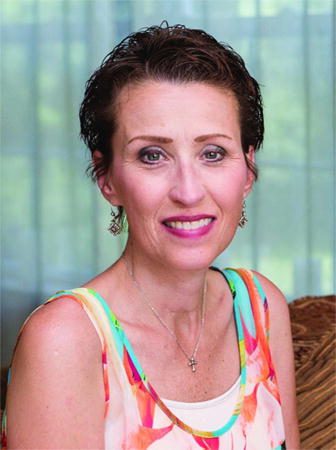
“… since I started lenvatinib … the cancer is no longer visible and I'm living a normal life, eating what I want, and looking toward the future.”
Rates for new thyroid cancer cases have been rising in the United States for the past 10 years
Surviving Hurthle Cell Cancer Thanks to Clinical Trials
Lori Cuffari // Age 51 // Millstone Township, New Jersey
I was diagnosed with Hurthle cell cancer, a rare type of thyroid cancer, in 2008. After surgery, my doctors told me it was likely that the cancer had spread, and sure enough, just a few months later, tests showed that it was in my lungs. Since then, I've participated in a number of clinical trials, most recently a trial testing a drug called lenvatinib. I'm still taking lenvatinib and I feel great, I'm finally regaining the weight I lost during earlier treatments, and I'm doing everything I can to pay it forward—participating in clinical trials and advocating to increase awareness about cancer and the importance of cancer research.
My experience with cancer began very suddenly. One spring day, in 2008, I was sitting at my desk on the phone, ordering lunch for an upcoming presentation, when I ran my hand down my neck and felt something. When I looked in the mirror I couldn't see anything until I tilted my head back and all of a sudden I could see a huge lump on the right side of my neck. I immediately called my primary care physician and told them I was coming in right away.
The physician told me it was probably just a goiter but sent me for a fine needle aspiration biopsy anyway. The results of the biopsy suggested Hurthle cell cancer. I was shocked; hearing the word “cancer” makes you stop in your tracks, but I was determined to get through it. In addition to seeking treatment, I decided to eat even more healthily and start exercising more; yoga in particular has really made a difference for me.
As soon as I was diagnosed, my husband and I started searching for a surgeon. We met with a number of people before finding someone I really connected with. I had the right side of my thyroid removed, where the tumor was, but after they analyzed the tumor and confirmed that it was Hurthle cell cancer, I had a second surgery nine days later to remove the left side of my thyroid.
Because the analysis of my tumor had shown extensive vascular invasion [a large number of blood vessels in the tumor] I was told that it was very likely to have traveled to other parts of my body. So my surgeon referred to me to an endocrinologist at Memorial Sloan Kettering Cancer Center in New York.
Initially, there was no obvious cancer in my liver, lungs, or bones [the sites that thyroid cancer most commonly metastasizes to] so we just watched and waited, which was very scary to me. But by December 2008, it was clear that there were tumors in my lungs. My only option was to consider clinical trials.
Over the next year, I participated in two phase I clinical trials at Memorial Sloan Kettering Cancer Center. I felt great and was able to go about my normal life, but the physicians told me that the cancer was going to keep creeping up on me and that clinical trials would continue to be my path.
My husband found a clinical trial at the University of Pennsylvania that sounded promising, and minutes after I reached out to them by email, Dr. Brose called and told me they had solutions for me. I first participated in a trial testing sorafenib (Nexavar) and then a trial of sorafenib and everolimus (Afinitor), which benefited me for four years, although my diet while receiving sorafenib was very restricted and I hovered between 90 and 100 pounds all four years.
Then, in June 2014, I stopped taking the drugs because of low potassium levels. Within a couple of weeks, a tumor appeared in my ocular muscle. After consulting radiation and surgery specialists, I had 25 rounds of proton therapy. This was followed by an excruciating four-month wait to get a spot on the lenvatinib clinical trial, which Dr. Brose felt would be best for me. The cancer was becoming visible on my body and I began to wonder if this could be it. But since I started lenvatinib, in November 2014, the cancer is no longer visible and I'm living a normal life, eating what I want, and looking toward the future.
Down the road I may need other treatment options, but the cancer research world is doing amazing things and I know that new treatments will become available. Clinical trials are essential if these treatments are to become a reality. I feel an obligation as a cancer patient to participate in clinical trials; in doing so I am helping make a difference to the future of cancer care.
Surviving Lung Cancer Thanks to Immunotherapy
Donna Fernandez // Age 61 // Rowlett, Texas
I was diagnosed with stage 4 nonsquamous non-small cell lung cancer in 2012. Chemotherapy made me really sick and nobody expected me to be alive today, much less still doing well. But I'm receiving an immunotherapy called nivolumab (Opdivo) through a clinical trial and it has given me my life back. I feel great and I'm rarely at home because I have a very full calendar that keeps me out and about doing things that I think are fun.
My journey with cancer began when I went to a primary care physician for the first time in 10 years at the end of October in 2012. I had always been skinny, so after putting on a lot of weight I thought I had a thyroid problem and decided to make an appointment.
During the exam, the doctor felt a knot on my collarbone and ordered a CT scan. The scan results showed that I didn't have a thyroid problem but there were some “funny cells” that needed checking out with a PET scan.
I didn't think to ask what a PET scan was but I read on the internet later that it is often used to detect cancer. Even though I had had an inkling I might have cancer, I still cried a few tears when the doctor called to tell me that the PET scan showed I had stage 4 lung cancer. I had been hoping that it was going be anything but lung cancer because my experience with the disease had not been good. My dad had died of lung cancer at age 49.
Even though the primary care physician was not a doctor I knew before this journey began, she took me and my husband under her wing and really guided us through the whole process. I call her my angel doctor. When she called to tell me that I had lung cancer, she had already set up an appointment for me the next day with an oncologist and we went back to visit her after each oncologist appointment. When we told her that the oncologist had arranged for a biopsy appointment several weeks after we saw him, she got on the phone and had the appointment moved to that very day.
The biopsy showed that I had nonsquamous non-small cell lung cancer, and I immediately started on a cocktail of chemotherapy—carboplatin, pemetrexed (Alimta), and bevacizumab (Avastin). The tumors did respond to the chemotherapy, but the treatment also made me really sick. During my chemotherapy it was difficult for me to walk from my living room to my kitchen. Eventually my body couldn't handle it anymore and the oncologist switched me to a maintenance therapy.
But that still made me sick, so after about eight weeks I stopped all treatments and the tumors began to grow immediately. At that point, my oncologist told me I had two options. One was chemotherapy that he said usually didn't work as well as the chemotherapy I had already received and had worse side effects. The other was a clinical trial. I thought for about one minute and I chose the clinical trial.
I began the clinical trial in July 2013, at The University of Texas Southwestern Medical Center, and I'm still on it. I've had a really excellent response to nivolumab. My tumors haven't gone away, but they haven't changed since I started nivolumab, they just sit there. Sometimes the radiologist who reads the CT scans I have every six weeks calls them scars, although my oncologist doesn't agree with that.
Nivolumab has been a miracle drug for me, especially compared with chemotherapy. The only side effect I have, ironically, is that my thyroid stopped working so I have to take a pill for that every day. I live my life like I did before my diagnosis, I run drills with my dogs several days a week, and I barely realize that I'm being treated for lung cancer anymore.
I've heard that adult participation in clinical trials is extremely low, but I tell anybody who will listen that being in a clinical trial has saved my life.
“Nivolumab has been a miracle drug for me, especially compared with [traditional] chemotherapy.”
Lung cancer is the leading cause of cancer-related death in the United States

Enjoying A Normal Childhood Thanks to Dinutuximab
Elizabeth BUELL-Fleming // Age 11 // Wilmington, Delaware
A message from Martha Buell and Boyd Fleming, Elizabeth's parents:
Our daughter Elizabeth was diagnosed with high-risk neuroblastoma when she was just 2 years old. After an aggressive chemotherapy regime and an autologous bone marrow transplant, the cancer was found in her bone marrow. This made her ineligible for the clinical trial we had just enrolled her in, which was testing a groundbreaking immunotherapy called ch14.18. But her oncologists at Children's Hospital of Philadelphia [CHOP] went to bat for her and she received the treatment through compassionate release. It is now six-and-a-half years since she finished treatment and there is no doubt in our minds that she is alive today, living the life of a normal 11-year old, because of ch14.18 [now dinutuximab (Unituxin)] and the research that led to it.
Elizabeth's diagnosis came the day after Christmas in 2006. We had taken her to the pediatrician on Christmas Eve because she had a cold and we wanted her checked before the holidays. The pediatrician felt something unusual in her abdomen and recommended that we take Elizabeth for an ultrasound at Alfred I. duPont Hospital for Children. On the pediatrician's advice we went that very day. We could see on the ultrasound something the size of a grapefruit. But even though we asked, “What is that?” the technician couldn't tell us. We had to wait to find out until the doctor called.
When he called, the day after Christmas, he said, “Elizabeth has a mass on her kidney and you have to come to the emergency room now.” We had no idea what was going on. It still didn't sink in when, after a number of tests, we were sent up to the Hematology and Oncology floor. It wasn't until we were there that we heard the word “cancer.” It was crazy, everything had seemed normal up until that phone call and here we were, new members of a club that no one wants to be in.
A scan revealed that Elizabeth had neuroblastoma. During surgery, right after New Year's Day, the surgeons removed the whole tumor. But because one of the four lymph nodes that they removed showed signs of cancer, the diagnosis was stage 2b. Further analysis of the tumor showed amplification of the MYC oncogene, which meant that Elizabeth had high-risk disease.
We took her to CHOP to get a second opinion on the best course of treatment. The oncologists there recommended following their new treatment protocol for high-risk neuroblastoma. Elizabeth had six rounds of induction chemotherapy, a stem cell transplant, a course of high-dose cis-retinoic acid, and radiation therapy directed toward the site of the tumor.
At that point, we began considering clinical trials because we knew that being in a clinical trial was a good idea; you get better monitoring and the outcomes are often better. We chose to sign Elizabeth up for a trial that was just starting at Alfred I. duPont Hospital for Children, testing whether treating with a monoclonal antibody treatment called ch14.18 at the end of the standard high-risk neuroblastoma treatment protocol would improve outcomes.
To be eligible for the trial, Elizabeth had to have no evidence of cancer in her body. To check this, she had a series of tests, including an MIBG scan and bone marrow biopsy. We were devastated when the results showed that there was cancer in Elizabeth's bone marrow. Not only had the cancer appeared in a place where it had not been before, which meant her chance of survival had gone down dramatically, but now she would no longer be part of the clinical trial. We feared the worst.
But Elizabeth's doctors at CHOP advocated for her to receive the monoclonal antibody through compassionate use, and we are so thankful to them for that. Elizabeth was the first patient who was not part of the clinical trial to receive ch14.18, and we absolutely believe that without it she would not be alive today. Although the ch14.18 treatments were painful, Elizabeth was lucky—she did not experience the excruciating pain that some other children do, and she was able to complete the full course.
There has been no evidence of the disease since Elizabeth finished treatment in January 2010. She is now monitored just once a year for any late effects of the treatments she received. At this point, Elizabeth has experienced no long-term problems and we are so grateful that cancer research made ch14.18 available just when Elizabeth needed it. We were on the edge of a cliff and there will never be enough words to express the feeling that we felt when we were pulled back from the edge.
“… we are so grateful that cancer research made ch14.18 [dinutuximab (Unituxin)] available just when Elizabeth needed it.”
Neuroblastoma is the third most common cancer diagnosed in U.S. children ages 0–15

Beating Acute Lymphoblastic Leukemia Thanks to Research
Sergio Ramirez // Age 33 // Los Angeles, California
When I was diagnosed with acute lymphoblastic leukemia (ALL) in 2009, I was terrified. I had just turned 27, I had three beautiful boys, a beautiful wife, a job that I loved, and to us, the word “cancer” was a death sentence because we knew nothing about the disease. Participating in a clinical trial testing the drug blinatumomab saved my life. In 30 days blinatumomab did what years of chemotherapy couldn't: it put me in remission, allowing me to have a stem cell transplant. I am now recuperating and hope to go back to work in the future.
My journey with cancer began just after we returned from a family vacation in Central America. All my family and friends were telling me I was very pale, but I felt fine so I didn't listen to them or worry. Then, on my 27th birthday, we went to the park to play football with the kids. As soon as I started going for the ball my head started spinning, I got really dizzy. Realizing that something was wrong, I went to my physician the next day.
I told my physician all my symptoms and how everyone had been telling me I didn't have any color and he said to me, “Sure, you look as white as a sheet of paper.” He immediately ordered some blood tests, and they showed that my hemoglobin levels were half what they should have been. After some more tests I received the diagnosis of ALL.
My treatment started immediately. It was a three-year treatment plan. The first year was very intensive chemotherapy and I practically lived in the hospital. I found this really hard; I couldn't work, couldn't go outside and play with my kids. It made me feel like a bird that had been caught and trapped in a cage, but my faith and my family helped me through.
Then came two years of less-intensive chemotherapy.
At the end of the three years I was really happy when I learned that the leukemia was in remission. But it didn't last long. After 6 months the leukemia came back and it was more aggressive than ever. I immediately started even stronger chemotherapy than before, but after about a month, a bone marrow biopsy showed that the leukemia was still there. In fact, 82 percent of the cells in the biopsy were leukemia cells, which meant that the chemotherapy wasn't doing anything to the leukemia anymore.
At that point, my doctor told me I had about a 15 percent chance of survival and that my only option was a clinical trial testing blinatumomab. To be in the trial, I had to be treated at City of Hope, and when I first went there I was terrified. Up to then, I had been treated at a small hospital. City of Hope was huge, it was like a small city, but everyone there did an amazing job.
I was also terrified when I learned that I was just the 104th person to receive blinatumomab. I had imagined that there would be thousands of other people in the clinical trial, and to learn that I was just the 104th was scary. But being in the trial saved my life.
The trial lasted only 30 days. I was admitted to the hospital for the first two weeks and then able to go home and spend time with my family, which was huge for me. The only thing was that I had a little pouch that let the medicine run 24 hours a day and I had to go back every two days to have the pouch changed.
After the 30 days, I had a bone marrow biopsy. It took a week to get the results and I was really anxious, I couldn't sleep, I felt that it was my last chance to survive. But as soon as I saw the doctor I knew the results were good because he had a big smile on his face. Learning that there was no sign of leukemia was one of the happiest days of my life. It gave me new hope.
I did another 30 days of blinatumomab and then the focus turned to a stem cell transplant. I was lucky that they found three potential donors so that there was no wait involved. I was in the hospital for 42 days for the transplant and it was tough, but my family was there for me 24 hours a day.
I am now happier than ever before. I appreciate waking up in the morning, hugging my kids, and playing sports with my kids. The whole experience was very tough on them, especially the eldest, but research saved my life and my kids know that Daddy's back.
“In 30 days blinatumomab did what years of [traditional] chemotherapy couldn't …”
Only about 40 percent of U.S. acute lymphoblastic leukemia diagnoses are in adults

Jay Steiner, 40-Year Childhood Cancer Survivor and Past Caregiver for His Soul Mate
“As a caregiver, it's important to take care of yourself. It might sound selfish, but taking care of yourself will enable you to be a better person and, in turn, be there for your loved one.”


“I like to think there was no turning back when I was declared cancer-free at age 11, but that's not really true—my experience made me the person that I am today.”
The five-year survival rate for childhood acute lymphoblastic leukemia is now 90 percent
40-Year Childhood Cancer Survivor and Past Caregiver For His Soul Mate
Jay Steiner // Age 45 // Fort Collins, Colorado
I am a long-term survivor of childhood acute lymphoblastic leukemia (ALL). I like to think there was no turning back when I was declared cancer-free at age 11, but that's not really true—my experience made me the person that I am today. I learned not to sweat the small stuff, and striking a balance in life is really important to me. My number-one priority is to be a good father for my children, but I'm also very driven professionally and I love to play, travel, and go on adventures.
I was 5 years old, living a normal childhood, having lots of fun, when I was diagnosed with ALL. I don't remember much about my diagnosis because I was so young, but I do recall my parents taking me to the doctor after I had an accident, just your typical childhood fall in which I hurt my leg, and my parents telling the doctor I also didn't seem to possess the same amount of energy that I had had in the past. They ran some tests and ultimately I was diagnosed with ALL.
I really didn't understand what was happening to me, but I did know that it was a serious situation because of the ways my parents were reacting. It was doom and gloom—at that time, in the mid-1970s, survival rates for childhood ALL were much lower than they are today. I also remember my parents telling me that if they could trade places with me they would, in a heartbeat. I never doubted that commitment. So, even though my cancer diagnosis was an unfortunate thing, it made our already close family even closer.
At the time, we lived in Wichita, Kansas, but I was referred to The University of Texas MD Anderson Cancer Center in Houston, and so my parents decided to relocate the family to Houston on a permanent basis. From the ages of 5 to 8, I had lots of chemotherapy and radiation treatments. Initially I was treated in the hospital. Then, after about a month, I was treated as an outpatient. At first I was going in a couple times a week, and then it became once a week, and then there was more and more time in between sessions. I remember dreading the appointments, but we would celebrate afterward.
After my treatment ended, at age 8, a bone marrow biopsy showed no cancer, but it wasn't until I was 11 that I was officially declared cancer free. At that point, I made up for time I'd lost to my treatments. I recall playing tag, baseball, or basketball outside with my friends until it was too dark to see, and even to this day, I feel that I'm a big kid who loves to play as an adult.
I've had no long-term health consequences as a result of my journey with cancer, but my experience really made me appreciate life. It's so easy to get caught up with life's frustrations and daily responsibilities, but I try to take the time to stop and smell the roses. My experience also made me want to give back, and I feel an important responsibility as a survivor is being there for others facing their own battle.
It is so challenging to watch someone you love go through a journey with cancer. Sometimes you don't feel there is anything you can do to make a difference, but there always is. Sometimes it's as simple as holding their hand as you sit in silence, just being there for them. But as a caregiver, it's important to take care of yourself. It might sound selfish, but taking care of yourself will enable you to be a better person and, in turn, be there for your loved one.
I say this not as a cancer survivor, but as a husband of a wife diagnosed with breast cancer at age 37. My wife Monica's journey was a difficult one for our whole family; our kids were just 3 and 5 when she was diagnosed. I was proud to be right there at her side throughout her journey. We never gave up hope, but as her time was approaching, it was very difficult. I had to tell our kids that today was the day they were going to lose their mom. It had a huge impact on my life, but I'm thankful for everything, for every moment, that we had.
I am also extremely thankful for all the clinical trials that were available to Monica during her journey; without them I feel cancer would have taken her much sooner. That's why funding cancer research and clinical trials is so important. I don't want anyone else's children to have to grow up without a mom or a dad and other adults to have to face the rest of their life without their soul mate at their side.

“… these are exciting times and … the pace of discovery and application of new knowledge to patient care is rapidly accelerating.”
Envisioning Future Progress Against Cancer On Multiple Fronts
José Baselga, MD, PhD // AACR President, 2015–2016, Physician-In-Chief, Memorial Sloan Kettering Cancer Center // New York, New York
Since I started working in the field of oncology about three decades ago, there has been a sea change in our basic understanding of what cancer is—from the systematic discovery of oncogenes, to the increased understanding of metastases, cancer immunology, and metabolism, to name a few—and in the way that we treat patients with cancer. This has led to significant decreases in cancer mortality rates on an annual basis.
The majority of cancer researchers agree that these are exciting times and that the pace of discovery and application of new knowledge to patient care is rapidly accelerating. Remarkable advances are occurring in multiple fields. The advent of next-generation tumor DNA sequencing is enabling the identification of driver genomic alterations that can be targeted with precision therapeutics that are highly active and display limited toxicity.
Going forward, we will need to devise combination therapeutics or therapeutic cocktails that will delay or prevent the appearance of resistance to therapy. On top of this, newer tumor detection technologies, such as the identification of circulating tumor DNA in the blood, will provide us with new tools to monitor response to therapy, the emergence of resistance, and early disease recurrence.
We now recognize that, in addition to genetic mutations, aberrant epigenetic regulation of gene expression is frequent in tumors and can also be therapeutically targeted. In fact, epigenome-targeted therapeutics are showing great promise in some hematologic malignancies, and we are eagerly awaiting their effective application in solid tumors. The same applies to the understanding and targeting of the unique metabolism of cancer cells.
Perhaps most striking are the tremendous advances that are occurring in the field of immunology. Immune checkpoint-blockade strategies that permit the patient's own immune system to attack his or her tumor have led to in almost miraculous results in multiple tumor types, including melanoma and lung cancer, to name just two of the most difficult tumors to treat. In the future we envision that these treatments will be administered in combination, agonist immune therapies will also be incorporated, and engineered T cells (CAR-T cells) will attack tumor cells with unprecedented efficacy. In fact, the results with CAR-T cells in some forms of leukemia and lymphoma are astonishing. And as a result of precision medicine, predictive mutational signatures of response will be identified so that these therapies are offered only to those patients who are likely to benefit from them.
Much progress is also occurring in all fields of medicine, including surgery, with less invasive techniques, radiation therapy, and conventional chemotherapy. We may even come to see conventional chemotherapy as targeted therapy if we use it in the right setting and in the right tumor type. We will improve the way we work together so that we can integrate the knowledge from all the different areas of cancer science.
The practice of cancer medicine, as we know it today, will substantially change. The days that the physician is in the room with the patient making complex decisions with the support of a (simple) electronic medical record will be gone. Millions of data points for each patient and his or her tumor will be extracted and analyzed at the time of decision making. Many of these data points will be generated through increased use of genomics, but others will come from information about the presentation of the tumor, exposures, and outcomes of prior treatments, and yet even more from the patient's own preferences. The power of computer and information science will integrate all the pertinent information, mine vast databases that will contain information on outcomes from similar patients, and will finally provide decision support tools that will result in tailored treatment choices.
Decision support tools will be particularly important because 80 percent of cancer care today is provided in the community setting. We will need to ensure that the knowledge generated in specialized cancer centers gets disseminated quickly to the community via data sharing and outcomes research.
Although many efforts are needed to care for those diagnosed with cancer, it would be tremendously shortsighted if we did not increase our efforts in the field of cancer prevention and early cancer interception. This last concept is important, as the detection of tumors at a very early stage using noninvasive techniques to find circulating tumor DNA in blood or other samples could redefine early detection and therapy.
Unfortunately, at this time of great excitement and progress on so many fronts, we are facing several threats that cloud the promise of cures for patients with some types of cancer. The largest by far is the decline in NIH funding. Since 2004, NIH funding in real dollars has decreased by 25 percent, and some of the many brilliant ideas and projects simply cannot obtain federal funding. Another unintended consequence of this lack of funding is that careers in science are becoming less attractive to our most talented college graduates. Therefore, there is an urgent need to increase research funding so that our scientific community will be able to continue to make the breakthroughs that will deliver more cures to cancer patients.
President Barack Obama, White House Briefing on Precision Medicine, Jan. 30, 2015
“What if matching a cancer cure to our genetic code was just as standard [as a blood transfusion]? … [T]he time is right to unleash a new wave of advances in this area, in precision medicine.”

Elizabeth H. Blackburn, PhD, Recipient of the 2009 Nobel Prize in Physiology or Medicine
“I came to the United States in the mid-1970s after I had done my PhD training in the United Kingdom, and I simply came because I knew that it was here in the United States that the world's most exciting science was being done.”

Glossary
- Acute lymphoblastic leukemia (ALL)
An aggressive (fast-growing) type of leukemia (blood cancer) in which too many lymphoblasts (immature white blood cells) are found in the blood and bone marrow. Also called acute lymphocytic leukemia.
- Anaplastic large cell lymphoma (ALCL)
A rare type of non-Hodgkin lymphoma that usually arises from T cells (see T cell). The cells accumulate in the lymph nodes, skin, bones, soft tissues, lungs, or liver. In some cases, the anaplastic large cell lymphoma cells have the protein ALK (see Anaplastic lymphoma receptor tyrosine kinase) on their surface.
- Anaplastic lymphoma receptor tyrosine kinase (ALK)
The ALK gene makes the ALK protein, which is found on the surface of some cells. The protein can initiate a variety of signaling pathways (see Signaling pathway/signaling network), causing proliferation of the cells on which it is found. The ALK gene is altered in several types of cancer, including some non–small cell lung carcinomas (see Non–small cell lung carcinoma); some neuroblastomas (see Neuroblastoma); and some lymphomas, in particular anaplastic large cell lymphomas (see Anaplastic large cell lymphoma).
- Angiogenesis
The process of growing new blood vessels from the existing vasculature. Angiogenesis is important for numerous normal body functions, as well as tumor growth and metastasis.
- Antibody–drug conjugate
A therapeutic comprising an antibody chemically linked to a traditional chemotherapeutic. The antibody binds to specific proteins on certain types of cells, including cancer cells. The linked traditional chemotherapeutic enters these cells and kills them without harming nearby cells.
- Basal cell carcinoma
A form of skin cancer that begins in a type of cell in the skin that produces new skin cells as old ones die off. It is the most common cancer, but it rarely metastasizes (spreads to other parts of the body). Also called basal cell cancer.
- BCR-ABL
A protein made from pieces of two unrelated genes that are joined together. It is found in most patients with chronic myelogenous leukemia (CML; see Chronic myelogenous leukemia), and in some patients with acute lymphoblastic leukemia (ALL; see Acute lymphoblastic leukemia) or acute myelogenous leukemia (AML). Inside the leukemia cells, the ABL gene from chromosome 9 joins to the BCR gene on chromosome 22 to form the BCR-ABL fusion gene, which makes the BCR-ABL fusion protein.
- Biomedical inflation
Biomedical inflation is calculated using the annual change in the Biomedical Research and Development Price Index (BRDPI), which indicates how much the NIH budget must change to maintain purchasing power. In general, the biomedical inflation rate outpaces the economy-wide inflation rate.
- Bispecific T cell–engager (BiTE) antibody
A therapeutic engineered from two flexibly linked antibodies. One antibody attaches to a specific protein on the target cell type, for example, cancer cells, while the other antibody attaches to a specific protein on immune cells called T cells (see T cell). Thus, the BiTE acts as a connector, bringing T cells into close proximity with the target cell type.
- Body mass index (BMI)
Calculated as a person's weight in kilograms divided by height in meters. BMI provides an indicator of body fatness for most people, and it is often used to determine whether a person is underweight, of healthy weight, overweight, or obese.
- BRAF
The BRAF protein is generated from the BRAF gene. It is found inside certain cell types, where it is involved in sending signals that direct cell proliferation. Mutations in the BRAF gene have been associated with various cancers, including some non-Hodgkin lymphomas, colorectal cancers, melanomas, thyroid cancers, and lung cancers.
- BRCA1/2 (Breast Cancer Resistance Genes 1 and 2)
Genes that produce proteins that are involved in repairing damaged DNA. Females who inherit certain mutations (see Mutation) in a BRCA1 or BRCA2 gene are at increased risk of developing breast cancer, ovarian cancer, and some other types of cancer. Males who inherit certain BRCA1 or BRCA2 mutations are at increased risk of developing breast cancer, prostate cancer, and some other types of cancer.
- Breast cancer
Cancer that forms in tissues of the breast. The most common type of breast cancer is ductal carcinoma, which begins in the lining of the milk ducts (thin tubes that carry milk from the lobules of the breast to the nipple). Another type of breast cancer is lobular carcinoma, which begins in the lobules (milk glands) of the breast. Invasive breast cancer is breast cancer that has spread from where it began in the breast ducts or lobules to surrounding normal tissue. Breast cancer occurs in both men and women, although male breast cancer is rare.
- Cancer
A term for diseases in which abnormal cells divide without control and can invade nearby tissues. Cancer cells can also spread to other parts of the body through the blood and lymph systems. There are several main types of cancer. Carcinomas begin in the skin or in tissues that line or cover internal organs. Sarcomas begin in bone, cartilage, fat, muscle, blood vessels, or other connective or supportive tissue. Leukemias arise in blood-forming tissue, such as the bone marrow, and cause large numbers of abnormal blood cells to be produced and enter the blood. Lymphomas and multiple myeloma originate in the cells of the immune system. Central nervous system cancers arise in the tissues of the brain and spinal cord. Also called malignancy.
- Carcinogen
Any substance that causes cancer.
- Cervical cancer
A term for cancers arising in the cervix (the area where the uterus connects to the vagina). The two main types of cervical cancer are squamous cell carcinoma and adenocarcinoma. Most cervical cancers are caused by persistent infection with certain strains of human papillomavirus (HPV; see Human papillomavirus). Normal cells of the cervix do not suddenly become cancerous; they first gradually develop precancerous changes, then later turn into cancer. These changes can be detected by the Papanicolaou (Pap) test and treated to prevent the development of cancer.
- Chemotherapy
The use of different drugs to kill or slow the growth of cancer cells.
- Chromosome
Structure within the nucleus of a cell that contains genetic information (DNA) and its associated proteins (see Deoxyribonucleic acid and Epigenetics). Except for sperm and eggs, nearly all nondiseased human cells contain 46 chromosomes.
- Chronic lymphocytic leukemia (CLL)
The most common type of leukemia (blood cancer) diagnosed among adults in the United States. CLL arises in lymphocytes, most commonly B lymphocytes, in the bone marrow, which then enter the blood. It is usually slow-growing, but in some people it can be fast-growing.
- Chronic myelogenous leukemia (CML)
A slowly progressing type of leukemia (blood cancer) in which too many white blood cells (not lymphocytes) are made in the bone marrow. Also called chronic granulocytic leukemia and chronic myeloid leukemia.
- Clinical trial
A type of research study that tests how well new medical approaches work in people. These studies test new methods for screening, preventing, diagnosing, or treating a disease. Also called clinical study.
- Colonoscopy
Examination of the inside of the colon using a colonoscope that is inserted into the rectum. A colonoscope is a thin, tube-like instrument with a light and a lens for viewing. It may also have a tool to remove tissue to be checked under a microscope for signs of disease.
- Colorectal cancer
A group of cancers that start in the colon or the rectum. More than 95 percent of colorectal cancers are adenocarcinomas that arise in cells forming glands that make mucus to lubricate the inside of the colon and rectum. Before a colorectal cancer develops, a growth of tissue or tumor usually begins as a noncancerous polyp on the inner lining of the colon or rectum. Most polyps can be found— for example, through colonoscopy—and removed before they turn into cancer.
- Computational biology
The development of data-analytical and theoretical methods, mathematical modeling, and computational simulation techniques and their application to the study of biological, behavioral, and social systems.
- Computed tomography (CT)
A series of detailed pictures of areas inside the body taken from different angles. The pictures are created by a computer linked to an X-ray machine. Also called CAT scan, computerized axial tomography scan, and computerized tomography.
- Cyclin-dependent kinases (CDK)
A family of proteins that have important roles in controlling a number of cell processes, including cell multiplication. To function effectively, CDKs must attach to a small protein called a cyclin.
- Death rate/mortality rate
The number of deaths in a certain group of people in a certain period of time. Death rates may be reported for people who have a certain disease; who live in one area of the country; or who are of a certain gender, age, or ethnic group.
- Deoxyribonucleic acid (DNA)
The molecules inside cells that carry genetic information and pass it from one generation to the next.
- Drug resistance
The failure of cancer cells, viruses, or bacteria to respond to a drug used to kill or weaken them. The cells, viruses, or bacteria may be resistant to the drug at the beginning of treatment or may become resistant after being exposed to the drug.
- Electronic cigarette (e-cigarette)
A battery-powered device that delivers nicotine by vaporizing a nicotine solution, rather than by combusting tobacco as do traditional cigarettes and cigars.
- Endpoint
In clinical trials, an event or outcome that can be measured objectively to determine whether the intervention being studied is beneficial. The endpoints of a clinical trial are usually included in the study objectives. Some examples of endpoints are survival, improvements in quality of life, relief of symptoms, and disappearance of the tumor.
- Epigenetics
The study of heritable changes in gene expression or cellular phenotype caused by mechanisms other than changes in DNA sequence. Examples of such changes might be DNA methylation or histone deacetylation, both of which serve to suppress gene expression without altering the sequence of the silenced genes.
- Erdheim-Chester disease
A rare multisystem disorder characterized by histiocytosis, a condition in which the immune system produces excess numbers of white blood cells called histiocytes. The histiocytosis leads to inflammation that can damage organs and tissues throughout the body; this tissue damage can lead to organ failure. Bone pain is the most frequent symptom of the disease.
- Epigenetic mark
A chemical mark on DNA (see Deoxyribonucleic acid) and histones (see Histone) that can control the accessibility of genes. The collection of epigenetic marks across the entire genome is referred to as the epigenome.
- Familial adenomatous polyposis (FAP)
An inherited condition in which numerous polyps (see Polyp) can develop in the colon and rectum. It increases the risk of colorectal cancer. Also called familial polyposis.
- Five-year survival rate
The percentage of people in a specific group, for example, people diagnosed with a certain type of cancer or people who started a certain treatment, who are alive five years after they were diagnosed with or started treatment for a disease, such as cancer. The disease may or may not have come back.
- Gastric cancer
Cancer that arises in cells lining the stomach. Cancers starting in different sections of the stomach may cause different symptoms and often have different outcomes. Infection with the bacterium Helicobacter pylori (see Helicobacter pylori) is a major cause of gastric cancer, except for gastric cancers arising in the top portion of the stomach, called the cardia.
- Gastroesophageal junction adenocarcinoma
Cancer that arises in cells located where the esophagus (the tube that connects the throat and stomach) joins the stomach. This gastroesophageal junction includes the top portion of the stomach, called the cardia.
- Gene
The functional and physical unit of heredity passed from parent to offspring. Genes are pieces of DNA (see Deoxyribonucleic acid), and most genes contain the information for making a specific protein.
- Glioblastoma multiforme (GBM)
A fast-growing type of central nervous system tumor that forms from glial (supportive) tissue of the brain and spinal cord, and has cells that look very different from normal cells. Glioblastoma usually occurs in adults and affects the brain more often than the spinal cord. Also called glioblastoma and grade IV astrocytoma.
- Hedgehog signaling pathway
This signaling pathway is a key regulator of embryo development. It gives cells information about what type of cell they should become and is particularly important for limb development. It is also active in cells in the adult. Inappropriate activation of the hedgehog signaling pathway has been implicated in the development of several types of cancer, including some brain, lung, breast, prostate, and skin cancers.
- Helicobacter pylori (H. pylori)
A type of bacterium that causes inflammation and ulcers in the stomach or small intestine. People with Helicobacter pylori infections may be more likely to develop cancer in the stomach, including mucosa-associated lymphoid tissue (MALT) lymphoma.
- Hepatitis B virus (HBV)
A virus that causes hepatitis (inflammation of the liver). It is carried and passed to others through the blood and other body fluids. Different ways the virus is spread include sharing needles with an infected person and being stuck accidentally by a needle contaminated with the virus. Infants born to infected mothers may also become infected with the virus. Although many patients who are infected with HBV may not have symptoms, long-term infection may lead to cirrhosis (scarring of the liver) and liver cancer.
- Hepatitis C virus (HCV)
A virus that causes hepatitis (inflammation of the liver). It is carried and passed to others through the blood and other body fluids. Different ways the virus is spread include sharing needles with an infected person and being stuck accidentally by a needle contaminated with the virus. Infants born to infected mothers may also become infected with the virus. Although patients who are infected with HCV may not have symptoms, long-term infection may lead to cirrhosis (scarring of the liver) and liver cancer. These patients may also have an increased risk for certain types of non-Hodgkin lymphoma.
- HER–2 (human epidermal growth factor receptor 2)
A protein found on the surface of some cells that can initiate a variety of signaling pathways, causing the cells to proliferate. It is found at abnormally high levels on the surface of many types of cancer cells, including some breast cancer cells, so these cells may divide excessively. Also called ERBB2 and NEU.
- Histone
A type of protein found in chromosomes (see Chromosome). Histones attach to DNA (see Deoxyribonucleic acid) and help control which genes are accessible for reading.
- Histone deacetylase (HDAC)
A type of protein that removes epigenetic marks (see Epigenetic mark) called acetyl groups from histones (see Histone). This changes the way the histones bind to DNA (see Deoxyribonucleic acid) and may affect which genes are accessible for reading.
- Hormone
One of many chemicals made by glands in the body. Hormones circulate in the bloodstream and control the actions of certain cells or organs. Some hormones can also be made in the laboratory.
- Human papillomavirus (HPV)
A type of virus that can cause abnormal tissue growth (e.g., warts) and other changes to cells. Infection for a long time with certain types of HPV can cause cervical cancer (see Cervical cancer). Human papillomaviruses also play a role in some other types of cancer, including anal, oropharyngeal, penile, vaginal, and vulvar cancers.
- Hurthle cell cancer
A rare type of thyroid cancer (see Thyroid cancer).
- Immune system
A diffuse, complex network of interacting cells, cell products, and cell-forming tissues that protects the body from invading microorganisms and other foreign substances, destroys infected and malignant cells, and removes cellular debris. The immune system includes the thymus, spleen, lymph nodes and lymph tissue, stem cells, white blood cells, antibodies, and lymphokines.
- Immunotherapy
Treatment designed to produce immunity to a disease or enhance the resistance of the immune system to an active disease process, such as cancer.
- Leukemia
Cancer that starts in blood-forming tissue, such as the bone marrow, and causes large numbers of blood cells to be produced and enter the bloodstream.
- Lymphatic vessels
The thin tubes that carry lymph and white blood cells. Lymphatic vessels branch and grow, like blood vessels, by a process called lymphangiogenesis into all the tissues of the body. Lymphatic vessels are an important part of the metastatic process.
- Magnetic resonance imaging (MRI)
A noninvasive medical test that produces detailed pictures of areas inside the body through the use of radio waves and a powerful magnet linked to a computer. MRI is particularly useful for imaging the brain, spine, soft tissue of joints, and inside of bones. Also called nuclear magnetic resonance imaging (NMRI).
- Mammography
The use of film or a computer to create a picture of the breast.
- Melanoma
A form of cancer that begins in melanocytes (cells that make the pigment melanin). It may arise in a mole (skin melanoma), but it can also originate in other pigmented tissues, such as the eye (uveal melanoma) or the intestines (mucosal melanoma).
- Metastasis
The spread of cancer from one part of the body to another. A tumor formed by cells that have spread is called a “metastatic tumor” or a “metastasis.” The metastatic tumor contains cells that are like those in the original (primary) tumor. The plural form of metastasis is metastases.
- Mutation
Any change in the DNA (see Deoxyribonucleic acid) of a cell. Mutations may be caused by mistakes during cell proliferation or by exposure to DNA-damaging agents in the environment. Mutations can be harmful or beneficial, or have no effect. If they occur in cells that make eggs or sperm, they can be inherited; if mutations occur in other types of cells, they are not inherited. Certain mutations may lead to cancer or other diseases.
- National Cancer Institute (NCI)
The largest of the 27 research-focused institutes and centers of the National Institutes of Health. The NCI coordinates the National Cancer Program, which conducts and supports research, training, health information dissemination, and other programs with respect to the cause, diagnosis, prevention, and treatment of cancer; rehabilitation from cancer; and the continuing care of cancer patients and their families.
- Neuroblastoma
A type of cancer that arises from immature nerve cells, most frequently those in the adrenal gland, but also those in the abdomen, chest, or near the spine. Neuroblastoma most often occurs in children younger than age 5.
- Non-Hodgkin lymphoma
A term for a large group of cancers that arise in B cells or T cells (see T cell). Non-Hodgkin lymphomas can be aggressive (fast-growing) or indolent (slow-growing) types. B-cell non-Hodgkin lymphomas include Burkitt lymphoma, diffuse large B-cell lymphoma, and mantle cell lymphoma. Anaplastic large cell lymphoma is one example of a T-cell non-Hodgkin lymphoma (see Anaplastic large cell lymphoma).
- Non–small cell lung carcinoma (NSCLC)
A group of lung cancers that are named for the kinds of cells found in the cancer and how the cells look under a microscope. The three main types of non–small cell lung cancer are squamous cell carcinoma, large cell carcinoma, and adenocarcinoma. Non–small cell lung cancer is the most common kind of lung cancer.
- Oncology
The branch of medicine that focuses on cancer diagnosis and treatment.
- Oncolytic virus
A virus that can preferentially infect and lyse (break down) cancer cells. Oncolytic viruses can occur naturally or can be made in the laboratory by changing other viruses.
- Ovarian cancer
Cancer that arises in tissues of the ovary (one of a pair of female reproductive glands in which the ova, or eggs, are formed). The most common types of ovarian cancer are ovarian epithelial carcinomas, which form from cells on the surface of the ovary, and malignant germ cell tumors, which form from egg cells.
- Pancreatic cancer
A group of cancers that start in cells of the pancreas, an organ located behind the stomach. Most pancreatic cancers begin in cells that make the digestive fluids, and the most common of these cancers are called adenocarcinomas. Cancers that arise in the pancreatic cells that help control blood sugar levels are called pancreatic neuroendocrine tumors.
- Patient-reported outcome
A report on the status of a patient's health condition that comes directly from the patient.
- Precision cancer medicine
The tailoring of treatments to the individual characteristics—in particular, the genetics—of each patient and her or his cancer. Also called personalized cancer medicine, molecularly based cancer medicine, individualized cancer medicine, tailored cancer medicine, and genetic cancer medicine.
- Polyp
A benign growth that protrudes from a mucous membrane; most typically associated with the colon.
- Prevalence
The number or percent of people alive on a certain date in a population who previously had a diagnosis of a particular disease. It includes new and preexisting cases, and it is a function of both past incidence and survival.
- Programmed death-1 (PD-1)
A protein on the surface of immune cells called T cells (see T cell). When PD-1 attaches to programmed death-ligand 1 (PD-L1) on other immune cells, it sends signals into the T cells to tell them to slow down and stop acting aggressively. Thus, PD-1 acts as an immune checkpoint protein.
- Protein
A molecule made up of amino acids that is needed for the body to function properly.
- Radiation
Energy released in the form of particle or electromagnetic waves. Common sources of radiation include radon gas, cosmic rays from outer space, medical X-rays, and energy given off by a radioisotope (unstable form of a chemical element that releases radiation as it breaks down and becomes more stable).
- Radiotherapy
The use of high-energy radiation from X-rays, gamma rays, neutrons, protons, and other sources to kill cancer cells and shrink tumors. Radiation may come from a machine outside the body (external-beam radiation therapy), or it may come from radioactive material placed in the body near cancer cells (internal radiation therapy). Systemic radiotherapy uses a radioactive substance, such as a radiolabeled monoclonal antibody, that travels in the blood to tissues throughout the body. Also called irradiation and radiation therapy.
- Receptor
A protein in a cell that attaches to specific molecules, such as hormones, from outside the cell, in a lock-and-key manner, producing a specific effect on the cell—for example, initiating cell proliferation. Receptors are most commonly found spanning the membrane surrounding a cell but can be located within cells.
- Signaling pathway/signaling network
A group of molecules in a cell that work together to control one or more cell functions, such as cell proliferation or cell death. after the first molecule in a pathway receives a signal, it alters the activity of another molecule. This process is repeated until the last molecule is activated and the cell function involved is carried out. Abnormal activation of signaling pathways can lead to cancer, and drugs are being developed to block these pathways. These drugs may help prevent cancer cell growth and kill cancer cells.
- Standard of care
The intervention or interventions generally provided for a certain type of patient, illness, or clinical circumstance. The intervention is typically supported by evidence and/or expert consensus as providing the best outcomes for the given circumstance.
- T cell
A type of immune cell that protects the body from invading microorganisms and other foreign substances and that destroys infected and malignant cells. A T cell is a type of white blood cell. Also called T lymphocyte.
- Therapeutic vaccine
A type of therapy that uses a substance or group of substances to stimulate the immune system to destroy a tumor or infectious microorganisms, such as bacteria or viruses.
- Thyroid cancer
Cancer that arises in the thyroid gland (a gland at the base of the neck that makes hormones that help control heart rate, blood pressure, body temperature, and weight). The four main types of thyroid cancer—papillary, follicular, medullary, and anaplastic—are named for the kind of cells found in the cancer and how the cancer cells look under a microscope.
- Tumor
An abnormal mass of tissue that results when cells divide more than they should or do not die when they should. Tumors may be benign (not cancer) or malignant (cancer). Also called neoplasm.
- Tumor microenvironment
The cells, molecules, and blood vessels that surround and feed a cancer cell. A cancer can change its microenvironment, and the microenvironment can affect how a tumor grows and spreads.
- Vaccine
A substance or group of substances meant to cause the immune system to respond to a tumor or to microorganisms such as bacteria or viruses. A vaccine can help the body recognize and destroy cancer cells or microorganisms.
- Waldenström macroglobulinemia
A rare, indolent (slow-growing) type of non-Hodgkin lymphoma that arises in B cells. The lymphoma cells accumulate in the bone marrow, lymph nodes, and spleen. Also called lymphoplasmacytic lymphoma.
Appendix
José Baselga, MD, PhD, Chairperson, AACR President 2015–2016, Physician-in-Chief, Memorial Sloan Kettering Cancer Center, New York, New York
Nina Bhardwaj, MD, PhD, Director of Immunotherapy, Mount Sinai Medical Center, Center for Science and Medicine, New York, New York
Lewis C. Cantley, PhD, Director, Sandra and Edward Meyer Cancer Center, Weill Cornell Medical College, New York, New York
Ronald DeMatteo, MD, FACS, Vice Chair, Department of Surgery, Head, Division of General Surgical Oncology, Memorial Sloan Kettering Cancer Center, New York, New York
Raymond N. DuBois, MD, PhD, Executive Director, The Biodesign Institute at, Arizona State University, Tempe, Arizona
Margaret Foti, PhD, MD (hc), Chief Executive Officer, American Association for Cancer Research, Philadelphia, Pennsylvania
Susan M. Gapstur, PhD, MPH, Vice President, Epidemiology Research Program, American Cancer Society, Atlanta, Georgia
William C. Hahn, MD, Chief, Division of Molecular and Cellular Oncology, Dana-Farber Cancer Institute, Boston, Massachusetts
Lee J. Helman, MD*, Scientific Director for Clinical Research, National Cancer Institute, Bethesda, Maryland
Roy A. Jensen, MD, Director, University of Kansas Cancer Center, Kansas City, Kansas
Electra D. Paskett, PhD, Associate Director, Population Sciences Department, Ohio State University Comprehensive Cancer Center, Columbus, Ohio
Teodore S. Lawrence, MD, PhD, Director of the University of Michigan Cancer Center, Professor & Chair, Department of Radiation Oncology, University of Michigan, Ann Arbor, Michigan
Stuart G. Lutzker, MD, Vice President, BioOncology Exploratory, Clinical Development, Genentech, Inc., South San Francisco, California
Eva Szabo, MD*, Chief, Lung & Upper Aerodigestive, Cancer Research Group, National Cancer Institute, Potomac, Maryland
Shawn M. Sweeney, PhD, Project Leader, Associate Director, Translational Research, Philadelphia, Pennsylvania
Karen Honey, PhD, Lead Science Writer, Project Co-lead, Senior Managing Editor, Science Communications, Philadelphia, Pennsylvania
Jenna Bachen, Lead Designer, Assistant Art Director, Philadelphia, Pennsylvania
Brenna Adams, Special Publications Designer, Philadelphia, Pennsylvania
Paul Driscoll, Director, Marketing and Creative Services, Philadelphia, Pennsylvania
Joshua Goldstein, Director, Brand Strategy Communications, Philadelphia, Pennsylvania
Rasika Kalamegham, PhD, Senior Science Policy Analyst, Washington, DC
John McCullough, Senior Graphic Designer, Philadelphia, Pennsylvania
Nicolle Rager Fuller, Illustrator, Sayo-Art, LLC., Bellingham, Washington
Jon G. Retzlaff, MBA, MPA, Managing Director, Science Policy and Government Affairs, Washington, DC
Mary Lee Watts, MPH, RD, Director, Government Relations, Washington, DC
Carl Wonders, PhD, Senior Manager, Science Policy Communications, Washington, DC
Footnotes
These authors contributed to the devlopment and review of this manuscript but are unable to endorse the request for NIH funding.
References
- 1.Arteaga CL, Adamson PC, Engelman JA, Foti M, Gaynor RB, Hilsenbeck SG, et al. AACR Cancer progress report 2014. Clin Cancer Res. 2014;20:S1–S112. doi: 10.1158/1078-0432.CCR-14-2123. [DOI] [PMC free article] [PubMed] [Google Scholar]
- 2.Kohler BA, Sherman RL, Howlader N, Jemal A, Ryerson AB, Henry KA, et al. Annual report to the nation on the status of cancer, 1975–2011, featuring incidence of breast cancer subtypes by race/ethnicity, poverty, and state. J Natl Cancer Inst. 2015;107(6) doi: 10.1093/jnci/djv048. [DOI] [PMC free article] [PubMed] [Google Scholar]
- 3.Cancer survivorship—United States, 1971–2001. Morb Mortal Wkly Rep. 2004;53:526–9. [PubMed] [Google Scholar]
- 4.U.S. Census Bureau. U.S. and world population clock. [cited 2015 July 31]; Available from: http://www.census.gov/popclock/
- 5.American Cancer Society. Cancer treatment and survivorship facts & figures 2014–2015. Atlanta (GA): American Cancer Society; 2014. [Google Scholar]
- 6.American Cancer Society. Cancer facts & figures 2015. Atlanta (GA): American Cancer Society; 2015. [Google Scholar]
- 7.Ferlay J, Soerjomataram I, Ervik M, Dikshit R, Eser S, Mathers C, et al. Lyon (France): International Agency for Research on Cancer; 2013. [cited 2015 Jul 31]. GLOBOCAN 2012 v1.0, Cancer incidence and mortality worldwide: IARC CancerBase No. 11 [Internet] Available from: http://globocan.iarc.fr. [Google Scholar]
- 8.World Health Organization. Global status report on noncommunicable diseases 2014. Geneva (Switzerland): World Health Organization; 2014. [Google Scholar]
- 9.American Cancer Society. Cancer facts & figures for Hispancis/Latinos 2012–2014. Atlanta (GA): American Cancer Society; 2012. [Google Scholar]
- 10.Siegel RL, Sahar L, Robbins A, Jemal A. Where can colorectal cancer screening interventions have the most impact? Cancer Epidemiol Biomarkers Prev. 2015;24:1151–6. doi: 10.1158/1055-9965.EPI-15-0082. [DOI] [PubMed] [Google Scholar]
- 11.Bristow RE, Chang J, Ziogas A, Campos B, Chavez LR, Anton-Culver H. Sociodemographic disparities in advanced ovarian cancer survival and adherence to treatment guidelines. Obstet Gynecol. 2015;125:833–42. doi: 10.1097/AOG.0000000000000643. [DOI] [PMC free article] [PubMed] [Google Scholar]
- 12.National Cancer Institute; 2015. [cited 2015 Jul 31]. Surveillance, Epidemiology, and End Results (SEER) Stat Fact Sheets: All cancer sites. Available from: http://www.seer.cancer.gov/statfacts/html/all.html. [Google Scholar]
- 13.Colby SL, Ortman JM. Current Populations Report. Washington, DC: U.S. Census Bureau; 2014. [cited 2015 Jul 31]. Projections of the size and composition of the US population: 2014 to 2060; pp. 25–1143. Available from: http://www.census.gov/content/dam/Census/library/publications/2015/demo/p25-1143.pdf; 2014. [Google Scholar]
- 14.Agaku I, King B, Dube S. Current cigarette smoking among adults—United States, 2005–2012. Morb Mortal Wkly Rep. 2014;63:29–41. [PMC free article] [PubMed] [Google Scholar]
- 15.World Cancer Research Fund/American Institute for Cancer Research. Food, nutrition, and physical activity: a global perspective. Washington, DC: American Institute for Cancer Research; 2009. Policy and action for cancer prevention. [Google Scholar]
- 16.Secretan B, Straif K, Baan R, Grosse Y, El Ghissassi F, Bouvard V, et al. A review of human carcinogens–Part E: Tobacco, areca nut, alcohol, coal smoke, and salted fish. Lancet Oncol. 2009;10:1033–4. doi: 10.1016/s1470-2045(09)70326-2. [DOI] [PubMed] [Google Scholar]
- 17.Murphy S, Xu J, Kochanek K. Deaths: Final data for 2010. Natl Vital Stat Rep. 2013;61:118. [PubMed] [Google Scholar]
- 18.Bloom DE, Cafiero ET, Jané-Llopis E, Abrahams-Gessel S, Bloom LR, Fathima S, et al. The global economic burden of non-communicable diseases. Geneva (Switzerland): World Economic Forum; 2011. [Google Scholar]
- 19.Mariotto AB, Yabroff KR, Shao Y, Feuer EJ, Brown ML. Projections of the cost of cancer care in the United States: 2010–2020. J Natl Cancer Inst. 2011;103:117–28. doi: 10.1093/jnci/djq495. [DOI] [PMC free article] [PubMed] [Google Scholar]
- 20.Bianconi E, Piovesan A, Facchin F, Beraudi A, Casadei R, Frabetti F, et al. An estimation of the number of cells in the human body. Ann Hum Biol. 2013;40:463–71. doi: 10.3109/03014460.2013.807878. [DOI] [PubMed] [Google Scholar]
- 21.Tomasetti C, Vogelstein B. Variation in cancer risk among tissues can be explained by the number of stem cell divisions. Science. 2015;347:78–81. doi: 10.1126/science.1260825. [DOI] [PMC free article] [PubMed] [Google Scholar]
- 22.National Institutes of Health. The genetics of cancer. 2015 Available from: http://www.cancer.gov/about-cancer/causes-prevention/genetics.
- 23.SEER Stat Fact Sheets: Chronic myeloid leukemia (CML). All cancer sites. Available from: http://seer.cancer.gov/statfacts/html/cmyl.html.
- 24.National Research Council (U.S.). Committee on a Framework for Developing a New Taxonomy of Disease. Toward precision medicine: building a knowledge network for biomedical research and a new taxonomy of disease. Washington, DC: National Academies Press; 2011. [PubMed] [Google Scholar]
- 25.Strebhardt K, Ullrich A. Paul Ehrlich's magic bullet concept: 100 years of progress. Nat Rev Cancer. 2008;8:473–80. doi: 10.1038/nrc2394. [DOI] [PubMed] [Google Scholar]
- 26.News of Science. Science. 1957;125:18–22. doi: 10.1126/science.125.3236.18. [DOI] [PubMed] [Google Scholar]
- 27.Fellner C. Ipilimumab (Yervoy) prolongs survival in advanced melanoma: serious side effects and a hefty price tag may limit its use. P T. 2012;37:503–30. [PMC free article] [PubMed] [Google Scholar]
- 28.AACR Cancer Progress Report Writing Committee. Sawyers CL, Abate-Shen C, Anderson KC, Barker A, Baselga J, et al. AACR Cancer Progress Report 2013. Clin Cancer Res. 2013;19:S4–98. doi: 10.1158/1078-0432.CCR-13-2107. [DOI] [PubMed] [Google Scholar]
- 29.Carreno BM, Magrini V, Becker-Hapak M, Kaabinejadian S, Hundal J, Petti AA, et al. Cancer immunotherapy. A dendritic cell vaccine increases the breadth and diversity of melanoma neoantigen-specific T cells. Science. 2015;348:803–8. doi: 10.1126/science.aaa3828. [DOI] [PMC free article] [PubMed] [Google Scholar]
- 30.M J, Chui M, Brown B, Bughin J, Dobbs R, Roxburgh C, et al. Big data: The next frontier for innovation, competition, and productivity. New York: McKinsey Global Institute; 2011. [Google Scholar]
- 31.Library of Congress. A “Library of Congress” worth of data: It's all in how you define it. [cited 2014 July 31];2012 Available from: http://blogs.loc.gov/digitalpreservation/2012/04/a-library-of-congress-worth-of-data-its-all-in-how-you-define-it/
- 32.Bashor J. Weathering the flood of big data in climate research 2014. [cited 2014 July 31]; Available from: http://www.es.net/news-and-publications/esnet-news/2014/weathering-the-flood-of-big-data-in-climate-research/
- 33.Gantz J, Reinsel D. Extracting value from chaos. Framingham (MA): IDC; 2011. [Google Scholar]
- 34.Colditz GA, Wei EK. Preventability of cancer: the relative contributions of biologic and social and physical environmental determinants of cancer mortality. Annu Rev Public Health. 2012;33:137–56. doi: 10.1146/annurev-publhealth-031811-124627. [DOI] [PMC free article] [PubMed] [Google Scholar]
- 35.Holford TR, Meza R, Warner KE, Meernik C, Jeon J, Moolgavkar SH, et al. Tobacco control and the reduction in smoking-related premature deaths in the United States, 1964–2012. JAMA. 2014;311:164–71. doi: 10.1001/jama.2013.285112. [DOI] [PMC free article] [PubMed] [Google Scholar]
- 36.U.S. Department of Health and Human Services. The health consequences of smoking—50 Years of progress: A report of the Surgeon General. Atlanta (GA): U.S. Department of Health and Human Services, Centers for Disease Control and Prevention, National Center for Chronic Disease Prevention and Health Promotion, Office on Smoking and Health; 2014. [Google Scholar]
- 37.Boniol M, Autier P, Boyle P, Gandini S. Cutaneous melanoma attributable to sunbed use: systematic review and meta-analysis. BMJ. 2012;345:e4757. doi: 10.1136/bmj.e4757. [DOI] [PMC free article] [PubMed] [Google Scholar]
- 38.U.S. Department of Health and Human Services. The health consequences of using smokeless tobacco: A report of the advisory committee to the Surgeon General. Bethesda (MD): U.S. Department of Health and Human Services, Public Health Service; 1986. Available from: http://profiles.nlm.nih.gov/ps/access/NNBBFC.pdf; 1986. [Google Scholar]
- 39.Institute NC. Smoking and Tobacco Control Monograph 9: Cigars: Health Effects and Trends. Bethesda (MD): National Cancer Institute; 1998. Available from: http://cancercontrol.cancer.gov/brp/tcrb/monographs/9/m9_complete.pdf. [Google Scholar]
- 40.Centers for Disease Control and Prevention. Fact Sheet on Smoking and Cancer. Atlanta (GA): Centers for Disease Control and Prevention; 2014. Available from: http://www.cdc.gov/tobacco/data_statistics/sgr/50th-anniversary/pdfs/fs_smoking_cancer_508.pdf. [Google Scholar]
- 41.Brandon TH, Goniewicz ML, Hanna NH, Hatsukami DK, Herbst RS, Hobin JA, et al. Electronic nicotine delivery systems: a policy statement from the American Association for Cancer Research and the American Society of Clinical Oncology. Clin Cancer Res. 2015;21:514–25. doi: 10.1158/1078-0432.CCR-14-2544. [DOI] [PubMed] [Google Scholar]
- 42.U.S. Department of Health and Human Services. How tobacco smoke causes disease: the biology and behavioural basis for smoking attributable disease: a report of the Surgeon General. Atlanta (GA): Department of Health and Human Services, Centers for Disease Control and Prevention, National Center for Chronic Disease Prevention and Health Promotion, Office on Smoking and Health; 2010. [Google Scholar]
- 43.Bayne-Jones S, Burdette WJ, Cochran WG, Farber E, Fieser LF, Furth J, et al. Smoking and health: A report of the advisory commitee to the Surgeon General of the Public Health Service. Washington, DC: U.S. Department of Health, Education and Welfare, Public Health Service; 1964. Available from http://profiles.nlm.nih.gov/ps/access/NNBBMQ.pdf. [Google Scholar]
- 44.Substance Abuse and Mental Health Services Administration. Results from the 2013 National Survey on Drug Use and Health: Summary of national findings. Rockville (MD): Substance Abuse and Mental Health Services Administration; 2014. [Google Scholar]
- 45.Asma S, Song Y, Cohen J, Eriksen M, Pechacek T, Cohen N, et al. CDC grand rounds: global tobacco control. MMWR Morb Mortal Wkly Rep. 2014;63:277–80. [PMC free article] [PubMed] [Google Scholar]
- 46.Jemal A, Vineis P, Bray F, Torre L, Forman L, editors. The Cancer Atlas. 2nd. Atlanta (GA): American Cancer Society; 2015. [Google Scholar]
- 47.Grana RA, Ling PM. “Smoking revolution”: A content analysis of electronic cigarette retail websites. Am J Prev Med. 2014;46:395–403. doi: 10.1016/j.amepre.2013.12.010. [DOI] [PMC free article] [PubMed] [Google Scholar]
- 48.Arrazola RA, Singh T, Corey CG, Husten CG, Neff LJ, Apelberg BJ, et al. Tobacco use among middle and high school students—United States, 2011–2014. MMWR Morb Mortal Wkly Rep. 2015;64:381–5. [PMC free article] [PubMed] [Google Scholar]
- 49.Dart H, Wolin KY, Colditz GA. Commentary: Eight ways to prevent cancer: a framework for effective prevention messages for the public. Cancer Causes Control. 2012;23:601–8. doi: 10.1007/s10552-012-9924-y. [DOI] [PMC free article] [PubMed] [Google Scholar]
- 50.McCullough ML, Patel AV, Kushi LH, Patel R, Willett WC, Doyle C, et al. Following cancer prevention guidelines reduces risk of cancer, cardiovascular disease, and all-cause mortality. Cancer Epidemiol Biomarkers Prev. 2011;20:1089–97. doi: 10.1158/1055-9965.EPI-10-1173. [DOI] [PubMed] [Google Scholar]
- 51.Kabat GC, Matthews CE, Kamensky V, Hollenbeck AR, Rohan TE. Adherence to cancer prevention guidelines and cancer incidence, cancer mortality, and total mortality: a prospective cohort study. Am J Clin Nutr. 2015;101:558–69. doi: 10.3945/ajcn.114.094854. [DOI] [PMC free article] [PubMed] [Google Scholar]
- 52.Arnold M, Pandeya N, Byrnes G, Renehan AG, Stevens GA, Ezzati M, et al. Global burden of cancer attributable to high body-mass index in 2012: a population-based study. Lancet Oncol. 2015;16:36–46. doi: 10.1016/S1470-2045(14)71123-4. [DOI] [PMC free article] [PubMed] [Google Scholar]
- 53.Moore LV, Thompson FE. Adults meeting fruit and vegetable intake recommendations - United States, 2013. MMWR Morb Mortal Wkly Rep. 2015;64:709–13. [PMC free article] [PubMed] [Google Scholar]
- 54.World Cancer Research Fund/American Association for Cancer Research. Continuous update project report: Food, nutrition, physical activity, and prevention of ovarian cancer. 2014 Available from: http://www.wcrf.org/sites/default/files/Ovarian-Cancer-2014-Report.pdf.
- 55.World Cancer Research Fund/American Association for Cancer Research. Continuous update project report: Diet, nutrition, physical activity, and prostate cancer. 2014 Available from: http://www.wcrf.org/sites/default/files/Prostate-Cancer-2014-Report.pdf.
- 56.World Cancer Research Fund/American Association for Cancer Research. Continuous update project report: Diet, nutrition, physical activity and liver cancer. 2015 http://www.wcrf.org/sites/default/files/Liver-Cancer-2015-Report.pdf.
- 57.Kantor ED, Udumyan R, Signorello LB, Giovannucci EL, Montgomery S, Fall K. Adolescent body mass index and erythrocyte sedimentation rate in relation to colorectal cancer risk. Gut 2015. 2015 May 18; doi: 10.1136/gutjnl-2014-309007. Epub ahead of print. [DOI] [PMC free article] [PubMed] [Google Scholar]
- 58.Zhang X, Wu K, Giovannucci EL, Ma J, Colditz GA, Fuchs CS, et al. Early life body fatness and risk of colorectal cancer in U.S. Women and men—Results from two large cohort studies. Cancer Epidemiol Biomarkers Prev. 2015;24:690–7. doi: 10.1158/1055-9965.EPI-14-0909-T. [DOI] [PMC free article] [PubMed] [Google Scholar]
- 59.Yang L, Colditz GA. Prevalence of overweight and obesity in the united states, 2007-2012. JAMA Intern Med. 2015;175:1412–3. doi: 10.1001/jamainternmed.2015.2405. [DOI] [PMC free article] [PubMed] [Google Scholar]
- 60.Ogden CL, Carroll MD, Kit BK, Flegal KM. Prevalence of childhood and adult obesity in the United States, 2011–2012. JAMA. 2014;311:806–14. doi: 10.1001/jama.2014.732. [DOI] [PMC free article] [PubMed] [Google Scholar]
- 61.Centers for Disease Control and Prevention. Adult participation in aerobic and muscle-strengthening physical activities—United States, 2011. Morb Mortal Wkly Rep. 2013;62:326–30. [PMC free article] [PubMed] [Google Scholar]
- 62.Organisation for Economic Cooperation and Development (OECD) Health at a glance 2013. Paris (France): OECD Publishing; 2013. [Google Scholar]
- 63.Lynch BM. Sedentary behavior and cancer: a systematic review of the literature and proposed biological mechanisms. Cancer Epidemiol Biomarkers Prev. 2010;19:2691–709. doi: 10.1158/1055-9965.EPI-10-0815. [DOI] [PubMed] [Google Scholar]
- 64.World Health Organization. Fact Sheet Number 311: Obesity and overweight. 2015 Available from: http://www.who.int/mediacentre/factsheets/fs311/en/
- 65.Arem H, Pfeiffer RM, Engels EA, Alfano CM, Hollenbeck A, Park Y, et al. Pre- and postdiagnosis physical activity, television viewing, and mortality among patients with colorectal cancer in the National Institutes of Health-AARP Diet and Health Study. J Clin Oncol. 2015;33:180–8. doi: 10.1200/JCO.2014.58.1355. [DOI] [PMC free article] [PubMed] [Google Scholar]
- 66.Ballard-Barbash R, Friedenreich CM, Courneya KS, Siddiqi SM, McTiernan A, Alfano CM. Physical activity, biomarkers, and disease outcomes in cancer survivors: a systematic review. J Natl Cancer Inst. 2012;104:815–40. doi: 10.1093/jnci/djs207. [DOI] [PMC free article] [PubMed] [Google Scholar]
- 67.Calle EE, Rodriguez C, Walker-Thurmond K, Thun MJ. Overweight, obesity, and mortality from cancer in a prospectively studied cohort of U.S. adults. N Engl J Med. 2003;348:1625–38. doi: 10.1056/NEJMoa021423. [DOI] [PubMed] [Google Scholar]
- 68.Cao Y, Ma J. Body mass index, prostate cancer-specific mortality, and biochemical recurrence: a systematic review and meta-analysis. Cancer Prev Res (Phila) 2011;4:486–501. doi: 10.1158/1940-6207.CAPR-10-0229. [DOI] [PMC free article] [PubMed] [Google Scholar]
- 69.U.S. Department of Health and Human Services. The Surgeon General's call to action to prevent skin cancer. Washington DC: U.S. Department of Health and Human Services, Office of the Surgeon General; 2014. [PubMed] [Google Scholar]
- 70.Wehner MR, Chren MM, Nameth D, Choudhry A, Gaskins M, Nead KT, et al. International prevalence of indoor tanning: A systematic review and meta-analysis. JAMA Dermatol. 2014;150:390–400. doi: 10.1001/jamadermatol.2013.6896. [DOI] [PMC free article] [PubMed] [Google Scholar]
- 71.Guy GP, Jr, Thomas CC, Thompson T, Watson M, Massetti GM, Richardson LC. Vital signs: melanoma incidence and mortality trends and projections— United States, 1982–2030. MMWR Morb Mortal Wkly Rep. 2015;64:591–6. [PMC free article] [PubMed] [Google Scholar]
- 72.Centers for Disease Control and Prevention. Use of indoor tanning devices by adults--United States, 2010. MMWR Morb Mortal Wkly Rep. 2012;61:323–6. [PubMed] [Google Scholar]
- 73.Holman DM, Berkowitz Z, Guy GP, Jr, Hartman AM, Perna FM. The association between demographic and behavioral characteristics and sunburn among U.S. adults—National Health Interview Survey, 2010. Prev Med. 2014;63:6–12. doi: 10.1016/j.ypmed.2014.02.018. [DOI] [PMC free article] [PubMed] [Google Scholar]
- 74.Kann L, Kinchen S, Shanklin SL, Flint KH, Kawkins J, Harris WA, et al. Youth risk behavior surveillance— United States, 2013. MMWR Surveill Summ. 2014;63(Suppl 4):1–168. [PubMed] [Google Scholar]
- 75.Holman DM, Berkowitz Z, Guy GP, Jr, Hawkins NA, Saraiya M, Watson M. Patterns of sunscreen use on the face and other exposed skin among US adults. J Am Acad Dermatol. 2015;73:83–92. doi: 10.1016/j.jaad.2015.02.1112. [DOI] [PMC free article] [PubMed] [Google Scholar]
- 76.Bouvard V, Baan R, Straif K, Grosse Y, Secretan B, El Ghissassi F, et al. A review of human carcinogens— Part B: biological agents. Lancet Oncol. 2009;10:321–2. doi: 10.1016/s1470-2045(09)70096-8. [DOI] [PubMed] [Google Scholar]
- 77.Chang Y, Moore PS. Merkel cell carcinoma: a virus-induced human cancer. Annu Rev Pathol. 2012;7:123–44. doi: 10.1146/annurev-pathol-011110-130227. [DOI] [PMC free article] [PubMed] [Google Scholar]
- 78.de Martel C, Ferlay J, Franceschi S, Vignat J, Bray F, Forman D, et al. Global burden of cancers attributable to infections in 2008: a review and synthetic analysis. Lancet Oncol. 2012;13:607–15. doi: 10.1016/S1470-2045(12)70137-7. [DOI] [PubMed] [Google Scholar]
- 79.Williams WW, Lu PJ, O'Halloran A, Bridges CB, Kim DK, Pilishvili T, et al. Vaccination coverage among adults, excluding influenza vaccination— United States, 2013. MMWR Morb Mortal Wkly Rep. 2015;64:95–102. [PMC free article] [PubMed] [Google Scholar]
- 80.Centers for Disease Control and Prevention. Human papillomavirus vaccination coverage among adolescent girls, 2007-2012, and postlicensure vaccine safety monitoring, 2006–2013 - United States. MMWR Morb Mortal Wkly Rep. 2013;62:591–5. [PMC free article] [PubMed] [Google Scholar]
- 81.Binagwaho A, Wagner CM, Gatera M, Karema C, Nutt CT, Ngabo F. Achieving high coverage in Rwanda's national human papillomavirus vaccination programme. Bull World Health Organ. 2012;90:623–8. doi: 10.2471/BLT.11.097253. [DOI] [PMC free article] [PubMed] [Google Scholar]
- 82.A report to the President of the United States from the President's Cancer Panel. Bethesda (MD): National Cancer Institute; 2014. Accelerating HPV vaccine uptake: Urgency for action to prevent cancer. [Google Scholar]
- 83.Graham DM, Isaranuwatchai W, Habbous S, de Oliveira C, Liu G, Siu LL, et al. A cost-effectiveness analysis of human papillomavirus vaccination of boys for the prevention of oropharyngeal cancer. Cancer. 2015;121:1785–92. doi: 10.1002/cncr.29111. [DOI] [PubMed] [Google Scholar]
- 84.Cantley LC, Dalton WS, DuBois RN, Finn OJ, Futreal PA, Golub TR, et al. AACR Cancer Progress Report 2012. Clin Cancer Res. 2012;18:S1–100. doi: 10.1158/1078-0432.CCR-12-2891. [DOI] [PubMed] [Google Scholar]
- 85.National Toxicology Program. Report on carcinogens. thirteenth. Research Triangle Park (NC): U.S. Department of Health and Human Services, Public Health Service; 2014. Available from: http://ntp.niehs.nih.gov/pubhealth/roc/roc13/index.html. [Google Scholar]
- 86.Radon and Cancer. 2011 Available from: http://www.cancer.gov/about-cancer/causes-prevention/risk/substances/radon/radon-fact-sheet.
- 87.Loomis D, Grosse Y, Lauby-Secretan B, El Ghissassi F, Bouvard V, Benbrahim-Tallaa L, et al. The carcinogenicity of outdoor air pollution. Lancet Oncol. 2013;14:1262–3. doi: 10.1016/s1470-2045(13)70487-x. [DOI] [PubMed] [Google Scholar]
- 88.Centers for Disease Control and Prevention. Atlanta (GA): Centers for Disease Control and Prevention; 2014. CDC vital signs: Colorectal cancer. Available from: http://www.cdc.gov/vitalsigns/pdf/2011-07-vitalsigns.pdf. [Google Scholar]
- 89.Rebbeck TR. Precision prevention of cancer. Cancer Epidemiol Biomarkers Prev. 2014;23:2713–5. doi: 10.1158/1055-9965.EPI-14-1058. [DOI] [PubMed] [Google Scholar]
- 90.Tufts Center for the Study of Drug Development. Cost to develop and win marketing approval for a new drug is $2.6 billion. [cited 2015 Jul 31]; News release. Available from: http://csdd.tufts.edu/news/complete_story/pr_tufs_csdd_2014_cost_study.
- 91.Avorn J. The $2.6 billion pill—methodologic and policy considerations. N Engl J Med. 2015;372:1877–9. doi: 10.1056/NEJMp1500848. [DOI] [PubMed] [Google Scholar]
- 92.Herbst RS, Gandara DR, Hirsch FR, Redman MW, LeBlanc M, Mack PC, et al. Lung Master Protocol (Lung-MAP)—A Biomarker-driven protocol for accelerating development of therapies for squamous cell lung cancer: SWOG S1400. Clin Cancer Res. 2015;21:1514–24. doi: 10.1158/1078-0432.CCR-13-3473. [DOI] [PMC free article] [PubMed] [Google Scholar]
- 93.National Cancer Institute. Molecular Analysis for Therapy Choice Program (NCI-MATCH) [cited 2015 Jul 31]; Available from: http://www.cancer.gov/about-cancer/treatment/clinical-trials/nci-supported/nci-match#5.
- 94.Treon SP, Tripsas CK, Meid K, Warren D, Varma G, Green R, et al. Ibrutinib in previously treated Waldenstrom's macroglobulinemia. N Engl J Med. 2015;372:1430–40. doi: 10.1056/NEJMoa1501548. [DOI] [PubMed] [Google Scholar]
- 95.Schiffman M, Wacholder S. Success of HPV vaccination is now a matter of coverage. Lancet Oncol. 2012;13:10–2. doi: 10.1016/S1470-2045(11)70324-2. [DOI] [PubMed] [Google Scholar]
- 96.Joura EA, Giuliano AR, Iversen OE, Bouchard C, Mao C, Mehlsen J, et al. A 9-valent HPV vaccine against infection and intraepithelial neoplasia in women. N Engl J Med. 2015;372:711–23. doi: 10.1056/NEJMoa1405044. [DOI] [PubMed] [Google Scholar]
- 97.Joura EA, Ault KA, Bosch FX, Brown D, Cuzick J, Ferris D, et al. Attribution of 12 high-risk human papillomavirus genotypes to infection and cervical disease. Cancer Epidemiol Biomarkers Prev. 2014;23:1997–2008. doi: 10.1158/1055-9965.EPI-14-0410. [DOI] [PubMed] [Google Scholar]
- 98.Jemal A, Simard EP, Dorell C, Noone AM, Markowitz LE, Kohler B, et al. Annual Report to the Nation on the Status of Cancer, 1975–2009, featuring the burden and trends in human papillomavirus (HPV)-associated cancers and HPV vaccination coverage levels. J Natl Cancer Inst. 2013;105:175–201. doi: 10.1093/jnci/djs491. [DOI] [PMC free article] [PubMed] [Google Scholar]
- 99.Shaukat A, Mongin SJ, Geisser MS, Lederle FA, Bond JH, Mandel JS, et al. Long-term mortality after screening for colorectal cancer. N Engl J Med. 2013;369:1106–14. doi: 10.1056/NEJMoa1300720. [DOI] [PubMed] [Google Scholar]
- 100.Imperiale TF, Ransohoff DF, Itzkowitz SH, Levin TR, Lavin P, Lidgard GP, et al. Multitarget stool DNA testing for colorectal-cancer screening. N Engl J Med. 2014;370:1287–97. doi: 10.1056/NEJMoa1311194. [DOI] [PubMed] [Google Scholar]
- 101.Liu FF, Shi W, Done SJ, Miller N, Pintilie M, Voduc D, et al. Identification of a low-risk luminal A breast cancer cohort that may not benefit from breast radiotherapy. J Clin Oncol. 2015;33:2035–40. doi: 10.1200/JCO.2014.57.7999. [DOI] [PubMed] [Google Scholar]
- 102.Early Breast Cancer Trialists' Collaborative G. Darby S, McGale P, Correa C, Taylor C, Arriagada R, et al. Effect of radiotherapy after breast-conserving surgery on 10-year recurrence and 15-year breast cancer death: meta-analysis of individual patient data for 10,801 women in 17 randomised trials. Lancet. 2011;378:1707–16. doi: 10.1016/S0140-6736(11)61629-2. [DOI] [PMC free article] [PubMed] [Google Scholar]
- 103.Bellon JR. Personalized radiation oncology for breast cancer: The new frontier. J Clin Oncol. 2015;33:1998–2000. doi: 10.1200/JCO.2015.61.2069. [DOI] [PubMed] [Google Scholar]
- 104.Lord CJ, Ashworth A. The DNA damage response and cancer therapy. Nature. 2012;481:287–94. doi: 10.1038/nature10760. [DOI] [PubMed] [Google Scholar]
- 105.Tan DS, Kaye SB. Chemotherapy for patients with BRCA1 and BRCA2-mutated ovarian cancer: Same or different? Am Soc Clin Oncol Educ Book. 2015;35:114–21. doi: 10.14694/EdBook_AM.2015.35.114. [DOI] [PubMed] [Google Scholar]
- 106.Golan T, Kanji ZS, Epelbaum R, Devaud N, Dagan E, Holter S, et al. Overall survival and clinical characteristics of pancreatic cancer in BRCA mutation carriers. Br J Cancer. 2014;111:1132–8. doi: 10.1038/bjc.2014.418. [DOI] [PMC free article] [PubMed] [Google Scholar]
- 107.Kaufman B, Shapira-Frommer R, Schmutzler RK, Audeh MW, Friedlander M, Balmana J, et al. Olaparib monotherapy in patients with advanced cancer and a germline BRCA1/2 mutation. J Clin Oncol. 2015;33:244–50. doi: 10.1200/JCO.2014.56.2728. [DOI] [PMC free article] [PubMed] [Google Scholar]
- 108.Finn RS, Crown JP, Lang I, Boer K, Bondarenko IM, Kulyk SO, et al. The cyclin-dependent kinase 4/6 inhibitor palbociclib in combination with letrozole versus letrozole alone as first-line treatment of oestrogen receptor-positive, HER2-negative, advanced breast cancer (PALOMA-1/TRIO-18): a randomised phase 2 study. Lancet Oncol. 2015;16:25–35. doi: 10.1016/S1470-2045(14)71159-3. [DOI] [PubMed] [Google Scholar]
- 109.Turner NC, Ro J, Andre F, Loi S, Verma S, Iwata H, et al. Palbociclib in hormone-receptor-positive advanced breast cancer. N Engl J Med. 2015;373:209–19. doi: 10.1056/NEJMoa1505270. [DOI] [PubMed] [Google Scholar]
- 110.Epstein EH. Basal cell carcinomas: Attack of the hedgehog. Nat Rev Cancer. 2008;8:743–54. doi: 10.1038/nrc2503. [DOI] [PMC free article] [PubMed] [Google Scholar]
- 111.Migden MR, Guminski A, Gutzmer R, Dirix L, Lewis KD, Combemale P, et al. Treatment with two different doses of sonidegib in patients with locally advanced or metastatic basal cell carcinoma (BOLT): a multicentre, randomised, double-blind phase 2 trial. Lancet Oncol. 2015;16:716–28. doi: 10.1016/S1470-2045(15)70100-2. [DOI] [PubMed] [Google Scholar]
- 112.U.S. Food and Drug Administration. FDA approves new treatment for most common form of advanced skin cancer. [cited 2015 Jul 24]; news release. Available from: http://www.fda.gov/NewsEvents/Newsroom/PressAnnouncements/ucm455862.htm.
- 113.Pujade-Lauraine E, Hilpert F, Weber B, Reuss A, Poveda A, Kristensen G, et al. Bevacizumab combined with chemotherapy for platinum-resistant recurrent ovarian cancer: The AURELIA open-label randomized phase III trial. J Clin Oncol. 2014;32:1302–8. doi: 10.1200/JCO.2013.51.4489. [DOI] [PubMed] [Google Scholar]
- 114.Penson RT, Huang HQ, Wenzel LB, Monk BJ, Stockman S, Long HJ, 3rd, et al. Bevacizumab for advanced cervical cancer: patient-reported outcomes of a randomised, phase 3 trial (NRG Oncology-Gynecologic Oncology Group protocol 240) Lancet Oncol. 2015;16:301–11. doi: 10.1016/S1470-2045(15)70004-5. [DOI] [PMC free article] [PubMed] [Google Scholar]
- 115.Schlumberger M, Tahara M, Wirth LJ, Robinson B, Brose MS, Elisei R, et al. Lenvatinib versus placebo in radioiodine-refractory thyroid cancer. N Engl J Med. 2015;372:621–30. doi: 10.1056/NEJMoa1406470. [DOI] [PubMed] [Google Scholar]
- 116.Garon EB, Ciuleanu TE, Arrieta O, Prabhash K, Syrigos KN, Goksel T, et al. Ramucirumab plus docetaxel versus placebo plus docetaxel for second-line treatment of stage IV non-small-cell lung cancer after disease progression on platinum-based therapy (REVEL): a multicentre, double-blind, randomised phase 3 trial. Lancet. 2014;384:665–73. doi: 10.1016/S0140-6736(14)60845-X. [DOI] [PubMed] [Google Scholar]
- 117.Tabernero J, Yoshino T, Cohn AL, Obermannova R, Bodoky G, Garcia-Carbonero R, et al. Ramucirumab versus placebo in combination with second-line FOLFIRI in patients with metastatic colorectal carcinoma that progressed during or after first-line therapy with bevacizumab, oxaliplatin, and a fluoropyrimidine (RAISE): a randomised, double-blind, multicentre, phase 3 study. Lancet Oncol. 2015;16:499–508. doi: 10.1016/S1470-2045(15)70127-0. [DOI] [PubMed] [Google Scholar]
- 118.San-Miguel JF, Hungria VT, Yoon SS, Beksac M, Dimopoulos MA, Elghandour A, et al. Panobinostat plus bortezomib and dexamethasone versus placebo plus bortezomib and dexamethasone in patients with relapsed or relapsed and refractory multiple myeloma: a multicentre, randomised, double-blind phase 3 trial. Lancet Oncol. 2014;15:1195–206. doi: 10.1016/S1470-2045(14)70440-1. [DOI] [PubMed] [Google Scholar]
- 119.Hodi FS, O'Day SJ, McDermott DF, Weber RW, Sosman JA, Haanen JB, et al. Improved survival with ipilimumab in patients with metastatic melanoma. N Engl J Med. 2010;363:711–23. doi: 10.1056/NEJMoa1003466. [DOI] [PMC free article] [PubMed] [Google Scholar]
- 120.Schadendorf D, Hodi FS, Robert C, Weber JS, Margolin K, Hamid O, et al. Pooled analysis of long-term survival data from phase II and phase III trials of ipilimumab in unresectable or metastatic melanoma. J Clin Oncol. 2015;33:1889–94. doi: 10.1200/JCO.2014.56.2736. [DOI] [PMC free article] [PubMed] [Google Scholar]
- 121.Weber JS, D'Angelo SP, Minor D, Hodi FS, Gutzmer R, Neyns B, et al. Nivolumab versus chemotherapy in patients with advanced melanoma who progressed after anti-CTLA-4 treatment (CheckMate 037): a randomised, controlled, open-label, phase 3 trial. Lancet Oncol. 2015;16:375–84. doi: 10.1016/S1470-2045(15)70076-8. [DOI] [PubMed] [Google Scholar]
- 122.Robert C, Ribas A, Wolchok JD, Hodi FS, Hamid O, Kefford R, et al. Anti-programmed-death-receptor-1 treatment with pembrolizumab in ipilimumab-refractory advanced melanoma: a randomised dose-comparison cohort of a phase 1 trial. Lancet. 2014;384:1109–17. doi: 10.1016/S0140-6736(14)60958-2. [DOI] [PubMed] [Google Scholar]
- 123.Ribas A, Hodi FS, Kefford R, Hamid O, Daud A, Wolchok JD, et al. Efficacy and safety of the anti-PD-1 monoclonal antibody MK-3475 in 411 patients (pts) with melanoma (MEL) J Clin Oncol. 2014;32:5s. suppl; abstr LBA9000ˆ. [Google Scholar]
- 124.Topalian SL, Sznol M, McDermott DF, Kluger HM, Carvajal RD, Sharfman WH, et al. Survival, durable tumor remission, and long-term safety in patients with advanced melanoma receiving nivolumab. J Clin Oncol. 2014;32:1020–30. doi: 10.1200/JCO.2013.53.0105. [DOI] [PMC free article] [PubMed] [Google Scholar]
- 125.Robert C, Schachter J, Long GV, Arance A, Grob JJ, Mortier L, et al. Pembrolizumab versus ipilimumab in advanced melanoma. N Engl J Med. 2015 doi: 10.1056/NEJMoa1503093. [DOI] [PubMed] [Google Scholar]
- 126.Larkin J, Chiarion-Sileni V, Gonzalez R, Grob JJ, Cowey CL, Lao CD, et al. Combined nivolumab and ipilimumab or monotherapy in untreated melanoma. N Engl J Med. 2015;372:2521–32. doi: 10.1056/NEJMoa1504030. [DOI] [PMC free article] [PubMed] [Google Scholar]
- 127.Brahmer J, Reckamp KL, Baas P, Crino L, Eberhardt WE, Poddubskaya E, et al. Nivolumab versus docetaxel in advanced squamous-cell non-small-cell lung cancer. N Engl J Med. 2015;373:123–35. doi: 10.1056/NEJMoa1504627. [DOI] [PMC free article] [PubMed] [Google Scholar]
- 128.Paz-Ares L, Horn L, Borghaei H, Spigel DR, Steins M, Ready N, et al. Phase III, randomized trial (CheckMate 057) of nivolumab (NIVO) versus docetaxel (DOC) in advanced non-squamous cell (non-SQ) non-small cell lung cancer (NSCLC) J Clin Oncol. 2015;33 doi: 10.1200/JCO.2017.74.3062. suppl; abstr LBA109. [DOI] [PMC free article] [PubMed] [Google Scholar]
- 129.Garon EB, Rizvi NA, Hui R, Leighl N, Balmanoukian AS, Eder JP, et al. Pembrolizumab for the treatment of non-small-cell lung cancer. N Engl J Med. 2015;372:2018–28. doi: 10.1056/NEJMoa1501824. [DOI] [PubMed] [Google Scholar]
- 130.Spira AI, Park K, Mazieres J, Vansteenkiste JF, Rittmeyer A, Ballinger M, et al. Efficacy, safety and predictive biomarker results from a randomized phase II study comparing MPDL3280A vs docetaxel in 2L/3L NSCLC (POPLAR) J Clin Oncol. 2015;33 suppl; abstr 8010. [Google Scholar]
- 131.Plimack ER, Bellmunt J, Gupta S, Berger R, Montgomery RB, Heath K, et al. Pembrolizumab (MK-3475) for advanced urothelial cancer: Updated results and biomarker analysis from KEYNOTE-012. J Clin Oncol. 2015;33 suppl; abstr 8010. [Google Scholar]
- 132.Petrylak DP, Powles T, Bellmunt J, Braiteh FS, Loriot Y, Cruz Zambrano C, et al. A phase Ia study of MPDL3280A (anti-PDL1): Updated response and survival data in urothelial bladder cancer (UBC) J Clin Oncol. 2015;33 suppl; abstr 4501. [Google Scholar]
- 133.Bang YJ, Chung HC, Shankaran V, Geva R, Catenacci DVT, Gupta S, et al. Relationship between PD-L1 expression and clinical outcomes in patients with advanced gastric cancer treated with the anti-PD-1 monoclonal antibody pembrolizumab (MK-3475) in KEYNOTE-012. J Clin Oncol. 2015;33 suppl; abstr 4001. [Google Scholar]
- 134.Seiwert TY, Haddad RI, Gupta S, Mehra R, Tahara M, Berger R, et al. Antitumor activity and safety of pembrolizumab in patients (pts) with advanced squamous cell carcinoma of the head and neck (SCCHN): Preliminary results from KEYNOTE-012 expansion cohort. J Clin Oncol. 2015;33 doi: 10.1200/JCO.2016.68.1478. suppl; abstr LBA6008. [DOI] [PMC free article] [PubMed] [Google Scholar]
- 135.Ansell SM, Lesokhin AM, Borrello I, Halwani A, Scott EC, Gutierrez M, et al. PD-1 blockade with nivolumab in relapsed or refractory Hodgkin's lymphoma. N Engl J Med. 2015;372:311–9. doi: 10.1056/NEJMoa1411087. [DOI] [PMC free article] [PubMed] [Google Scholar]
- 136.Motzer RJ, Rini BI, McDermott DF, Redman BG, Kuzel TM, Harrison MR, et al. Nivolumab for metastatic renal cell carcinoma: Results of a randomized phase II trial. J Clin Oncol. 2015;33:1430–7. doi: 10.1200/JCO.2014.59.0703. [DOI] [PMC free article] [PubMed] [Google Scholar]
- 137.Postow MA, Chesney J, Pavlick AC, Robert C, Grossmann K, McDermott D, et al. Nivolumab and ipilimumab versus ipilimumab in untreated melanoma. N Engl J Med. 2015;372:2006–17. doi: 10.1056/NEJMoa1414428. [DOI] [PMC free article] [PubMed] [Google Scholar]
- 138.Davila ML, Riviere I, Wang X, Bartido S, Park J, Curran K, et al. Efficacy and toxicity management of 19-28z CAR T cell therapy in B cell acute lymphoblastic leukemia. Sci Transl Med. 2014;6:224ra25. doi: 10.1126/scitranslmed.3008226. [DOI] [PMC free article] [PubMed] [Google Scholar]
- 139.Maude SL, Frey N, Shaw PA, Aplenc R, Barrett DM, Bunin NJ, et al. Chimeric antigen receptor T cells for sustained remissions in leukemia. N Engl J Med. 2014;371:1507–17. doi: 10.1056/NEJMoa1407222. [DOI] [PMC free article] [PubMed] [Google Scholar]
- 140.Garfall AL, Maus MV, Lacey SF, Mahnke YD, Melenhorst JJ, Zheng Z, et al. Safety and efficacy of anti-CD19 chimeric antigen receptor (CAR)-modified autologous T cells (CTL019) in advanced multiple myeloma. J Clin Oncol. 2015;33 suppl; abstr 8517. [Google Scholar]
- 141.Schuster SJ, Svoboda J, Nasta S, Porter DL, Mato A, Shah GD, et al. Phase IIa trial of chimeric antigen receptor modified T cells directed against CD19 (CTL019) in patients with relapsed or refractory CD19+ lymphomas. J Clin Oncol. 2015;33 suppl; abstr 8516. [Google Scholar]
- 142.Le DT, Wang-Gillam A, Picozzi V, Greten TF, Crocenzi T, Springett G, et al. Safety and survival with GVAX pancreas prime and Listeria Monocytogenes-expressing mesothelin (CRS-207) boost vaccines for metastatic pancreatic cancer. J Clin Oncol. 2015;33:1325–33. doi: 10.1200/JCO.2014.57.4244. [DOI] [PMC free article] [PubMed] [Google Scholar]
- 143.Yu AL, Gilman AL, Ozkaynak MF, London WB, Kreissman SG, Chen HX, et al. Anti-GD2 antibody with GM-CSF, interleukin-2, and isotretinoin for neuroblastoma. N Engl J Med. 2010;363:1324–34. doi: 10.1056/NEJMoa0911123. [DOI] [PMC free article] [PubMed] [Google Scholar]
- 144.American Cancer Society. Cancer facts & figures 2014. Atlanta (GA): American Cancer Society; 2014. [Google Scholar]
- 145.Topp MS, Gokbuget N, Stein AS, Zugmaier G, O'Brien S, Bargou RC, et al. Safety and activity of blinatumomab for adult patients with relapsed or refractory B-precursor acute lymphoblastic leukaemia: a multicentre, single-arm, phase 2 study. Lancet Oncol. 2015;16:57–66. doi: 10.1016/S1470-2045(14)71170-2. [DOI] [PubMed] [Google Scholar]
- 146.Hudson MM, Ness KK, Gurney JG, Mulrooney DA, Chemaitilly W, Krull KR, et al. Clinical ascertainment of health outcomes among adults treated for childhood cancer. JAMA. 2013;309:2371–81. doi: 10.1001/jama.2013.6296. [DOI] [PMC free article] [PubMed] [Google Scholar]
- 147.Friedman DL, Whitton J, Leisenring W, Mertens AC, Hammond S, Stovall M, et al. Subsequent neoplasms in 5-year survivors of childhood cancer: The Childhood Cancer Survivor Study. J Natl Cancer Inst. 2010;102:1083–95. doi: 10.1093/jnci/djq238. [DOI] [PMC free article] [PubMed] [Google Scholar]
- 148.Litzelman K, Yabroff KR. How are spousal depressed mood, distress, and quality of life associated with risk of depressed mood in cancer survivors? Longitudinal findings from a national sample. Cancer Epidemiol Biomarkers Prev. 2015;24:969–77. doi: 10.1158/1055-9965.EPI-14-1420. [DOI] [PMC free article] [PubMed] [Google Scholar]
- 149.Stewart AF. Clinical practice. Hypercalcemia associated with cancer. N Engl J Med. 2005;352:373–9. doi: 10.1056/NEJMcp042806. [DOI] [PubMed] [Google Scholar]
- 150.Hu MI, Glezerman IG, Leboulleux S, Insogna K, Gucalp R, Misiorowski W, et al. Denosumab for treatment of hypercalcemia of malignancy. J Clin Endocrinol Metab. 2014;99:3144–52. doi: 10.1210/jc.2014-1001. [DOI] [PMC free article] [PubMed] [Google Scholar]
- 151.Westmaas JL, Alcaraz KI, Berg CJ, Stein KD. Prevalence and correlates of smoking and cessation-related behavior among survivors of ten cancers: findings from a nationwide survey nine years after diagnosis. Cancer Epidemiol Biomarkers Prev. 2014;23:1783–92. doi: 10.1158/1055-9965.EPI-14-0046. [DOI] [PubMed] [Google Scholar]
- 152.Toll BA, Brandon TH, Gritz ER, Warren GW, Herbst RS AACR Subcommittee on Tobacco and Cancer. Assessing tobacco use by cancer patients and facilitating cessation: an American Association for Cancer Research policy statement. Clin Cancer Res. 2013;19:1941–8. doi: 10.1158/1078-0432.CCR-13-0666. [DOI] [PMC free article] [PubMed] [Google Scholar]
- 153.Xu T, Zhu Z, Wang X, Xia L, Zhang X, Zhong S, et al. Impact of body mass on recurrence and progression in Chinese patients with Ta, T1 urothelial bladder cancer. Int Urol Nephrol. 2015;47:1135–41. doi: 10.1007/s11255-015-1013-1. [DOI] [PubMed] [Google Scholar]
- 154.Agalliu I, Williams S, Adler B, Androga L, Siev M, Lin J, et al. The impact of obesity on prostate cancer recurrence observed after exclusion of diabetics. Cancer Causes Control. 2015;26:821–30. doi: 10.1007/s10552-015-0554-z. [DOI] [PMC free article] [PubMed] [Google Scholar]
- 155.Kamineni A, Anderson ML, White E, Taplin SH, Porter P, Ballard-Barbash R, et al. Body mass index, tumor characteristics, and prognosis following diagnosis of early-stage breast cancer in a mammographically screened population. Cancer Causes Control. 2013;24:305–12. doi: 10.1007/s10552-012-0115-7. [DOI] [PMC free article] [PubMed] [Google Scholar]
- 156.Scarpa M, Ruffolo C, Erroi F, Fiorot A, Basato S, Pozza A, et al. Obesity is a risk factor for multifocal disease and recurrence after colorectal cancer surgery: a case-control study. Anticancer Res. 2014;34:5735–41. [PubMed] [Google Scholar]
- 157.Betof AS, Dewhirst MW, Jones LW. Effects and potential mechanisms of exercise training on cancer progression: a translational perspective. Brain Behav Immun. 2013;30(Suppl):S75–87. doi: 10.1016/j.bbi.2012.05.001. [DOI] [PMC free article] [PubMed] [Google Scholar]
- 158.Brown JC, Schmitz KH. Weight lifting and physical function among survivors of breast cancer: A post hoc analysis of a randomized controlled trial. J Clin Oncol. 2015;33:2184–9. doi: 10.1200/JCO.2014.57.7395. [DOI] [PMC free article] [PubMed] [Google Scholar]
- 159.Winters-Stone KM, Laudermilk M, Woo K, Brown JC, Schmitz KH. Influence of weight training on skeletal health of breast cancer survivors with or at risk for breast cancer-related lymphedema. J Cancer Surviv. 2014;8:260–8. doi: 10.1007/s11764-013-0337-z. [DOI] [PMC free article] [PubMed] [Google Scholar]
- 160.Deisseroth A, Kaminskas E, Grillo J, Chen W, Saber H, Lu HL, et al. U.S. Food and Drug Administration approval: ruxolitinib for the treatment of patients with intermediate and high-risk myelofibrosis. Clin Cancer Res. 2012;18:3212–7. doi: 10.1158/1078-0432.CCR-12-0653. [DOI] [PubMed] [Google Scholar]
- 161.Snyder A, Makarov V, Merghoub T, Yuan J, Zaretsky JM, Desrichard A, et al. Genetic basis for clinical response to CTLA-4 blockade in melanoma. N Engl J Med. 2014;371:2189–99. doi: 10.1056/NEJMoa1406498. [DOI] [PMC free article] [PubMed] [Google Scholar]
- 162.Le DT, Uram JN, Wang H, Bartlett BR, Kemberling H, Eyring AD, et al. PD-1 Blockade in tumors with mismatch-repair deficiency. N Engl J Med. 2015;372:2509–20. doi: 10.1056/NEJMoa1500596. [DOI] [PMC free article] [PubMed] [Google Scholar]
- 163.Thompson H. US National Cancer Institute's new Ras project targets an old foe. Nat Med. 2013;19:949–50. doi: 10.1038/nm0813-949. [DOI] [PubMed] [Google Scholar]
- 164.Stephen AG, Esposito D, Bagni RK, McCormick F. Dragging ras back in the ring. Cancer Cell. 2014;25:272–81. doi: 10.1016/j.ccr.2014.02.017. [DOI] [PubMed] [Google Scholar]
- 165.Waddell N, Pajic M, Patch AM, Chang DK, Kassahn KS, Bailey P, et al. Whole genomes redefine the mutational landscape of pancreatic cancer. Nature. 2015;518:495–501. doi: 10.1038/nature14169. [DOI] [PMC free article] [PubMed] [Google Scholar]
- 166.U.S. Food and Drug Administration. A framework for FDA's regulatory science initiative: Advancing regulatory science for public health. 2010 Available from: http://www.fda.gov/downloads/ScienceResearch/SpecialTopics/RegulatoryScience/UCM228444.pdf.
- 167.Sawyers CL, van ‘t Veer LJ. Reliable and effective diagnostics are keys to accelerating personalized cancer medicine and transforming cancer care: a policy statement from the american association for cancer research. Clin Cancer Res. 2014;20:4978–81. doi: 10.1158/1078-0432.CCR-14-2295. [DOI] [PubMed] [Google Scholar]
- 168.Kulkarni S, Ma P. Personalized medicine: The path forward. Palo Alto (CA): McKinsey and Company; 2013. [Google Scholar]
- 169.Perfetto EM, Burke L, Oehrlein EM, Epstein RS. Patient-focused drug development: A new direction for collaboration. Med Care. 2015;53:9–17. doi: 10.1097/MLR.0000000000000273. [DOI] [PubMed] [Google Scholar]
- 170.National Institutes of Health. Our economy. 2014 Available from: http://www.nih.gov/about/impact/economy.htm.
- 171.Kennedy JV, Atkinson RD. Healthy funding: Ensuring a predictable and growing budget for the National Institutes of Health. A report by United for Medical Research and The Information Technology and Innovation Foundation. 2015 Available from: http://www2.itif.org/2015-healthy-funding.pdf?_ga=1.21437 1607.1424336079.1437506544.
- 172.Federation of American Societies for Experimental Biology. Bethesda (MD): 2015. Federal funding for biomedical and related life sciences research FY 2016. Available from: http://www.faseb.org/Portals/2/PDFs/opa/2015/FASEB%20Federal%20Funding%20Report%20FY%202016.pdf. [Google Scholar]
- 173.Colditz GA. Carpe diem: Time to seize the opportunity for cancer prevention. Am Soc Clin Oncol Educ Book. 2014:8–12. doi: 10.14694/EdBook_AM.2014.34.8. [DOI] [PubMed] [Google Scholar]
Associated Data
This section collects any data citations, data availability statements, or supplementary materials included in this article.
Supplementary Materials
Supplemental Table 1. FDA-Approved Therapeutics For The Treatment of Cancer
Supplemental Table 2. FDA-Approved Therapeutics For Cancer Risk Reduction or Treatment of Precancerous Conditions*
Supplemental Table 3. Surgical and Radiotherapy Treatments For Cancer



